Paul van Yperen's Blog, page 147
September 26, 2021
Enfin le cinéma!
Today is the official opening of the exhibition 'Enfin le cinéma! Arts, images et spectacles en France (1833-1907)' at musée d’Orsay in Paris. From the museum site: "At the dawn of the twentieth century, cinema is as much, if not more, a way of appropriating the world, bodies, and representations, as a machine or a medium. A new eminently social and popular outlook, it is the product of an urban culture fascinated by the movement of beings and things and eager to make 'modernity' a spectacle." Ivo Blom is one of the advisors of the exhibition and he wrote an article for the exhibition catalog about one of the paintings, Les dernières cartouches (the last bullets) painted by Alphonse de Neuville in 1873. This painting about a heroic fight during the Franco-Prussian War of 1870-1871, became very popular and inspired early films, a play, and several postcards.
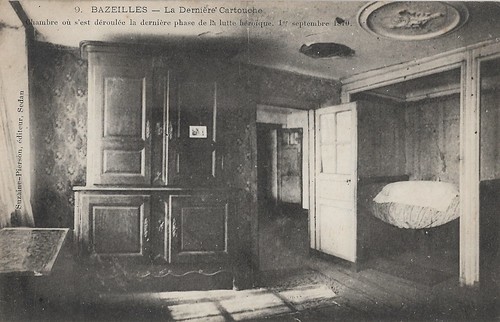
French postcard by Suzaine-Pierson, éditeurs, Sedan, no. 9. Caption: Bazeilles. La Dernière Cartouche (The Last bullet). The room where the last phase of the heroic fight took place, 1 September 1870.
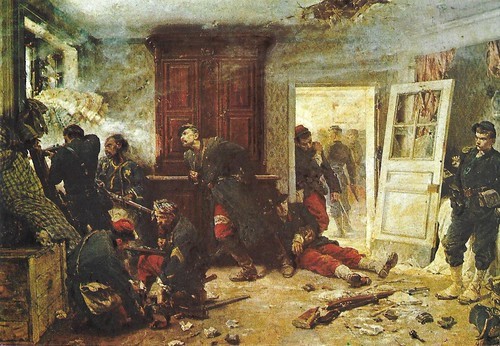
French postcard by Imp. Pierron. Les dernières cartouches (Alphonse de Neuville, 1873).
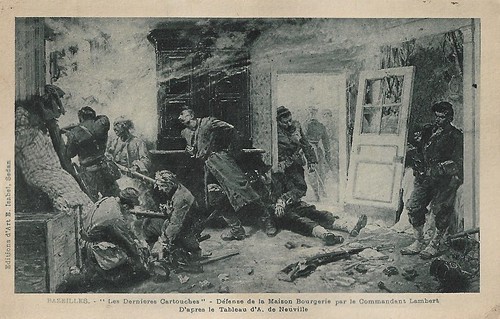
French postcard by Ed. d'Art E. Isabel, Sedan. Early 20th century postcard. Reproduction of Les dernières cartouches (Alphonse de Neuville, 1873). Caption: Defense of the Maison Bourgerie by Commander Lambert. After the painting by A. de Neuville.
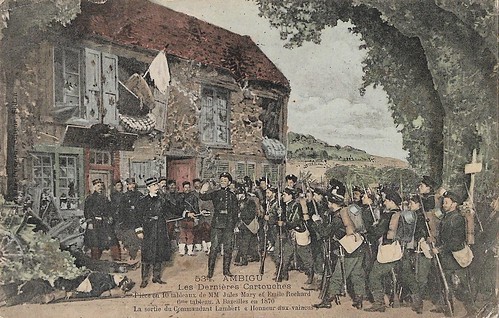
French postcard, no. 534. Caption: 'Les Dernières Cartouches', play in [5 acts and] 10 tableaux by Jules Mary and Emile Rochard. Théâtre de l'Ambigu, Paris. 6th tableau. At Bazeilles in 1870. The exit of commander Lambert. "Honour to the Conquered." On the back, the sender has written "Vieux souvenirs", so sender and the addressee may have fought in the same war. Sent in 1907. Jules Mary published in 1902 a novel entitled 'Les dernières cartouches', which Rochard [and Mary] adapted for the stage. Its first presentation was on 8 February 1903 at the Ambigu theater in Paris.
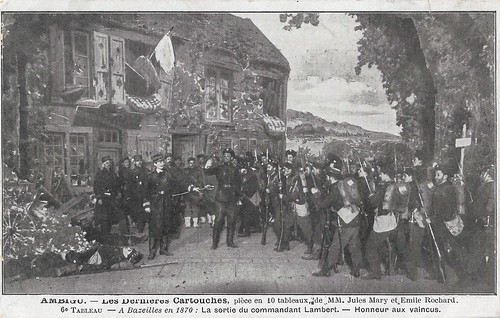
French postcard. Les dernières cartouches. Stage play by Jules Mary et Emile Rochard, based on the famous homonymous painting (1873) by Alphonse de Neuville, on an episode at Bazeilles during the Franco-Prussian War of 1870-1871. It was first performed on 14 January 1903 at the Paris Théâtre de l'Ambigu. Caption: 6th Tableau. At Bazeilles in 1870: The exit of Commander Lambert. Honor to the conquered.
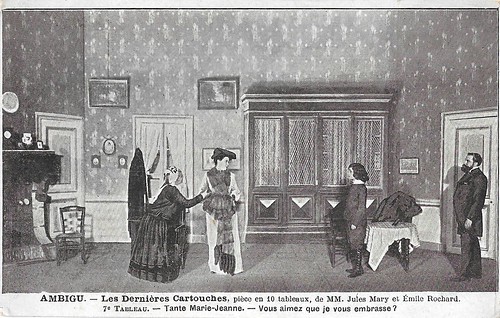
French postcard. Les dernières cartouches. Stage play by Jules Mary et Emile Rochard, based on the famous homonymous painting (1873) by Alphonse de Neuville, on an episode at Bazeilles during the Franco-Prussian War of 1870-71. It was first performed on 14 January 1903 at the Paris Théâtre de l'Ambigu. Caption: 7th Tableau. Tante Marie-Jeanne - Would you like me to embrace you?
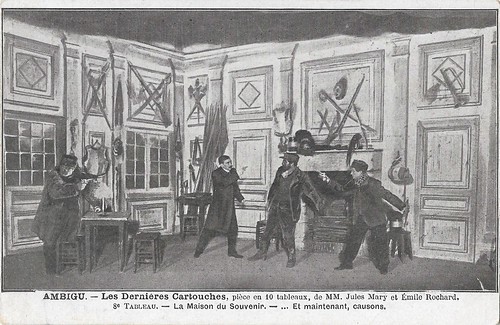
French postcard. Les dernières cartouches. Stage play by Jules Mary et Emile Rochard, based on the famous homonymous painting (1873) by Alphonse de Neuville, on an episode at Bazeilles during the Franco-Prussian War of 1870-1871. It was first performed on 14 January 1903 at the Paris Théâtre de l'Ambigu. Caption: 8th Tableau. The House of Remembrance - ... And now, let's talk.
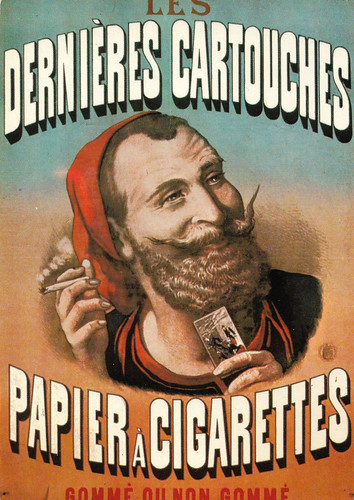
French postcard by Nos publicités, reprint. Ed. F. Nugeron, no. J 18. Caption: Les dernières cartouches. Papier à cigarettes. The historical event of Les dernières cartouches, the site at Bazeilles, and Neuville's painting, all became so popular that all kinds of publicity reused it, here for cigarette paper.
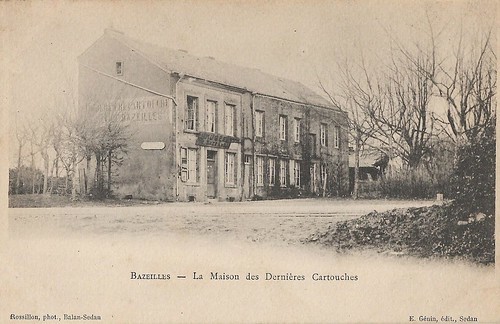
French postcard by Ed. E. Génin, Sedan. Photo: Rossillon, Balan-Sedan. Caption: Bazeilles - La Maison des Dernières Cartouches. On the back, an ink stamp by La Maison des Dernières Cartouches, aka La Maison de la dernière cartouche.
Until the French ran out of bullets
It is at this former inn in Bazeilles, France, at the postcard above, that on 1 September 1870, during the Battle of Sedan, French marines resisted Bavarian troops who besieged them until the French ran out of bullets. Only 15 of the 50 French survived and surrendered. The next day the French Emperor Napoleon III capitulated at Sedan.
The building soon became a site of memory after the Franco-Prussian War of 1870-1871, and its fame increased after the success of Alphonse de Neuville's 1873 painting Les dernières cartouches.
In 1899 the house was bought by the journal Le Gaulois and reopened, but it was only in 1950 that it became an official museum. In 2005 the building got a full restoration.
In 1960 De Neuville's painting was bought at an auction and ever since hangs in the museum in Bazeilles. After a restoration in 2005 by the Musée d'Orsay (where it was also exposed at an exhibition in the same year), it returned to the museum in Bazeilles.
And now the painting is to be seen again at musée d’Orsay in Paris as part of the exhibition 'Enfin le cinéma! Arts, images et spectacles en France (1833-1907)'.
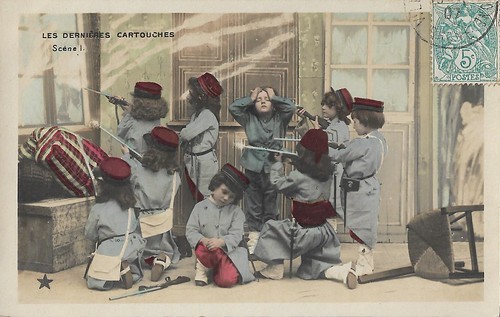
French postcard by Papier Guilleminot, series 768. This postcard was sent by mail in January-March 1907. Caption: Scene I. Children re-enacting the scene from the famous painting 'Les Dernières Cartouches' (1873) by Alphonse de Neuville.
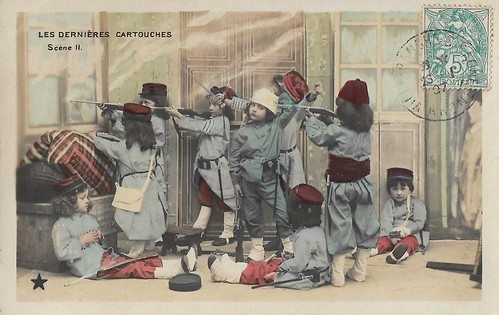
French postcard by Papier Guilleminot, series 768. This postcard was sent by mail in January-March 1907. Caption: Scene II. Children re-enacting the scene from the famous painting 'Les Dernières Cartouches' (1873) by Alphonse de Neuville.
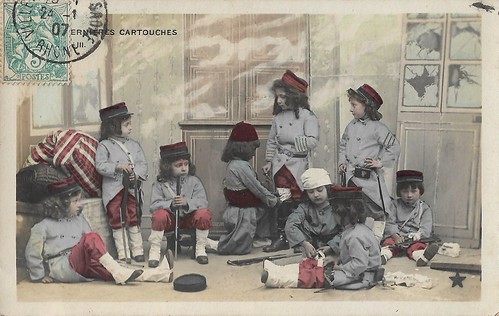
French postcard by Papier Guilleminot, series 768. This postcard was sent by mail in January-March 1907. Caption: Scene III. Children re-enacting the scene from the famous painting 'Les Dernières Cartouches' (1873) by Alphonse de Neuville.
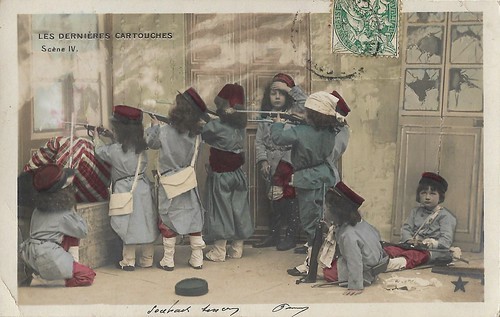
French postcard by Papier Guilleminot, series 768. This postcard was sent by mail in January-March 1907. Caption: Scene IV. Children re-enacting the scene from the famous painting 'Les Dernières Cartouches' (1873) by Alphonse de Neuville.
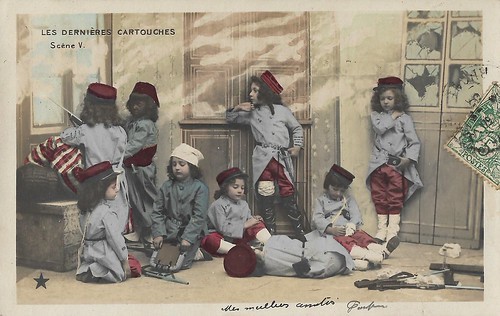
French postcard by Papier Guilleminot, series 768. Caption: Scene V. Children re-enacting the scene from the famous painting 'Les Dernières Cartouches' (1873) by Alphonse de Neuville.
Les dernières cartouches (1897), Pathé version. Source: Films by the year (YouTube).
Bombardement d'une Maison/Les Dernières Cartouches/The last cartridges (1899), George Meliès version. Source: Piso (YouTube).
Source: French Wikipedia.

French postcard by Suzaine-Pierson, éditeurs, Sedan, no. 9. Caption: Bazeilles. La Dernière Cartouche (The Last bullet). The room where the last phase of the heroic fight took place, 1 September 1870.

French postcard by Imp. Pierron. Les dernières cartouches (Alphonse de Neuville, 1873).

French postcard by Ed. d'Art E. Isabel, Sedan. Early 20th century postcard. Reproduction of Les dernières cartouches (Alphonse de Neuville, 1873). Caption: Defense of the Maison Bourgerie by Commander Lambert. After the painting by A. de Neuville.

French postcard, no. 534. Caption: 'Les Dernières Cartouches', play in [5 acts and] 10 tableaux by Jules Mary and Emile Rochard. Théâtre de l'Ambigu, Paris. 6th tableau. At Bazeilles in 1870. The exit of commander Lambert. "Honour to the Conquered." On the back, the sender has written "Vieux souvenirs", so sender and the addressee may have fought in the same war. Sent in 1907. Jules Mary published in 1902 a novel entitled 'Les dernières cartouches', which Rochard [and Mary] adapted for the stage. Its first presentation was on 8 February 1903 at the Ambigu theater in Paris.

French postcard. Les dernières cartouches. Stage play by Jules Mary et Emile Rochard, based on the famous homonymous painting (1873) by Alphonse de Neuville, on an episode at Bazeilles during the Franco-Prussian War of 1870-1871. It was first performed on 14 January 1903 at the Paris Théâtre de l'Ambigu. Caption: 6th Tableau. At Bazeilles in 1870: The exit of Commander Lambert. Honor to the conquered.

French postcard. Les dernières cartouches. Stage play by Jules Mary et Emile Rochard, based on the famous homonymous painting (1873) by Alphonse de Neuville, on an episode at Bazeilles during the Franco-Prussian War of 1870-71. It was first performed on 14 January 1903 at the Paris Théâtre de l'Ambigu. Caption: 7th Tableau. Tante Marie-Jeanne - Would you like me to embrace you?

French postcard. Les dernières cartouches. Stage play by Jules Mary et Emile Rochard, based on the famous homonymous painting (1873) by Alphonse de Neuville, on an episode at Bazeilles during the Franco-Prussian War of 1870-1871. It was first performed on 14 January 1903 at the Paris Théâtre de l'Ambigu. Caption: 8th Tableau. The House of Remembrance - ... And now, let's talk.

French postcard by Nos publicités, reprint. Ed. F. Nugeron, no. J 18. Caption: Les dernières cartouches. Papier à cigarettes. The historical event of Les dernières cartouches, the site at Bazeilles, and Neuville's painting, all became so popular that all kinds of publicity reused it, here for cigarette paper.

French postcard by Ed. E. Génin, Sedan. Photo: Rossillon, Balan-Sedan. Caption: Bazeilles - La Maison des Dernières Cartouches. On the back, an ink stamp by La Maison des Dernières Cartouches, aka La Maison de la dernière cartouche.
Until the French ran out of bullets
It is at this former inn in Bazeilles, France, at the postcard above, that on 1 September 1870, during the Battle of Sedan, French marines resisted Bavarian troops who besieged them until the French ran out of bullets. Only 15 of the 50 French survived and surrendered. The next day the French Emperor Napoleon III capitulated at Sedan.
The building soon became a site of memory after the Franco-Prussian War of 1870-1871, and its fame increased after the success of Alphonse de Neuville's 1873 painting Les dernières cartouches.
In 1899 the house was bought by the journal Le Gaulois and reopened, but it was only in 1950 that it became an official museum. In 2005 the building got a full restoration.
In 1960 De Neuville's painting was bought at an auction and ever since hangs in the museum in Bazeilles. After a restoration in 2005 by the Musée d'Orsay (where it was also exposed at an exhibition in the same year), it returned to the museum in Bazeilles.
And now the painting is to be seen again at musée d’Orsay in Paris as part of the exhibition 'Enfin le cinéma! Arts, images et spectacles en France (1833-1907)'.

French postcard by Papier Guilleminot, series 768. This postcard was sent by mail in January-March 1907. Caption: Scene I. Children re-enacting the scene from the famous painting 'Les Dernières Cartouches' (1873) by Alphonse de Neuville.

French postcard by Papier Guilleminot, series 768. This postcard was sent by mail in January-March 1907. Caption: Scene II. Children re-enacting the scene from the famous painting 'Les Dernières Cartouches' (1873) by Alphonse de Neuville.

French postcard by Papier Guilleminot, series 768. This postcard was sent by mail in January-March 1907. Caption: Scene III. Children re-enacting the scene from the famous painting 'Les Dernières Cartouches' (1873) by Alphonse de Neuville.

French postcard by Papier Guilleminot, series 768. This postcard was sent by mail in January-March 1907. Caption: Scene IV. Children re-enacting the scene from the famous painting 'Les Dernières Cartouches' (1873) by Alphonse de Neuville.

French postcard by Papier Guilleminot, series 768. Caption: Scene V. Children re-enacting the scene from the famous painting 'Les Dernières Cartouches' (1873) by Alphonse de Neuville.
Les dernières cartouches (1897), Pathé version. Source: Films by the year (YouTube).
Bombardement d'une Maison/Les Dernières Cartouches/The last cartridges (1899), George Meliès version. Source: Piso (YouTube).
Source: French Wikipedia.
Published on September 26, 2021 22:00
September 25, 2021
Directed by Quentin Tarantino
American director, screenwriter, actor & producer Quentin Tarantino (1963) was the most distinctive and volatile talent to emerge in American cinema in the 1990s. Tarantino learned his craft from his days as a video clerk at Video Archives in Manhattan Beach, CA. He developed a fusion of pop culture and independent arthouse cinema. With Pulp Fiction (1994), he won the Palme d'Or for best film at the Cannes Film Festival. He also won the Oscar for Best Original Screenplay, in addition to nominations for Best Picture and Best Director. Inglourious Basterds (2009) also received Oscar nominations for Best Picture, Best Director, and Best Original Screenplay. He won his second Oscar for the screenplay of Django Unchained (2012).
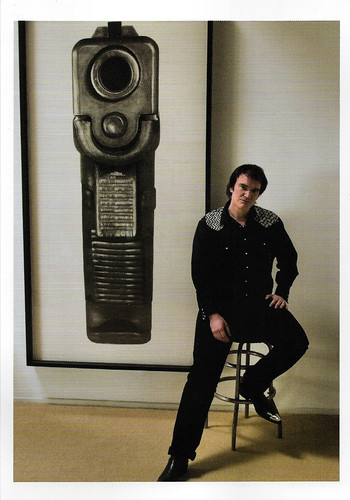
French postcard by La Cinémathèque française. Photo: Dennis Hopper. Caption: Quentin Tarantino for Robert Longo's work Bodyhammer Glock, 2006.
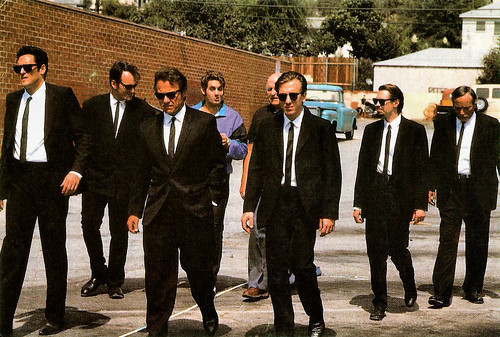
Spanish postcard by Record Vision / Ballantine's / Cine Company. Photo: Michael Madsen as Mr. Blonde, Quentin Tarantino as Mr. Brown, Harvey Keitel as Mr. White, Chris Penn as 'Nice Guy' Eddie, Lawrence Tierney as Joe Cabot, Tim Roth as Mr. Orange, Steve Buscemi as Mr. Pink and Edward Bunker as Mr. Blue in Reservoir Dogs (Quentin Tarantino, 1992). Caption: Picture of the family: the Reservoir Dogs complete. They are seven gangsters who only know each other by their nicknames. Reunited in a robbery, they are held in check by the cops. There is only one certainty, and that is that someone has betrayed them.
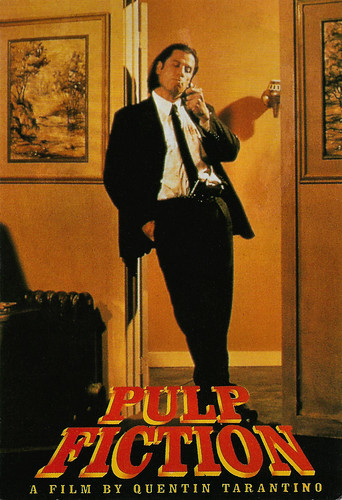
French postcard, no. C 583. John Travolta in Pulp Fiction (Quentin Tarantino, 1994).
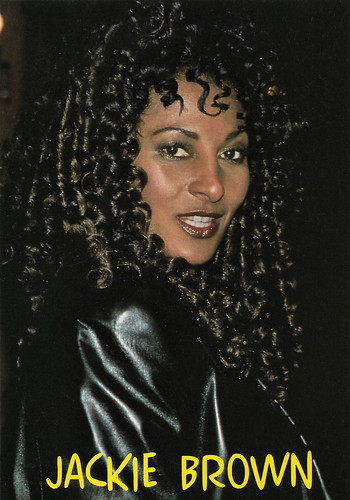
British postcard by Heroes Publishing LTD, London, no. SFC 3308. Pam Grier in Jackie Brown (Quentin Tarantino, 1997).
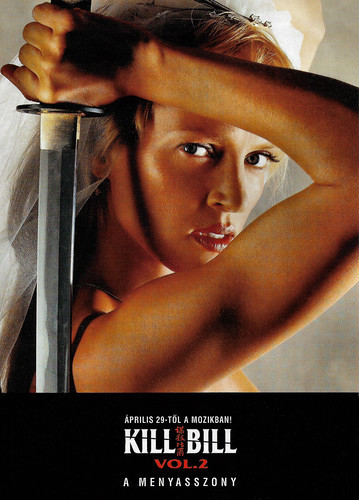
Hungarian postcard by Est Media, Budapest. Uma Thurman as The Bride in Kill Bill, Vol. 2 (Quentin Tarantino, 2004). Caption: Aprilis 29 - Töl a Mozikban. (In the cinema from 29 April).
A Neo-Noir about a failed heist
Quentin Jerome Tarantino was born in Knoxville, Tennesse, in 1963. He was the only child of Connie McHugh and aspiring actor Tony Tarantino, who left the family before his son's birth. Quentin grew up in Los Angeles, and his stepfather Curtis Zastoupil encouraged Tarantino's love of cinema.
The summer after his 15th birthday, Tarantino was grounded by his mother for shoplifting Elmore Leonard's novel 'The Switch' from Kmart. He was allowed to leave only to attend the Torrance Community Theater, where he participated in such plays as 'Two Plus Two Makes Sex' and 'Romeo and Juliet'. Later, Tarantino attended acting classes at the James Best Theatre Company, where he met several of his eventual collaborators.
During his five years at Video Archives, he began writing screenplays. In 1987, he completed his first, True Romance, with his co-worker, Roger Avary who would later also become a director. Tarantino tried to get financial backing to film the script. After years of negotiations, he decided to sell the script, which wound up in the hands of director Tony Scott.
During this time, Tarantino wrote the screenplay for Natural Born Killers. Again, he was unable to come up with enough investors to make a film and gave the script to his partner, Rand Vossler. Tarantino then used the money he made from True Romance to begin pre-production on Reservoir Dogs, a Neo-Noir about a failed heist. Reservoir Dogs received financial backing from LIVE Entertainment (now Lionsgate) after Harvey Keitel agreed to star in the film.
Word-of-mouth on Reservoir Dogs (Quentin Tarantino, 1992) began to build at the 1992 Sundance Film Festival, which led to scores of glowing reviews, making the film a cult hit. While many critics and fans were praising Tarantino, he developed a sizable number of detractors. Claiming he ripped off the obscure Hong Kong thriller Lung foo fung wan/City on Fire (Ringo Lam, 1987), the critics only added to the director/writer's already considerable buzz. In 1993, Tarantino wrote and directed his next feature, Pulp Fiction, which featured three interweaving crime storylines. The big-budget production True Romance (Tony Scott, 1993) was also released that year.
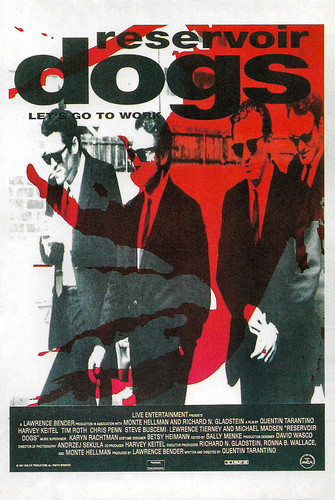
British postcard, no. PC0457. Photo: poster for Reservoir Dogs (Quentin Tarantino, 1992). Caption: Let's go to work.
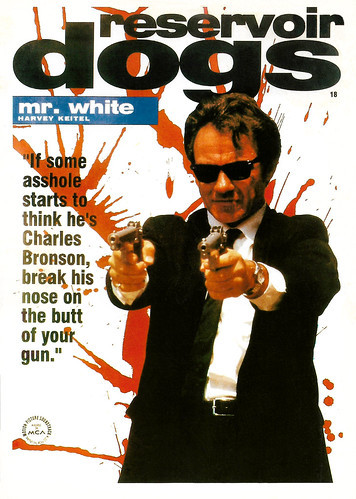
British postcard, no. C050. Harvey Keitel as Mr. White Reservoir Dogs (Quentin Tarantino, 1992). Caption: "If some asshole starts to think he is Charles Bronson break his nose on the butt of your gun."
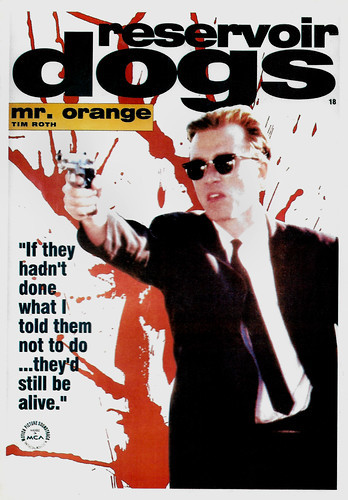
British postcard, no. C049. Photo: Tim Roth as Mr. Orange in Reservoir Dogs (Quentin Tarantino, 1992). Caption: Mr. Orange. "If they hadn't done what I told them not to do... they'd still be alive."
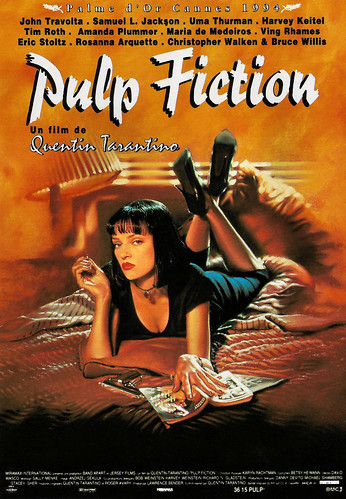
French postcard by Sonis, no. C. 492. Photo: Bac Films. Uma Thurman on the French poster for Pulp Fiction (Quentin Tarantino, 1994). Caption: Affiche du film.
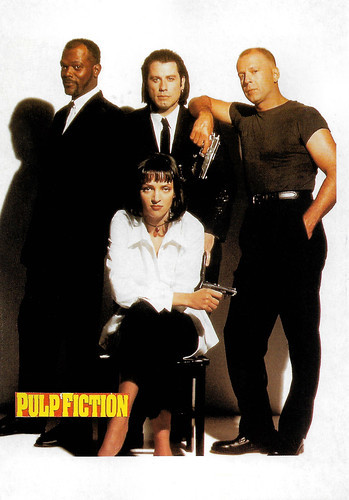
British postcard by Memory Card, no. 78. Samuel Jackson, John Travolta , Bruce Willis, and Uma Thurman in Pulp Fiction (Quentin Tarantino, 1994). Caption: lobby card.

American postcard by Buena Vista Pictures Distribution. Photo: Touchstone Home Video. Bruce Willis in Pulp Fiction (Quentin Tarantino, 1994). Caption: "He was dead before he ever stepped into the ring." The Boxer.
An homage to the blaxploitation films of the 1970s
In 1994, Quentin Tarantino was elevated from a cult figure to a major celebrity. Pulp Fiction (Quentin Tarantino, 1994) won the Palme d'Or at the Cannes Film Festival, beginning the flood of good reviews. Before Pulp Fiction was released, Oliver Stone's bombastic version of Natural Born Killers (1994) hit the theatres. Tarantino distanced himself from the film and was only credited for writing the basic story. Pulp Fiction soon eclipsed Natural Born Killers in both acclaim and popularity.
Made for eight million dollars, the film eventually grossed over 100 million dollars and topped many critics' top ten lists. Pulp Fiction earned seven Oscar nominations, including Best Picture, Best Director, Best Original Screenplay (Tarantino and Avary), Best Actor ( John Travolta ), Best Supporting Actor (Samuel L. Jackson), and Best Supporting Actress ( Uma Thurman ). It won one, for Tarantino and Avery's writing.
After the film's success, Tarantino was everywhere, from talk shows to a cameo in the low-budget Sleep With Me (Rory Kelly, 1994). He directed a segment of the anthology film Four Rooms (Allison Anders, Alexandre Rockwell, Robert Rodriguez, Quentin Tarantino, Chuck Jones, 1995) and acted in Robert Rodriguez's sequel to El Mariachi (Robert Rodriguez, 1992), Desperado (Robert Rodriguez, 1995), and the comedy Destiny Turns on the Radio (Jack Baran, 1995), in which he had a starring role. Tarantino also kept busy with television, directing an episode of the NBC TV hit ER (1995) and appearing in Margaret Cho's sitcom All-American Girl (Terry Hughes, 1995).
The latter half of the 1990s saw Tarantino continue his multifaceted role as an actor, director, screenwriter, and producer. In 1996, he served as the screenwriter and executive producer for the George Clooney schlock-fest From Dusk Till Dawn (Robert Rodriguez, 1996).
The following year he renewed some of his earlier acclaims as the director and screenwriter of Jackie Brown (Quentin Tarantino, 1997), an homage to the blaxploitation films of the 1970s. The film was an adaptation of Elmore Leonard's novel 'Rum Punch'. It won him the raves that had been missing for much of his post-Fiction career. In 1999, he was back behind the camera as the producer for From Dusk Till Dawn 2: Texas Blood Money (Scott Spiegel, 1999).
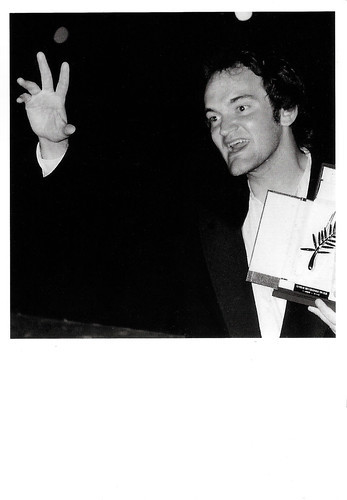
French postcard by Editions Cahiers du Cinéma, Paris, 1997. Photo: Traverso. Caption: Quentin Tarantino, Festival de Cannes 1994.
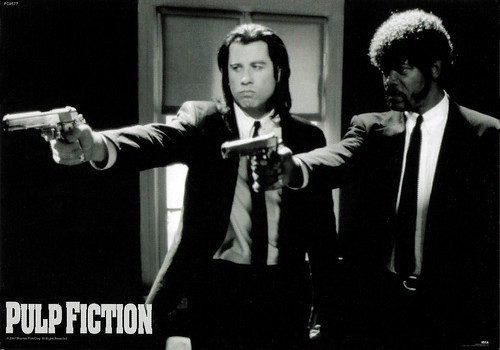
British postcard by Pyramid Posters, Leicester, no. PC9577. Photo: Miramax Film Corp. John Travolta and Samuel Jackson in Pulp Fiction (Quentin Tarantino, 1994). Caption: Guns B&W.

Vintage postcard, no. PP 137. Photo: George Clooney and Quentin Tarantino in From Dusk Till Dawn (Robert Rodriguez, 1996).
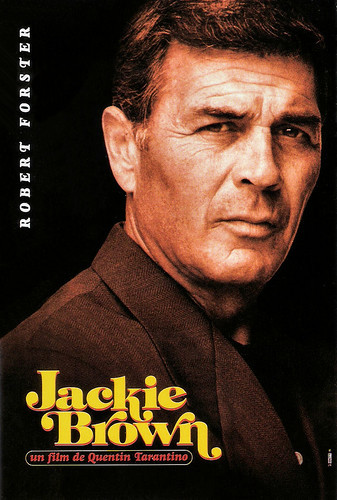
French promotion card by BacFilms. Robert Forster in Jackie Brown (Quentin Tarantino, 1997).
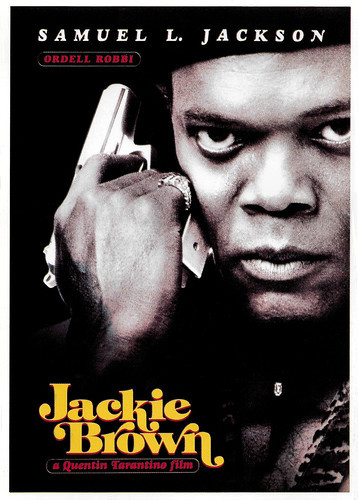
French postcard, no. 655. Samuel L. Jackson as Ordell Robbi in Jackie Brown (Quentin Tarantino, 1997).
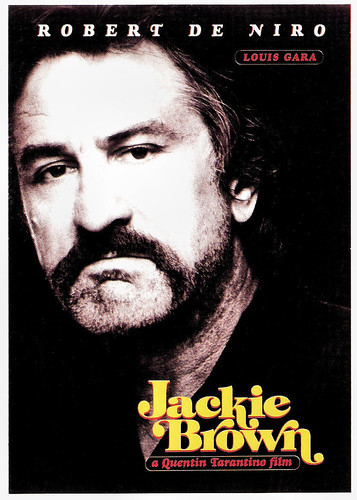
French postcard, no. 654. Photo: Robert De Niro as Louis Gara Jackie Brown (Quentin Tarantino, 1997).
A story simply too far-reaching to be contained in a single film
Quentin Tarantino laid relatively low in the early years of the new millennium. In late 2002, the hype started to build around his fourth feature, Kill Bill (Quentin Tarantino, 2003). Though originally envisioned to be a single release, Kill Bill was eventually separated into two films entitled Kill Bill Vol. 1 (2003) and Kill Bill Vol. 2 (2004) when it became obvious that the story was simply too far-reaching to be contained in a single film.
A kinetic homage to revenge movies of the 1970s, Kill Bill Vol. 1 featured Uma Thurman as a former assassin known as 'The Bride'. While the first film in the pair was an eye-popping homage to Asian cinema and all things extreme, the outrageous violence of Kill Bill Vol. 1 stood in stark contrast to the dialogue-driven second installment that concluded the epic tale of revenge and betrayal.
The gambit of separate releases paid off, as both earned a combined sum of more than 130 million dollars domestically. In the wake of the Kill Bill films, rumors abounded concerning Tarantino's next feature. In 2005, Tarantino did step back into the director's chair to helm a segment of Robert Rodriguez's eagerly anticipated comic book adaptation Sin City (Frank Miller, Quentin Tarantino (special guest director), Robert Rodriguez, 2005). A longtime friend of Rodriguez, Tarantino agreed to take part in the filming of Sin City , not only to repay the versatile filmmaker for providing soundtrack music for the Kill Bill films but also to try his hand at digital filmmaking.
Stephen Thomas Erlewine at AllMovie : "After this, the two directors joined forces again, for one of the most ballyhooed and hotly anticipated pictures of 2007: Grindhouse (Robert Rodriguez, Eli Roth, Quentin Tarantino, 2007). A no-holds-barred elegy to the sleazy, seedy, often half-dilapidated inner-city theaters of the 1970s that would churn out similarly sleazy movies, Tarantino and Rodriguez divided Grindhouse into two portions: the first half, Death Proof (2007), directed by Tarantino, starred Kurt Russell in homage to the high-octane auto thrillers of the '70s.
Merging low-brow thrills with blunt, existential dialogue, the Tarantino segment garnered the lion's share of the film's considerable critical praise, although the three-hour-plus Grindhouse ultimately failed to connect with audiences, much to the dismay of The Weinstein Company, who released it." Separate versions of Death Proof (Qunetin Tarantino, 2007) and Planet Terror (Robert Rodriquez, 1997) were then prepped for European release, with Tarantino's effort screened in competition at the 2007 Cannes Film Festival.
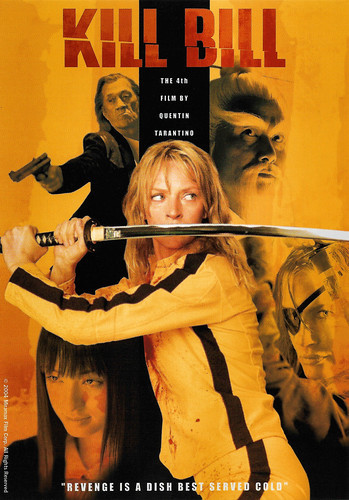
British postcard by Pyramid Posters, Leicester, no. PC 9471. Photo: Miramax Films / A Band Apart. Uma Thurman (montage) in Kill Bill (Quentin Tarantino, 2003). Caption: The 4th film by Quentin Tarantino. "Revenge is a dish best served cold".
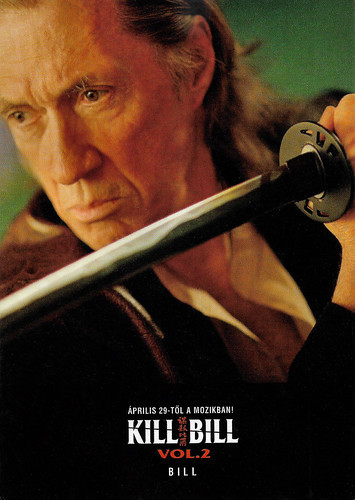
Hungarian postcard by Est Media, Budapest. David Carradine as Bill in Kill Bill, Vol. 2 (Quentin Tarantino, 2004). Caption: Aprilis 29 - Töl a Mozikban. (In the cinema from 29 April).
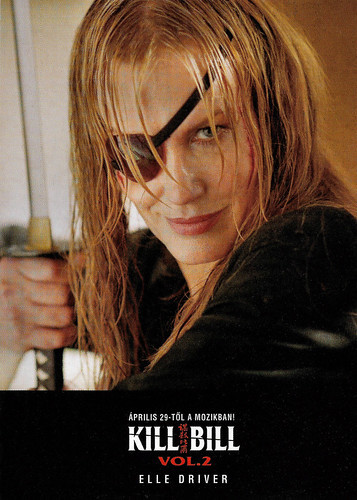
Hungarian postcard by Est Media, Budapest. Daryl Hannah as Elle Driver in Kill Bill, Vol. 2 (Quentin Tarantino, 2004). Caption: Aprilis 29 - Töl a Mozikban. (In the cinema from 29 April).
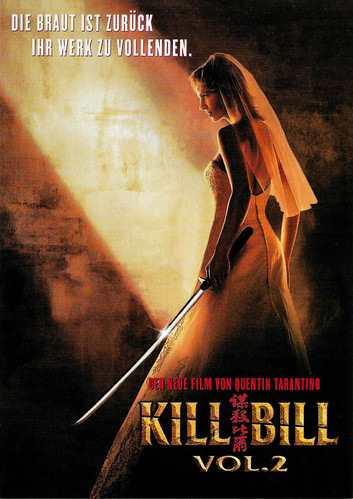
German postcard by Edgar Medien. Photo: Buena Vista International. Uma Thurman in Kill Bill: Vol. 2 (Quentin Tarantino, 2004). Caption: The bride is back to finish her work.
A viscerally bloody, chronologically fractured whodunit full of betrayal and biting wit
In 2009 Quentin Tarantino issued Inglorious Basterds, a sprawling World War II epic about a band of Jewish American soldiers fighting an Apache resistance behind enemy lines in Nazi-occupied France. The film, starring Brad Pitt , was a hit around the world and garnered Tarantino nominations from the Writers Guild, the Directors Guild, the Hollywood Foreign Press, and the Academy for his screenplay and his direction.
He took three years to craft his follow-up, the revisionist Western Django Unchained (Quentin Tarantino, 2012), a film about the revenge of a former slave (Jamie Foxx) in the U.S. South in 1858. The slave teams up with a bounty hunter (Christoph Waltz) to get his wife away from a sadistic plantation owner ( Leonardo DiCaprio ). Django Unchained was another international box office hit, grossing over $425 million worldwide against its $100 million budget, becoming Tarantino's highest-grossing movie to date. It also earned a number of year-end awards including a second Best Original Screenplay Oscar for Tarantino.
Tarantino's eighth film was the Western The Hateful Eight (Quentin Tarantino 2015), starring Samuel L. Jackson, Kurt Russell, Jennifer Jason Leigh, Walton Goggins, Demián Bichir, Tim Roth, Michael Madsen, and Bruce Dern, as eight strangers who seek refuge from a blizzard in a stagecoach stopover sometime after the American Civil War. The original score was Italian composer Ennio Morricone's first and only for a Tarantino film, his first complete Western score in thirty-four years.
Daniel Gelb at AllMovie : "It's a viscerally bloody, chronologically fractured whodunit full of betrayal and biting wit. It's profane, protracted, violent, and yet another achievement in a career full of inspired filmmaking. After teasing what he could do with the Western genre in the good but not great Django Unchained, Tarantino's second consecutive Civil War-era picture is a fully realized epic. (...) Despite its three-hour runtime, its hold on the audience's attention never wavers. Tarantino's trademark dialogue (never known for its brevity) keeps us riveted inside Minnie's Haberdashery, and the stellar cast manages to bring out the deadpan hilarity in the script."
Tarantino's ninth film, Once Upon a Time in Hollywood (Quentin Tarantino, 2019), turned out to be one of his best. It recounts an alternate history of events surrounding the Tate–LaBianca murders in 1969, and Leonard DiCaprio and Brad Pitt star as a fading actor and his stuntman. Providing a sense of intrigue during the long 161-minute runtime, the epic weaves in and out of tense moments and comedic relief.
Travis Norris at AllMovie : "Hollywood is a great behind-the-scenes look into the end of an era. The film touches on the pursuit of perfection: how it is never obtainable yet always worth striving for. These are words that seem to drive Tarantino, and it is apparent while watching a film like this. A fun and genuine ride, Once Upon a Time… in Hollywood is a must-see." The film earned 10 Academy Award nominations and won best supporting actor for Brad Pitt and best production design.
Since 20018, Quentin Tarantino is married to Israelian singer Daniella Pick. In June 2021, the director confirmed his plans to retire after his tenth film on the TV show Real Time With Bill Maher on which he appeared to promote his novel 'Once Upon a Time in Hollywood', based on his ninth film of the same name. He believes it is better to bid adieu when one is at their peak. But what will Quentin Tarantino's final film be?

German postcard by Edgar Medien AG, no. 6.689. Image: Buena Vista / Miramax. Rosario Dawson in Sin City (Frank Miller, Quentin Tarantino (special guest director), Robert Rodriguez, 2005). Caption: Shall we go to me?
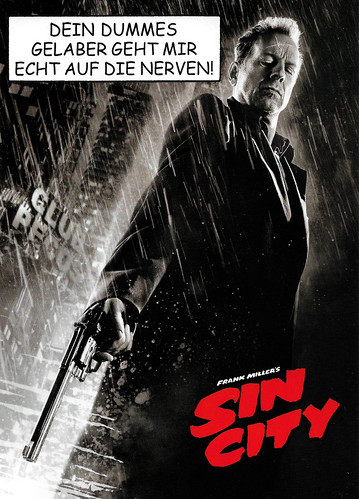
German postcard by Edgar Medien AG, no. 7.687. Image: Buena Vista / Miramax. Bruce Willis in Sin City (Frank Miller, Quentin Tarantino (special guest director), Robert Rodriguez, 2005). Caption: Your stupid talk really gets on my nerves!
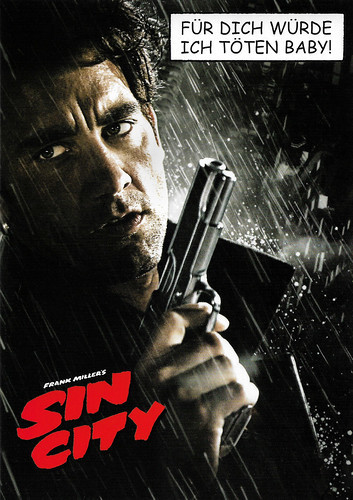
German postcard by Edgar Medien AG, no. 7.690. Image: Buena Vista / Miramax. Clive Owen in Sin City (Frank Miller, Quentin Tarantino (special guest director), Robert Rodriguez, 2005). Caption: For you, I will kill, baby!
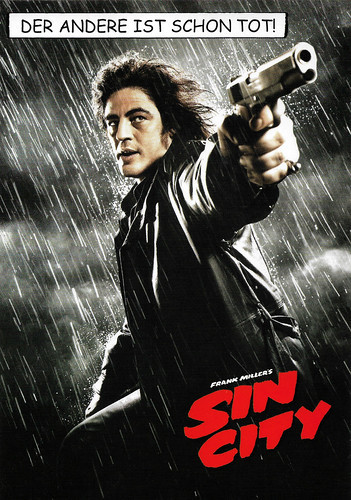
German postcard by Edgar Medien AG, no. 7.692. Image: Buena Vista / Miramax. Benicio Del Toro in Sin City (Frank Miller, Quentin Tarantino (special guest director), Robert Rodriguez, 2005). Caption: The other one is already dead!
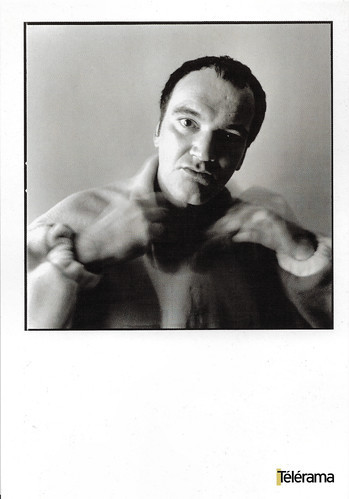
French postcard by Télérama 'l'hebdomadaire culturel français'. Photo: Patrick Swirc / Télérama.
Sources: Stephen Thomas Erlewine (AllMovie), Daniel Gelb (AllMovie), Travis Norris (AllMovie), Wikipedia, and .

French postcard by La Cinémathèque française. Photo: Dennis Hopper. Caption: Quentin Tarantino for Robert Longo's work Bodyhammer Glock, 2006.

Spanish postcard by Record Vision / Ballantine's / Cine Company. Photo: Michael Madsen as Mr. Blonde, Quentin Tarantino as Mr. Brown, Harvey Keitel as Mr. White, Chris Penn as 'Nice Guy' Eddie, Lawrence Tierney as Joe Cabot, Tim Roth as Mr. Orange, Steve Buscemi as Mr. Pink and Edward Bunker as Mr. Blue in Reservoir Dogs (Quentin Tarantino, 1992). Caption: Picture of the family: the Reservoir Dogs complete. They are seven gangsters who only know each other by their nicknames. Reunited in a robbery, they are held in check by the cops. There is only one certainty, and that is that someone has betrayed them.

French postcard, no. C 583. John Travolta in Pulp Fiction (Quentin Tarantino, 1994).

British postcard by Heroes Publishing LTD, London, no. SFC 3308. Pam Grier in Jackie Brown (Quentin Tarantino, 1997).

Hungarian postcard by Est Media, Budapest. Uma Thurman as The Bride in Kill Bill, Vol. 2 (Quentin Tarantino, 2004). Caption: Aprilis 29 - Töl a Mozikban. (In the cinema from 29 April).
A Neo-Noir about a failed heist
Quentin Jerome Tarantino was born in Knoxville, Tennesse, in 1963. He was the only child of Connie McHugh and aspiring actor Tony Tarantino, who left the family before his son's birth. Quentin grew up in Los Angeles, and his stepfather Curtis Zastoupil encouraged Tarantino's love of cinema.
The summer after his 15th birthday, Tarantino was grounded by his mother for shoplifting Elmore Leonard's novel 'The Switch' from Kmart. He was allowed to leave only to attend the Torrance Community Theater, where he participated in such plays as 'Two Plus Two Makes Sex' and 'Romeo and Juliet'. Later, Tarantino attended acting classes at the James Best Theatre Company, where he met several of his eventual collaborators.
During his five years at Video Archives, he began writing screenplays. In 1987, he completed his first, True Romance, with his co-worker, Roger Avary who would later also become a director. Tarantino tried to get financial backing to film the script. After years of negotiations, he decided to sell the script, which wound up in the hands of director Tony Scott.
During this time, Tarantino wrote the screenplay for Natural Born Killers. Again, he was unable to come up with enough investors to make a film and gave the script to his partner, Rand Vossler. Tarantino then used the money he made from True Romance to begin pre-production on Reservoir Dogs, a Neo-Noir about a failed heist. Reservoir Dogs received financial backing from LIVE Entertainment (now Lionsgate) after Harvey Keitel agreed to star in the film.
Word-of-mouth on Reservoir Dogs (Quentin Tarantino, 1992) began to build at the 1992 Sundance Film Festival, which led to scores of glowing reviews, making the film a cult hit. While many critics and fans were praising Tarantino, he developed a sizable number of detractors. Claiming he ripped off the obscure Hong Kong thriller Lung foo fung wan/City on Fire (Ringo Lam, 1987), the critics only added to the director/writer's already considerable buzz. In 1993, Tarantino wrote and directed his next feature, Pulp Fiction, which featured three interweaving crime storylines. The big-budget production True Romance (Tony Scott, 1993) was also released that year.

British postcard, no. PC0457. Photo: poster for Reservoir Dogs (Quentin Tarantino, 1992). Caption: Let's go to work.

British postcard, no. C050. Harvey Keitel as Mr. White Reservoir Dogs (Quentin Tarantino, 1992). Caption: "If some asshole starts to think he is Charles Bronson break his nose on the butt of your gun."

British postcard, no. C049. Photo: Tim Roth as Mr. Orange in Reservoir Dogs (Quentin Tarantino, 1992). Caption: Mr. Orange. "If they hadn't done what I told them not to do... they'd still be alive."

French postcard by Sonis, no. C. 492. Photo: Bac Films. Uma Thurman on the French poster for Pulp Fiction (Quentin Tarantino, 1994). Caption: Affiche du film.

British postcard by Memory Card, no. 78. Samuel Jackson, John Travolta , Bruce Willis, and Uma Thurman in Pulp Fiction (Quentin Tarantino, 1994). Caption: lobby card.

American postcard by Buena Vista Pictures Distribution. Photo: Touchstone Home Video. Bruce Willis in Pulp Fiction (Quentin Tarantino, 1994). Caption: "He was dead before he ever stepped into the ring." The Boxer.
An homage to the blaxploitation films of the 1970s
In 1994, Quentin Tarantino was elevated from a cult figure to a major celebrity. Pulp Fiction (Quentin Tarantino, 1994) won the Palme d'Or at the Cannes Film Festival, beginning the flood of good reviews. Before Pulp Fiction was released, Oliver Stone's bombastic version of Natural Born Killers (1994) hit the theatres. Tarantino distanced himself from the film and was only credited for writing the basic story. Pulp Fiction soon eclipsed Natural Born Killers in both acclaim and popularity.
Made for eight million dollars, the film eventually grossed over 100 million dollars and topped many critics' top ten lists. Pulp Fiction earned seven Oscar nominations, including Best Picture, Best Director, Best Original Screenplay (Tarantino and Avary), Best Actor ( John Travolta ), Best Supporting Actor (Samuel L. Jackson), and Best Supporting Actress ( Uma Thurman ). It won one, for Tarantino and Avery's writing.
After the film's success, Tarantino was everywhere, from talk shows to a cameo in the low-budget Sleep With Me (Rory Kelly, 1994). He directed a segment of the anthology film Four Rooms (Allison Anders, Alexandre Rockwell, Robert Rodriguez, Quentin Tarantino, Chuck Jones, 1995) and acted in Robert Rodriguez's sequel to El Mariachi (Robert Rodriguez, 1992), Desperado (Robert Rodriguez, 1995), and the comedy Destiny Turns on the Radio (Jack Baran, 1995), in which he had a starring role. Tarantino also kept busy with television, directing an episode of the NBC TV hit ER (1995) and appearing in Margaret Cho's sitcom All-American Girl (Terry Hughes, 1995).
The latter half of the 1990s saw Tarantino continue his multifaceted role as an actor, director, screenwriter, and producer. In 1996, he served as the screenwriter and executive producer for the George Clooney schlock-fest From Dusk Till Dawn (Robert Rodriguez, 1996).
The following year he renewed some of his earlier acclaims as the director and screenwriter of Jackie Brown (Quentin Tarantino, 1997), an homage to the blaxploitation films of the 1970s. The film was an adaptation of Elmore Leonard's novel 'Rum Punch'. It won him the raves that had been missing for much of his post-Fiction career. In 1999, he was back behind the camera as the producer for From Dusk Till Dawn 2: Texas Blood Money (Scott Spiegel, 1999).

French postcard by Editions Cahiers du Cinéma, Paris, 1997. Photo: Traverso. Caption: Quentin Tarantino, Festival de Cannes 1994.

British postcard by Pyramid Posters, Leicester, no. PC9577. Photo: Miramax Film Corp. John Travolta and Samuel Jackson in Pulp Fiction (Quentin Tarantino, 1994). Caption: Guns B&W.

Vintage postcard, no. PP 137. Photo: George Clooney and Quentin Tarantino in From Dusk Till Dawn (Robert Rodriguez, 1996).

French promotion card by BacFilms. Robert Forster in Jackie Brown (Quentin Tarantino, 1997).

French postcard, no. 655. Samuel L. Jackson as Ordell Robbi in Jackie Brown (Quentin Tarantino, 1997).

French postcard, no. 654. Photo: Robert De Niro as Louis Gara Jackie Brown (Quentin Tarantino, 1997).
A story simply too far-reaching to be contained in a single film
Quentin Tarantino laid relatively low in the early years of the new millennium. In late 2002, the hype started to build around his fourth feature, Kill Bill (Quentin Tarantino, 2003). Though originally envisioned to be a single release, Kill Bill was eventually separated into two films entitled Kill Bill Vol. 1 (2003) and Kill Bill Vol. 2 (2004) when it became obvious that the story was simply too far-reaching to be contained in a single film.
A kinetic homage to revenge movies of the 1970s, Kill Bill Vol. 1 featured Uma Thurman as a former assassin known as 'The Bride'. While the first film in the pair was an eye-popping homage to Asian cinema and all things extreme, the outrageous violence of Kill Bill Vol. 1 stood in stark contrast to the dialogue-driven second installment that concluded the epic tale of revenge and betrayal.
The gambit of separate releases paid off, as both earned a combined sum of more than 130 million dollars domestically. In the wake of the Kill Bill films, rumors abounded concerning Tarantino's next feature. In 2005, Tarantino did step back into the director's chair to helm a segment of Robert Rodriguez's eagerly anticipated comic book adaptation Sin City (Frank Miller, Quentin Tarantino (special guest director), Robert Rodriguez, 2005). A longtime friend of Rodriguez, Tarantino agreed to take part in the filming of Sin City , not only to repay the versatile filmmaker for providing soundtrack music for the Kill Bill films but also to try his hand at digital filmmaking.
Stephen Thomas Erlewine at AllMovie : "After this, the two directors joined forces again, for one of the most ballyhooed and hotly anticipated pictures of 2007: Grindhouse (Robert Rodriguez, Eli Roth, Quentin Tarantino, 2007). A no-holds-barred elegy to the sleazy, seedy, often half-dilapidated inner-city theaters of the 1970s that would churn out similarly sleazy movies, Tarantino and Rodriguez divided Grindhouse into two portions: the first half, Death Proof (2007), directed by Tarantino, starred Kurt Russell in homage to the high-octane auto thrillers of the '70s.
Merging low-brow thrills with blunt, existential dialogue, the Tarantino segment garnered the lion's share of the film's considerable critical praise, although the three-hour-plus Grindhouse ultimately failed to connect with audiences, much to the dismay of The Weinstein Company, who released it." Separate versions of Death Proof (Qunetin Tarantino, 2007) and Planet Terror (Robert Rodriquez, 1997) were then prepped for European release, with Tarantino's effort screened in competition at the 2007 Cannes Film Festival.

British postcard by Pyramid Posters, Leicester, no. PC 9471. Photo: Miramax Films / A Band Apart. Uma Thurman (montage) in Kill Bill (Quentin Tarantino, 2003). Caption: The 4th film by Quentin Tarantino. "Revenge is a dish best served cold".

Hungarian postcard by Est Media, Budapest. David Carradine as Bill in Kill Bill, Vol. 2 (Quentin Tarantino, 2004). Caption: Aprilis 29 - Töl a Mozikban. (In the cinema from 29 April).

Hungarian postcard by Est Media, Budapest. Daryl Hannah as Elle Driver in Kill Bill, Vol. 2 (Quentin Tarantino, 2004). Caption: Aprilis 29 - Töl a Mozikban. (In the cinema from 29 April).

German postcard by Edgar Medien. Photo: Buena Vista International. Uma Thurman in Kill Bill: Vol. 2 (Quentin Tarantino, 2004). Caption: The bride is back to finish her work.
A viscerally bloody, chronologically fractured whodunit full of betrayal and biting wit
In 2009 Quentin Tarantino issued Inglorious Basterds, a sprawling World War II epic about a band of Jewish American soldiers fighting an Apache resistance behind enemy lines in Nazi-occupied France. The film, starring Brad Pitt , was a hit around the world and garnered Tarantino nominations from the Writers Guild, the Directors Guild, the Hollywood Foreign Press, and the Academy for his screenplay and his direction.
He took three years to craft his follow-up, the revisionist Western Django Unchained (Quentin Tarantino, 2012), a film about the revenge of a former slave (Jamie Foxx) in the U.S. South in 1858. The slave teams up with a bounty hunter (Christoph Waltz) to get his wife away from a sadistic plantation owner ( Leonardo DiCaprio ). Django Unchained was another international box office hit, grossing over $425 million worldwide against its $100 million budget, becoming Tarantino's highest-grossing movie to date. It also earned a number of year-end awards including a second Best Original Screenplay Oscar for Tarantino.
Tarantino's eighth film was the Western The Hateful Eight (Quentin Tarantino 2015), starring Samuel L. Jackson, Kurt Russell, Jennifer Jason Leigh, Walton Goggins, Demián Bichir, Tim Roth, Michael Madsen, and Bruce Dern, as eight strangers who seek refuge from a blizzard in a stagecoach stopover sometime after the American Civil War. The original score was Italian composer Ennio Morricone's first and only for a Tarantino film, his first complete Western score in thirty-four years.
Daniel Gelb at AllMovie : "It's a viscerally bloody, chronologically fractured whodunit full of betrayal and biting wit. It's profane, protracted, violent, and yet another achievement in a career full of inspired filmmaking. After teasing what he could do with the Western genre in the good but not great Django Unchained, Tarantino's second consecutive Civil War-era picture is a fully realized epic. (...) Despite its three-hour runtime, its hold on the audience's attention never wavers. Tarantino's trademark dialogue (never known for its brevity) keeps us riveted inside Minnie's Haberdashery, and the stellar cast manages to bring out the deadpan hilarity in the script."
Tarantino's ninth film, Once Upon a Time in Hollywood (Quentin Tarantino, 2019), turned out to be one of his best. It recounts an alternate history of events surrounding the Tate–LaBianca murders in 1969, and Leonard DiCaprio and Brad Pitt star as a fading actor and his stuntman. Providing a sense of intrigue during the long 161-minute runtime, the epic weaves in and out of tense moments and comedic relief.
Travis Norris at AllMovie : "Hollywood is a great behind-the-scenes look into the end of an era. The film touches on the pursuit of perfection: how it is never obtainable yet always worth striving for. These are words that seem to drive Tarantino, and it is apparent while watching a film like this. A fun and genuine ride, Once Upon a Time… in Hollywood is a must-see." The film earned 10 Academy Award nominations and won best supporting actor for Brad Pitt and best production design.
Since 20018, Quentin Tarantino is married to Israelian singer Daniella Pick. In June 2021, the director confirmed his plans to retire after his tenth film on the TV show Real Time With Bill Maher on which he appeared to promote his novel 'Once Upon a Time in Hollywood', based on his ninth film of the same name. He believes it is better to bid adieu when one is at their peak. But what will Quentin Tarantino's final film be?

German postcard by Edgar Medien AG, no. 6.689. Image: Buena Vista / Miramax. Rosario Dawson in Sin City (Frank Miller, Quentin Tarantino (special guest director), Robert Rodriguez, 2005). Caption: Shall we go to me?

German postcard by Edgar Medien AG, no. 7.687. Image: Buena Vista / Miramax. Bruce Willis in Sin City (Frank Miller, Quentin Tarantino (special guest director), Robert Rodriguez, 2005). Caption: Your stupid talk really gets on my nerves!

German postcard by Edgar Medien AG, no. 7.690. Image: Buena Vista / Miramax. Clive Owen in Sin City (Frank Miller, Quentin Tarantino (special guest director), Robert Rodriguez, 2005). Caption: For you, I will kill, baby!

German postcard by Edgar Medien AG, no. 7.692. Image: Buena Vista / Miramax. Benicio Del Toro in Sin City (Frank Miller, Quentin Tarantino (special guest director), Robert Rodriguez, 2005). Caption: The other one is already dead!

French postcard by Télérama 'l'hebdomadaire culturel français'. Photo: Patrick Swirc / Télérama.
Sources: Stephen Thomas Erlewine (AllMovie), Daniel Gelb (AllMovie), Travis Norris (AllMovie), Wikipedia, and .
Published on September 25, 2021 22:00
September 24, 2021
Art work by Franco Picchioni
Ivo Blom found this series of postcards with portraits of Italian singers, who were popular in the mid-1960s. Quite a few of them had also careers in cinema, some even extensive ones. All portraits were designed by Franco Picchioni.
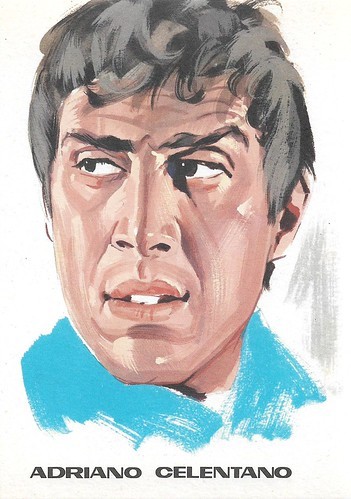
Italian postcard by E.N.P., Roma. Art work by F. Picchioni.
One of Italy's best-loved artists, Adriano Celentano (1938) has been equally successful in film and music. Since starting his career as a rock ‘n roll singer in 1957, Adriano Celentano has released 40 albums. This superstar of Italian pop music is also active as a songwriter, comedian, film director, and TV host.
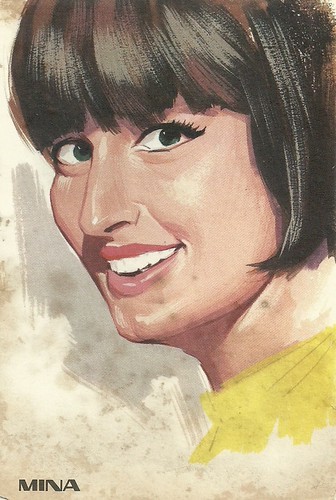
Italian postcard by E.N.P., Roma. Art work by F. Picchioni.
Italian singer Mina (1940) dominated the Italian charts for fifteen years and reached an unsurpassed level of popularity in Italy. The ‘Queen of Screamers’ was a staple of Musicarellos (the popular Italian musical comedies of the early 1960s) and Italian television variety shows. During five decades, she had more than 70 singles on the Italian charts.
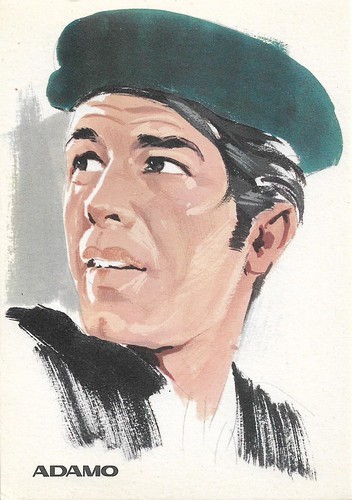
Italian postcard by E.N.P., Roma. Art work by F. Picchioni.
Italian-Belgian composer and singer Salvatore Adamo (1943) was a teen idol in the first half of the 1960s. Occasionally he also starred in films.
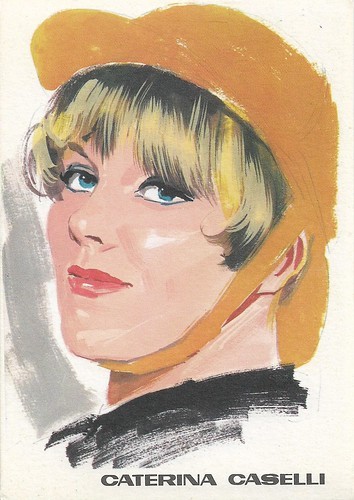
Italian postcard by E.N.P., Roma. Art work by F. Picchioni.
Caterina Caselli (1946) is an Italian record producer, music executive, singer, bass player and actress.
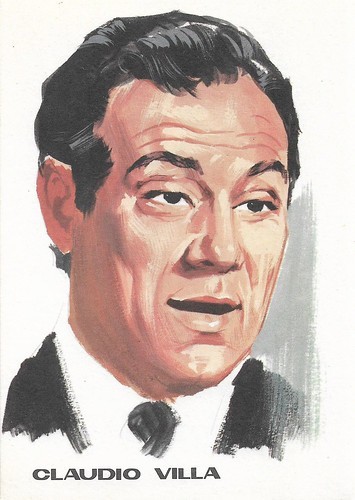
Italian postcard by E.N.P., Roma. Art work by F. Picchioni.
Claudio Villa (1926-1987) was an Italian singer and actor. He possessed a particularly high tenor voice and was considered the "little king" (reuccio) of melodious, popular song in 1950s Italy. Villa participated in the Sanremo Festival a full 13 times (including four victories), and twice also represented his country in the Eurovision Song Contest.
Franco Picchioni
After finishing art school Franco Picchioni (1942-2002) attended the Istituto Don Orione in Rome, where he studied the subject of film posters. His early works, both painted covers and half-tone illustrations, were published by the magazine Giallo Selezione in the early 1960s.
At first, he signed his works as 'Picchioni' or simply 'Franco', before he found his trademark signature: P. Franco. In 1965 he started working for Edizioni COFEDIT, and from then on, all magazines of the Roman printing house wore the characteristics of Picchioni's modern and effective covers.
Picchioni had a very wide range as an artist, with good knowledge of the works of Italian painters such as Averardo Ciriello and American artists like Frank Frazzetta. In 1966 he began an intense collaboration with Edizioni Ma.Ga. He made the covers of their novel series 'Gialli del Cerchio Rosso' and 'F.B.I. Story', novels that were collected more for the beautiful girls pictured on the covers than for the narrative content.
Franco also painted almost all of the covers of 'Joe Sub' and 'Lucy Melson'. At the same time, he was active as a cover artist and did important artwork in the field of film posters. He worked closely with the Studio Paradiso but had also direct contacts with film studios that commissioned a number of flyers and posters.
In 1968 he painted several covers for Ed. Fratelli Spada, where he met one of his admirers, Romano Felmang, regular cover designer of the 'Mandrake' comics. Picchioni thus in 1970 did a series of covers for the 'Mandrake' series.
Later Felmang, by putting Franco in direct contact with publishers, often asked him to paint the cover for various comic books. Thus Picchioni provided the covers for comic books such as 'Zorro', 'Il Santo'(The Saint), 'Sylvie', 'Loana', 'Sgt Clem', 'I Diavoli', and many others. When the recession of comic books with painted covers and film posters came about, Picchioni began to paint posters for the circus, mainly tigers, lions, and lion tamers.
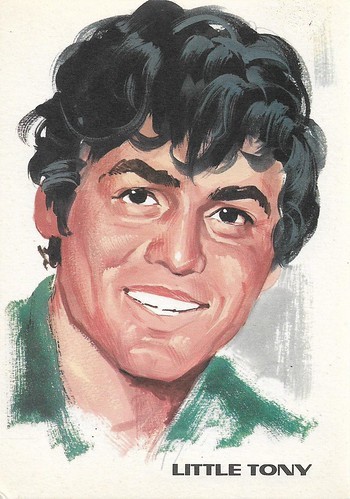
Italian postcard by E.N.P., Roma. Art work by F. Picchioni.
Italian Rock ‘n roll artist Little Tony (1941) achieved success in Great Britain during the late 1950s and early 1960s, as the lead singer of Little Tony & His Brothers. Little Tony & His Brothers first revisited Italy in 1961 to appear at the San Remo Festival, where they reached second place with '24 mila baci' (24 thousand kisses). In 1962, he returned to Italy where he continued a successful career as a singer and film actor in many Musicarellos, the typical Italian youth musical of the 1960s.
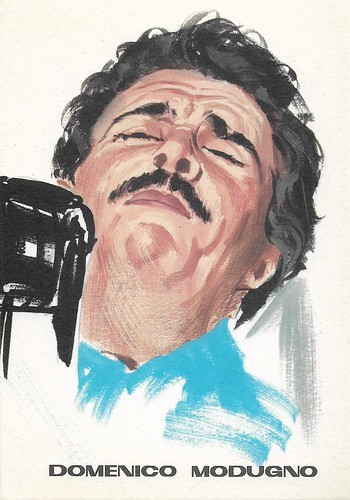
Italian postcard by E.N.P., Roma. Art work by F. Picchioni.
Domenico Modugno (1928-1994) was an Italian singer and actor. He became best known for his song 'Nel blu dipinto di blu' better known as 'Volare'.
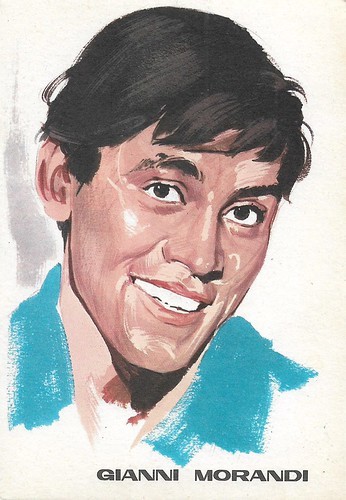
Italian postcard by E.N.P., Roma. Art work by F. Picchioni.
Italian pop singer and entertainer Gianni Morandi (1944) reportedly sold more than 30 million recordings and appeared in 18 films. In 1970, he represented Italy at the Eurovision Song Contest with Occhi di ragazza. His career went into a decline in the late 1970s but underwent a revival in the 1980s. He won the San Remo Festival in 1987, placed second in 1995, and third in 2000. Having enjoyed four decades of unmatched success, Gianni Morandi is among Italy's greatest performers of all time.
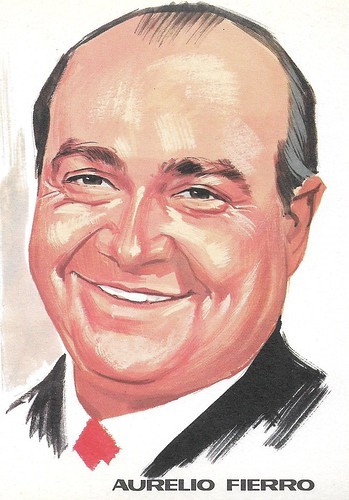
Italian postcard by E.N.P., Roma. Art work by F. Picchioni.
Aurelio Fierro (1923-2005) was an Italian singer and actor, famous for songs like 'Lazzarella', 'Guaglione', and 'Á pizza'. In the late 1950s, he acted in a dozen of film comedies.
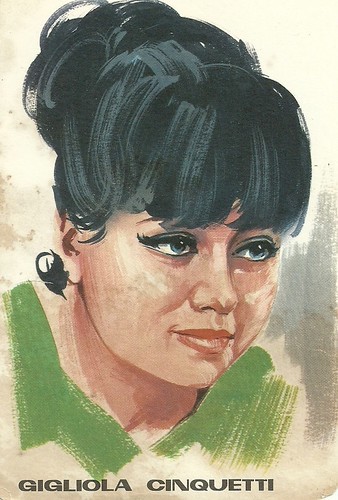
Italian postcard by E.N.P., Roma. Art work by F. Picchioni.
At the age of 16, Italian singer Gigliola Cinquetti (1947) won Festival di Sanremo with Non ho l'età, and with the same song, she won the Eurovision Song Contest 1964 and scored her first international hit. During her long career, she also worked as a TV journalist and appeared in a dozen of films.
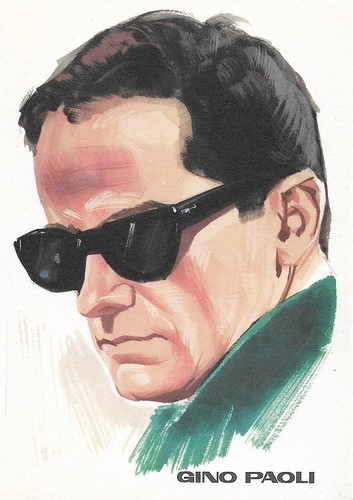
Italian postcard by E.N.P., Roma. Art work by F. Picchioni.
Gino Paoli (1934) is one of Italy's most famous singers and songwriters.
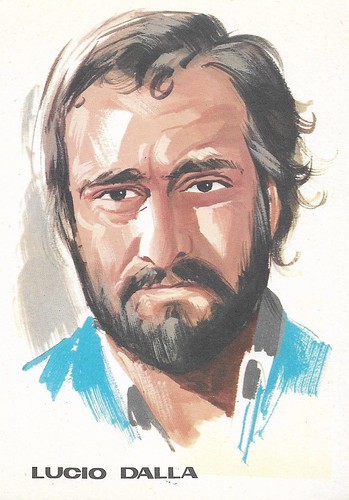
Italian postcard by E.N.P., Roma. Art work by F. Picchioni.
Lucio Dalla (1943-2012) was an Italian singer-songwriter, musician, and actor. Between 1965 and 1975 Dalla acted in various (musical) comedies such as Little Rita nel West (Ferdinando Baldi, 1967) with Rita Pavone, and Il santo patrono (Bitto Albertini, 1972), but he also had one of the leads in the drama I sovversivi (Paolo & Vittorio Taviani, 1967).
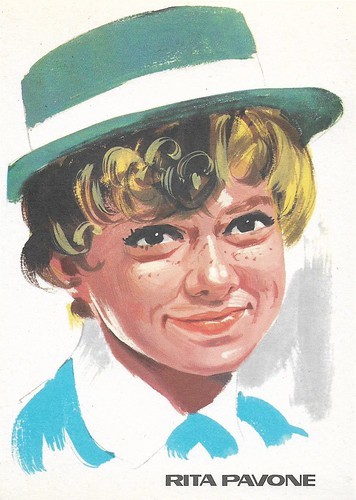
Italian postcard by E.N.P., Roma. Art work by F. Picchioni.
Rita Pavone (1945) was one of the biggest teenage stars in Europe during the 1960s, and one of the few Italian pop stars to gain a foothold in the American market. Pavone also starred in several 'Musicarellos'.
Source: Mandrakewiki

Italian postcard by E.N.P., Roma. Art work by F. Picchioni.
One of Italy's best-loved artists, Adriano Celentano (1938) has been equally successful in film and music. Since starting his career as a rock ‘n roll singer in 1957, Adriano Celentano has released 40 albums. This superstar of Italian pop music is also active as a songwriter, comedian, film director, and TV host.

Italian postcard by E.N.P., Roma. Art work by F. Picchioni.
Italian singer Mina (1940) dominated the Italian charts for fifteen years and reached an unsurpassed level of popularity in Italy. The ‘Queen of Screamers’ was a staple of Musicarellos (the popular Italian musical comedies of the early 1960s) and Italian television variety shows. During five decades, she had more than 70 singles on the Italian charts.

Italian postcard by E.N.P., Roma. Art work by F. Picchioni.
Italian-Belgian composer and singer Salvatore Adamo (1943) was a teen idol in the first half of the 1960s. Occasionally he also starred in films.

Italian postcard by E.N.P., Roma. Art work by F. Picchioni.
Caterina Caselli (1946) is an Italian record producer, music executive, singer, bass player and actress.

Italian postcard by E.N.P., Roma. Art work by F. Picchioni.
Claudio Villa (1926-1987) was an Italian singer and actor. He possessed a particularly high tenor voice and was considered the "little king" (reuccio) of melodious, popular song in 1950s Italy. Villa participated in the Sanremo Festival a full 13 times (including four victories), and twice also represented his country in the Eurovision Song Contest.
Franco Picchioni
After finishing art school Franco Picchioni (1942-2002) attended the Istituto Don Orione in Rome, where he studied the subject of film posters. His early works, both painted covers and half-tone illustrations, were published by the magazine Giallo Selezione in the early 1960s.
At first, he signed his works as 'Picchioni' or simply 'Franco', before he found his trademark signature: P. Franco. In 1965 he started working for Edizioni COFEDIT, and from then on, all magazines of the Roman printing house wore the characteristics of Picchioni's modern and effective covers.
Picchioni had a very wide range as an artist, with good knowledge of the works of Italian painters such as Averardo Ciriello and American artists like Frank Frazzetta. In 1966 he began an intense collaboration with Edizioni Ma.Ga. He made the covers of their novel series 'Gialli del Cerchio Rosso' and 'F.B.I. Story', novels that were collected more for the beautiful girls pictured on the covers than for the narrative content.
Franco also painted almost all of the covers of 'Joe Sub' and 'Lucy Melson'. At the same time, he was active as a cover artist and did important artwork in the field of film posters. He worked closely with the Studio Paradiso but had also direct contacts with film studios that commissioned a number of flyers and posters.
In 1968 he painted several covers for Ed. Fratelli Spada, where he met one of his admirers, Romano Felmang, regular cover designer of the 'Mandrake' comics. Picchioni thus in 1970 did a series of covers for the 'Mandrake' series.
Later Felmang, by putting Franco in direct contact with publishers, often asked him to paint the cover for various comic books. Thus Picchioni provided the covers for comic books such as 'Zorro', 'Il Santo'(The Saint), 'Sylvie', 'Loana', 'Sgt Clem', 'I Diavoli', and many others. When the recession of comic books with painted covers and film posters came about, Picchioni began to paint posters for the circus, mainly tigers, lions, and lion tamers.

Italian postcard by E.N.P., Roma. Art work by F. Picchioni.
Italian Rock ‘n roll artist Little Tony (1941) achieved success in Great Britain during the late 1950s and early 1960s, as the lead singer of Little Tony & His Brothers. Little Tony & His Brothers first revisited Italy in 1961 to appear at the San Remo Festival, where they reached second place with '24 mila baci' (24 thousand kisses). In 1962, he returned to Italy where he continued a successful career as a singer and film actor in many Musicarellos, the typical Italian youth musical of the 1960s.

Italian postcard by E.N.P., Roma. Art work by F. Picchioni.
Domenico Modugno (1928-1994) was an Italian singer and actor. He became best known for his song 'Nel blu dipinto di blu' better known as 'Volare'.

Italian postcard by E.N.P., Roma. Art work by F. Picchioni.
Italian pop singer and entertainer Gianni Morandi (1944) reportedly sold more than 30 million recordings and appeared in 18 films. In 1970, he represented Italy at the Eurovision Song Contest with Occhi di ragazza. His career went into a decline in the late 1970s but underwent a revival in the 1980s. He won the San Remo Festival in 1987, placed second in 1995, and third in 2000. Having enjoyed four decades of unmatched success, Gianni Morandi is among Italy's greatest performers of all time.

Italian postcard by E.N.P., Roma. Art work by F. Picchioni.
Aurelio Fierro (1923-2005) was an Italian singer and actor, famous for songs like 'Lazzarella', 'Guaglione', and 'Á pizza'. In the late 1950s, he acted in a dozen of film comedies.

Italian postcard by E.N.P., Roma. Art work by F. Picchioni.
At the age of 16, Italian singer Gigliola Cinquetti (1947) won Festival di Sanremo with Non ho l'età, and with the same song, she won the Eurovision Song Contest 1964 and scored her first international hit. During her long career, she also worked as a TV journalist and appeared in a dozen of films.

Italian postcard by E.N.P., Roma. Art work by F. Picchioni.
Gino Paoli (1934) is one of Italy's most famous singers and songwriters.

Italian postcard by E.N.P., Roma. Art work by F. Picchioni.
Lucio Dalla (1943-2012) was an Italian singer-songwriter, musician, and actor. Between 1965 and 1975 Dalla acted in various (musical) comedies such as Little Rita nel West (Ferdinando Baldi, 1967) with Rita Pavone, and Il santo patrono (Bitto Albertini, 1972), but he also had one of the leads in the drama I sovversivi (Paolo & Vittorio Taviani, 1967).

Italian postcard by E.N.P., Roma. Art work by F. Picchioni.
Rita Pavone (1945) was one of the biggest teenage stars in Europe during the 1960s, and one of the few Italian pop stars to gain a foothold in the American market. Pavone also starred in several 'Musicarellos'.
Source: Mandrakewiki
Published on September 24, 2021 22:00
September 23, 2021
Fred MacMurray
Fred MacMurray (1908-1991) was an American actor and singer who appeared in more than 100 films and a successful television series during a career that spanned nearly a half-century, from 1935 to the 1970s. He often played the quintessential nice guy, but some of his strongest and best-remembered performances cast him against type as a villain such as in director Billy Wilder's Film Noir Double Indemnity (1944), with costars Barbara Stanwyck and Edward G. Robinson. From 1959 through the 1960s, MacMurray appeared in numerous Disney films, including The Absent-Minded Professor, The Happiest Millionaire, and The Shaggy Dog. In 1960, he turned to television as Steve Douglas, the widowed father on My Three Sons, which ran from 1960 to 1972.
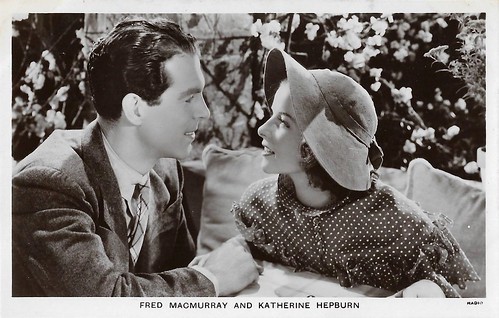
British postcard in the Film Partners, no P. 183. Photo: RKO Radio Pictures. Fred MacMurray and Katharine Hepburn in Alice Adams (George Stevens, 1935).
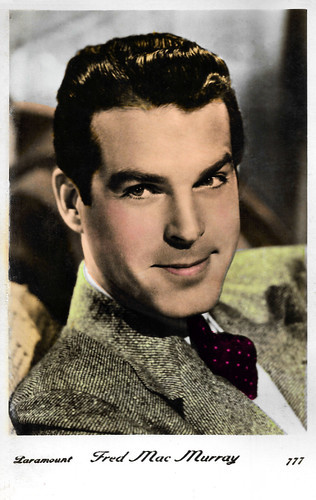
French postcard, no. 777. Photo: Paramount.
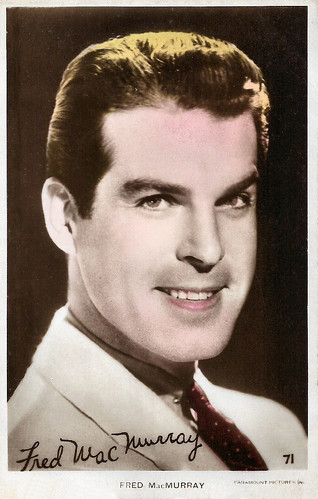
British postcard by Art Photo, no. 71. Photo: Paramount Pictures.
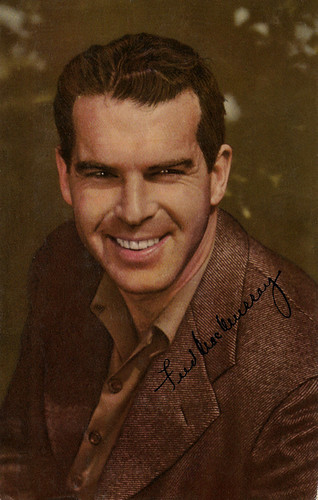
American postcard by Godfrey Herbert, The World Explorer, 1941. Photo: Paramount.
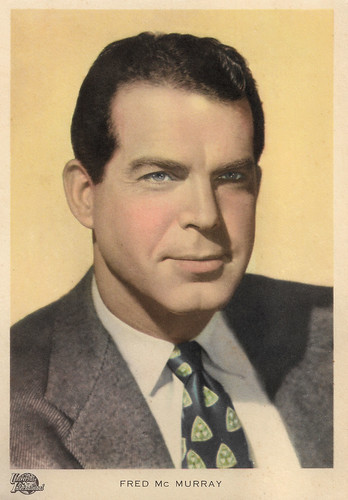
Italian postcard by GM. Photo: Universal-International.
The initial model for Captain Marvel
Fred Martin MacMurray was born in Kankakee, Illinois in 1908. He was the son of Maleta (née Martin) and concert violinist Frederick Talmadge MacMurray. His aunt, Fay Holderness, was a vaudeville performer and actress.
Before MacMurray was two years old, his family moved to Madison, Wisconsin, where his father taught music. They then relocated within the state to Beaver Dam, where his mother had been born. He later attended school in Quincy, Illinois before earning a full scholarship to Carroll College in Waukesha, Wisconsin.
At Carroll, MacMurray played the saxophone in numerous local bands. He did not graduate from college. In 1930, he played saxophone in the Gus Arnheim and his Cocoanut Grove Orchestra when Bing Crosby was the lead vocalist and Russ Columbo was in the violin section. As a featured vocalist, he recorded in 1930 with the Gus Arnheim Orchestra on 'All I Want Is Just One Girl' on the Victor label and with George Olsen on 'I'm In The Market For You' and 'After a Million Dreams'.
MacMurray's musical aspirations eventually led him to Hollywood, where he frequently worked as an extra. He later joined the California Collegians and with them, he appeared on Broadway in the hit production 'Three's a Crowd' (1930-1931) starring Sydney Greenstreet, Clifton Webb, and Libby Holman. He joined Holman on a duet of 'Something to Remember Me By'. He subsequently appeared in 'The Third Little Show' and alongside Sydney Greenstreet and Bob Hope in another hit show, 'Roberta' (1933-1934).
In 1934, he signed with Paramount Pictures for the then-standard 7-year contract. At Paramount, he rose to fame in The Gilded Lily (Wesley Ruggles, 1935), a romantic comedy with Claudette Colbert . Seemingly overnight he was among the hottest young actors in town, and he quickly emerged as a favourite romantic sparring partner with many of Hollywood's leading actresses.
Although the majority of his films of the 1930s can largely be dismissed as standard fare there are exceptions. Later in the 1930s, MacMurray worked with film directors Billy Wilder and Preston Sturges and actors Barbara Stanwyck , Henry Fonda , Humphrey Bogart , Marlene Dietrich, and, in seven films, Claudette Colbert .
He co-starred with Katharine Hepburn in Alice Adams (George Stevens, 1935), with Joan Crawford in Above Suspicion (Richard Thorpe, 1943), and with Carole Lombard in four productions: the screwball comedy Hands Across the Table (Mitchell Leisen, 1935), the mystery-comedy The Princess Comes Across (William K. Howard, 1936), the comedy-drama Swing High, Swing Low (Mitchell Leisen, 1937), and the screwball comedy True Confession (Wesley Ruggles, 1937).
Usually, he was cast in light comedies as a decent, thoughtful character such as in The Trail of the Lonesome Pine (Henry Hathaway, 1936), an ambitious early outdoor 3-strip Technicolor hit with Henry Fonda . MacMurray spent the decade learning his craft and developing a reputation as a solid actor. In 1939, artist C. C. Beck used MacMurray as the initial model for the superhero character who became Fawcett Comics' 'Captain Marvel'.
The 1940s gave him his chance to shine. MacMurray became one of Hollywood's highest-paid actors of the period. By 1943, his annual salary had reached $420,000, making him the highest-paid actor in Hollywood and the fourth-highest-paid person in the nation. He scored a huge hit with the thoroughly entertaining The Egg and I (Chester Erskine, 1947), again teamed with Claudette Colbert and today largely remembered for launching the long-running Ma and Pa Kettle franchise.
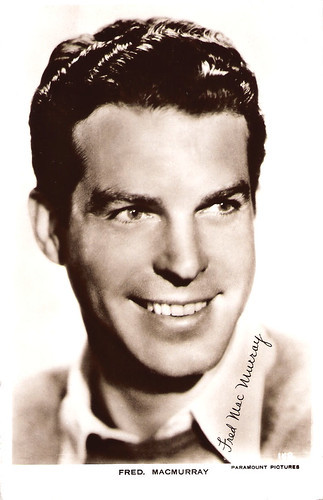
British Real Photograph postcard, no. 168. Photo: Paramount Pictures.
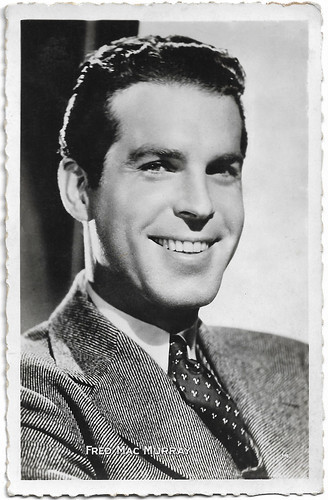
French postcard by Editions Chantal, no. 14 A.
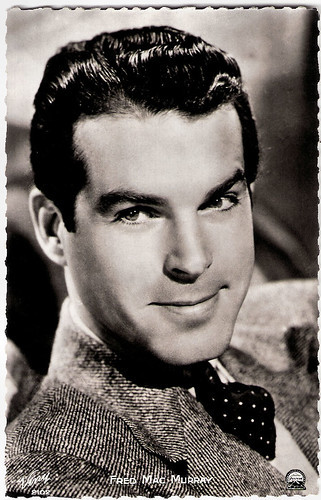
French postcard by Viny, no. 2102. Photo: Paramount Pictures.
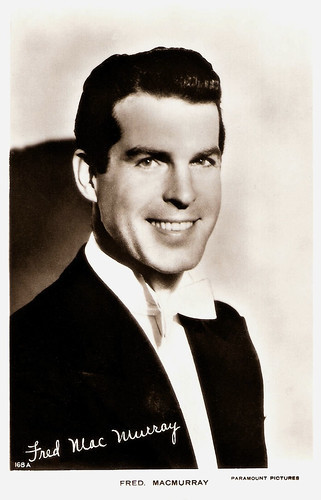
British Real Photograph postcard, no. 168A. Photo: Paramount Pictures.
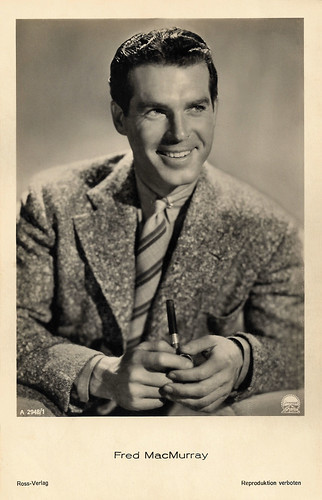
German postcard by Ross Verlag, no. A 2948/1, 1939-1940. Photo: Paramount.
Better when cast against type
Despite being typecast as a 'nice guy', Fred MacMurray often said his best roles were when he was cast against type such as under the direction of Billy Wilder and Edward Dmytryk. Perhaps his best-known 'bad guy' performance was that of Walter Neff, an insurance salesman who plots with a greedy wife (played by Barbara Stanwyck ) to murder her husband in the Film Noir classic Double Indemnity (Billy Wilder, 1944).
Another stellar turn in this category is MacMurray's cynical, spineless Lieutenant Thomas Keefer in Edward Dmytryk's The Caine Mutiny (1954). Six years later, MacMurray played Jeff Sheldrake, a two-timing corporate executive in Wilder's Oscar-winning romcom The Apartment (Billy Wilder, 1960) with Jack Lemmon and Shirley MacLaine.
Throughout the mid-1950s he appeared primarily in low-budget action pictures, most of them Westerns. In 1958, he guest-starred in the premiere episode of NBC's Cimarron City Western series, with George Montgomery and John Smith. MacMurray's career continued upward the following year when he was cast as the father in the Disney Studios live-action comedy, The Shaggy Dog (Charles Barton, 1959). The film was an enormous hit.
Then, from 1960 to 1972, he starred on television in My Three Sons, a long-running, highly rated series. Concurrent with My Three Sons, MacMurray stayed busy in films, starring as Professor Ned Brainard in Disney's The Absent-Minded Professor (Robert Stevenson, 1961) and in the sequel Son of Flubber (Robert Stevenson, 1963). MacMurray was nominated for a Golden Globe for The Absent-Minded Professor (Robert Stevenson, 1961). Using his star-power clout, MacMurray had a provision in his My Three Sons contract that all of his scenes on that series were to be shot in two separate month-long production blocks and filmed first. That condensed performance schedule provided him more free time to pursue his work in films, maintain his ranch in Northern California, and enjoy his favorite leisure activity, golf.
Over the years, MacMurray became one of the wealthiest actors in the entertainment business, primarily from wise real estate investments and from his "notorious frugality". After the cancellation of My Three Sons in 1972, MacMurray made only a few more film appearances and one last feature, The Swarm (Irwin Allen, 1978), before retiring.
A lifelong heavy smoker, MacMurray suffered from throat cancer in the late 1970s, and it reappeared in 1987. He also suffered a severe stroke during Christmas 1988 which left his right side paralysed and his speech affected, although with therapy he was able to make a ninety percent recovery.
After suffering from leukemia for more than a decade, Fred MacMurray died from pneumonia at age 83 in 1991 at his home in Santa Monica, California. His body was entombed in Holy Cross Cemetery. In 2005, his widow, actress June Haver , died at aged 79, and her body was entombed with him. MacMurray was married twice. He married dancer Lillian Lamont (legal name Lilian Wehmhoener MacMurray) in 1936, and the couple adopted two children, Susan (1940) and Robert (1946). After Lamont died of cancer in 1953, he married June Haver the following year. The couple subsequently adopted two more children - twins born in 1956 - Katherine and Laurie. MacMurray and Haver's marriage lasted 37 years, until Fred's death.
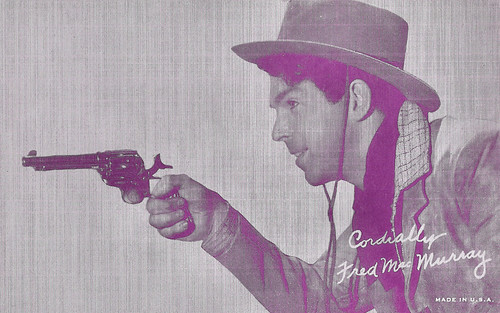
American Arcade card.
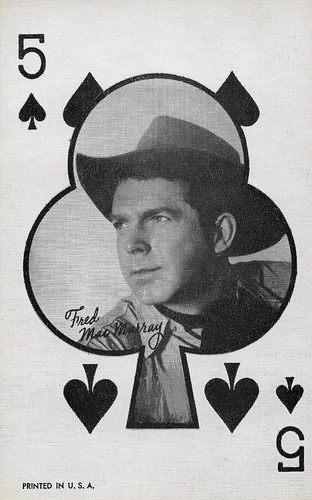
American Arcade card.
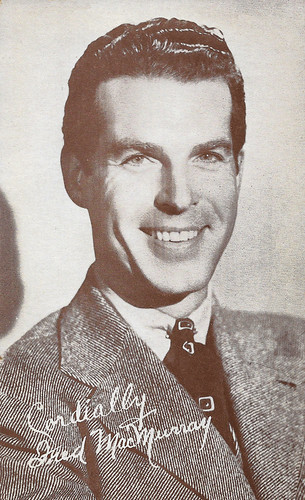
American Arcade card.
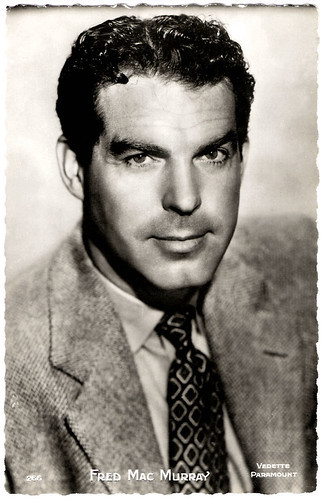
French postcard by Editions P.I., Paris, no. 266. Photo: Paramount Pictures, 1946.
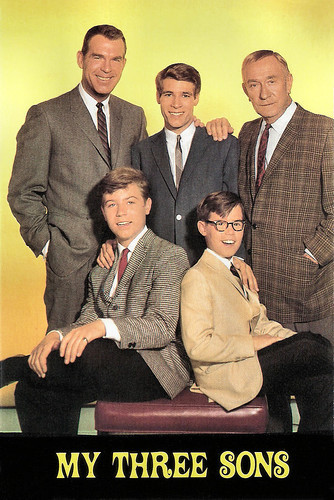
American postcard by The American Postcard Co. Inc., no. TV 81, 1984. Photo: Viacom International Inc. Fred MacMurray as Steve Douglas, Don Grady as Robbie, Stanley Livingston as Chip, Barry Livingston as Ernie, and William Demarest as Bub O'Casey in the TV series My Three Sons (1960-1972).
Sources: Jason Ankeny (AllMovie), Wikipedia, and .

British postcard in the Film Partners, no P. 183. Photo: RKO Radio Pictures. Fred MacMurray and Katharine Hepburn in Alice Adams (George Stevens, 1935).

French postcard, no. 777. Photo: Paramount.

British postcard by Art Photo, no. 71. Photo: Paramount Pictures.

American postcard by Godfrey Herbert, The World Explorer, 1941. Photo: Paramount.

Italian postcard by GM. Photo: Universal-International.
The initial model for Captain Marvel
Fred Martin MacMurray was born in Kankakee, Illinois in 1908. He was the son of Maleta (née Martin) and concert violinist Frederick Talmadge MacMurray. His aunt, Fay Holderness, was a vaudeville performer and actress.
Before MacMurray was two years old, his family moved to Madison, Wisconsin, where his father taught music. They then relocated within the state to Beaver Dam, where his mother had been born. He later attended school in Quincy, Illinois before earning a full scholarship to Carroll College in Waukesha, Wisconsin.
At Carroll, MacMurray played the saxophone in numerous local bands. He did not graduate from college. In 1930, he played saxophone in the Gus Arnheim and his Cocoanut Grove Orchestra when Bing Crosby was the lead vocalist and Russ Columbo was in the violin section. As a featured vocalist, he recorded in 1930 with the Gus Arnheim Orchestra on 'All I Want Is Just One Girl' on the Victor label and with George Olsen on 'I'm In The Market For You' and 'After a Million Dreams'.
MacMurray's musical aspirations eventually led him to Hollywood, where he frequently worked as an extra. He later joined the California Collegians and with them, he appeared on Broadway in the hit production 'Three's a Crowd' (1930-1931) starring Sydney Greenstreet, Clifton Webb, and Libby Holman. He joined Holman on a duet of 'Something to Remember Me By'. He subsequently appeared in 'The Third Little Show' and alongside Sydney Greenstreet and Bob Hope in another hit show, 'Roberta' (1933-1934).
In 1934, he signed with Paramount Pictures for the then-standard 7-year contract. At Paramount, he rose to fame in The Gilded Lily (Wesley Ruggles, 1935), a romantic comedy with Claudette Colbert . Seemingly overnight he was among the hottest young actors in town, and he quickly emerged as a favourite romantic sparring partner with many of Hollywood's leading actresses.
Although the majority of his films of the 1930s can largely be dismissed as standard fare there are exceptions. Later in the 1930s, MacMurray worked with film directors Billy Wilder and Preston Sturges and actors Barbara Stanwyck , Henry Fonda , Humphrey Bogart , Marlene Dietrich, and, in seven films, Claudette Colbert .
He co-starred with Katharine Hepburn in Alice Adams (George Stevens, 1935), with Joan Crawford in Above Suspicion (Richard Thorpe, 1943), and with Carole Lombard in four productions: the screwball comedy Hands Across the Table (Mitchell Leisen, 1935), the mystery-comedy The Princess Comes Across (William K. Howard, 1936), the comedy-drama Swing High, Swing Low (Mitchell Leisen, 1937), and the screwball comedy True Confession (Wesley Ruggles, 1937).
Usually, he was cast in light comedies as a decent, thoughtful character such as in The Trail of the Lonesome Pine (Henry Hathaway, 1936), an ambitious early outdoor 3-strip Technicolor hit with Henry Fonda . MacMurray spent the decade learning his craft and developing a reputation as a solid actor. In 1939, artist C. C. Beck used MacMurray as the initial model for the superhero character who became Fawcett Comics' 'Captain Marvel'.
The 1940s gave him his chance to shine. MacMurray became one of Hollywood's highest-paid actors of the period. By 1943, his annual salary had reached $420,000, making him the highest-paid actor in Hollywood and the fourth-highest-paid person in the nation. He scored a huge hit with the thoroughly entertaining The Egg and I (Chester Erskine, 1947), again teamed with Claudette Colbert and today largely remembered for launching the long-running Ma and Pa Kettle franchise.

British Real Photograph postcard, no. 168. Photo: Paramount Pictures.

French postcard by Editions Chantal, no. 14 A.

French postcard by Viny, no. 2102. Photo: Paramount Pictures.

British Real Photograph postcard, no. 168A. Photo: Paramount Pictures.

German postcard by Ross Verlag, no. A 2948/1, 1939-1940. Photo: Paramount.
Better when cast against type
Despite being typecast as a 'nice guy', Fred MacMurray often said his best roles were when he was cast against type such as under the direction of Billy Wilder and Edward Dmytryk. Perhaps his best-known 'bad guy' performance was that of Walter Neff, an insurance salesman who plots with a greedy wife (played by Barbara Stanwyck ) to murder her husband in the Film Noir classic Double Indemnity (Billy Wilder, 1944).
Another stellar turn in this category is MacMurray's cynical, spineless Lieutenant Thomas Keefer in Edward Dmytryk's The Caine Mutiny (1954). Six years later, MacMurray played Jeff Sheldrake, a two-timing corporate executive in Wilder's Oscar-winning romcom The Apartment (Billy Wilder, 1960) with Jack Lemmon and Shirley MacLaine.
Throughout the mid-1950s he appeared primarily in low-budget action pictures, most of them Westerns. In 1958, he guest-starred in the premiere episode of NBC's Cimarron City Western series, with George Montgomery and John Smith. MacMurray's career continued upward the following year when he was cast as the father in the Disney Studios live-action comedy, The Shaggy Dog (Charles Barton, 1959). The film was an enormous hit.
Then, from 1960 to 1972, he starred on television in My Three Sons, a long-running, highly rated series. Concurrent with My Three Sons, MacMurray stayed busy in films, starring as Professor Ned Brainard in Disney's The Absent-Minded Professor (Robert Stevenson, 1961) and in the sequel Son of Flubber (Robert Stevenson, 1963). MacMurray was nominated for a Golden Globe for The Absent-Minded Professor (Robert Stevenson, 1961). Using his star-power clout, MacMurray had a provision in his My Three Sons contract that all of his scenes on that series were to be shot in two separate month-long production blocks and filmed first. That condensed performance schedule provided him more free time to pursue his work in films, maintain his ranch in Northern California, and enjoy his favorite leisure activity, golf.
Over the years, MacMurray became one of the wealthiest actors in the entertainment business, primarily from wise real estate investments and from his "notorious frugality". After the cancellation of My Three Sons in 1972, MacMurray made only a few more film appearances and one last feature, The Swarm (Irwin Allen, 1978), before retiring.
A lifelong heavy smoker, MacMurray suffered from throat cancer in the late 1970s, and it reappeared in 1987. He also suffered a severe stroke during Christmas 1988 which left his right side paralysed and his speech affected, although with therapy he was able to make a ninety percent recovery.
After suffering from leukemia for more than a decade, Fred MacMurray died from pneumonia at age 83 in 1991 at his home in Santa Monica, California. His body was entombed in Holy Cross Cemetery. In 2005, his widow, actress June Haver , died at aged 79, and her body was entombed with him. MacMurray was married twice. He married dancer Lillian Lamont (legal name Lilian Wehmhoener MacMurray) in 1936, and the couple adopted two children, Susan (1940) and Robert (1946). After Lamont died of cancer in 1953, he married June Haver the following year. The couple subsequently adopted two more children - twins born in 1956 - Katherine and Laurie. MacMurray and Haver's marriage lasted 37 years, until Fred's death.

American Arcade card.

American Arcade card.

American Arcade card.

French postcard by Editions P.I., Paris, no. 266. Photo: Paramount Pictures, 1946.

American postcard by The American Postcard Co. Inc., no. TV 81, 1984. Photo: Viacom International Inc. Fred MacMurray as Steve Douglas, Don Grady as Robbie, Stanley Livingston as Chip, Barry Livingston as Ernie, and William Demarest as Bub O'Casey in the TV series My Three Sons (1960-1972).
Sources: Jason Ankeny (AllMovie), Wikipedia, and .
Published on September 23, 2021 22:00
September 22, 2021
Renée Héribel
French actress Renée Héribel (1903-1952) knew to launch a short but impressive film career in the second half of the 1920s. In 1933, she suddenly retired at the age of 30 and disappeared into oblivion.
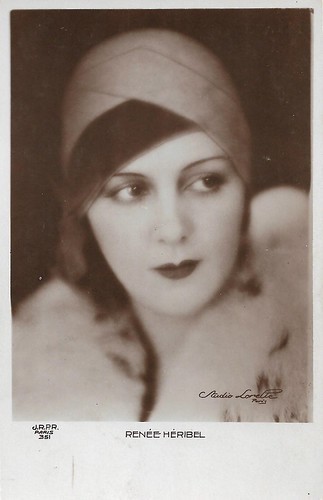
French postcard by J.R.P.R., Paris, no. 351. Photo: Studio Lorelle, Paris. Renée Héribel in Minuit... Place Pigalle (René Hervil, 1928).
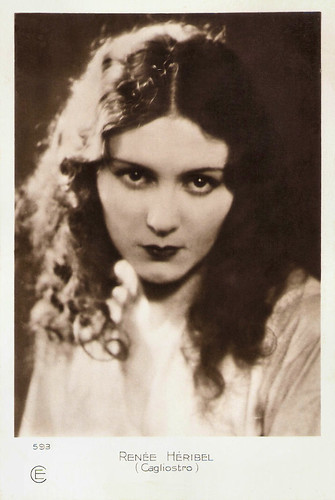
French postcard by Cinémagazine-Edition, no. 593. Renée Heribel as Lorenza in the Franco-German co-production Cagliostro (Richard Oswald, 1929).
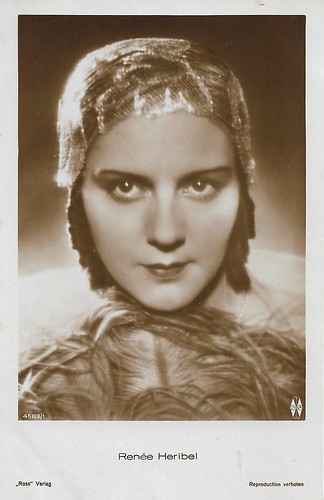
German postcard by Ross Verlag, no. 4583/1, 1929-1930. Renée Héribel in Narkose (Alfred Abel, 1929).
A leap abroad to Germany
Renée Eugénie Aimée Héribel was born in Caen, France, in 1903.
At 21, she made her film debut in the serial Le vert gallant/The gallant green (René Leprince, 1924), about the amorous adventures of King Henri IV.
Héribel's first big box office hit followed with Madame Sans-Gêne (Léonce Perret, 1925) with Gloria Swanson in the lead role.
This was followed by other French productions e.g. the serial Fanfan-la-Tulipe (René Leprince, 1925) with Aimé Simon-Girard , the village drama L'île enchantée/Corsican Love (Henry Roussel, 1925) with Jean Garat, and Minuit, Place Pigalle/Midnight ... Place Pigalle (René Leprince, 1927).
Finally, Héribel made the leap abroad and acted in Germany in Die weisse Sklavin/The White Slave (Augusto Genina, 1927) with Liane Haid and Vladimir Gajdarov .
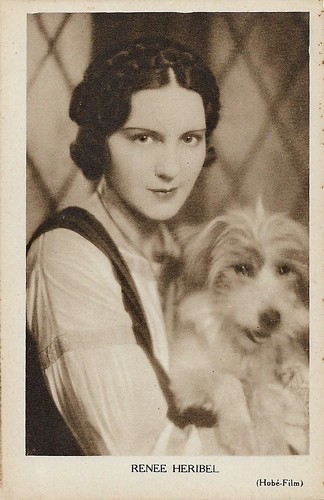
Belgian [?] collector card. Photo: Hobé-Film. Renée Héribel and [her] dog.
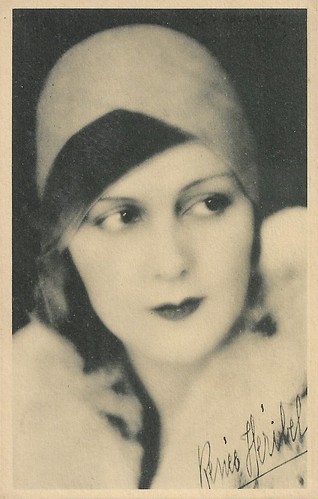
French postcard. Publicity card for the French late silent film Minuit... Place Pigalle/Midnight ... Place Pigalle René Hervil, 1928), starring Nicolas Rimsky and Héribel, and produced by Films Français Aubert.
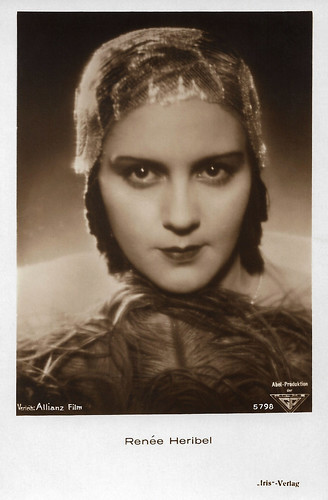
Austrian postcard by Iris-Verlag, no. 5798. Photo: Allianz-Film / Abel Produktion der GP. Renée Heribel in Narkose/Narcose (Alfred Abel, 1929).
The first French sound film
In Germany, Renée Héribel also starred in Die Stadt der tausend Freuden/The City of a Thousand Delights (Carmine Gallone, 1927) with Paul Richter and Adele Sandrock , and the Danish-German coproduction Jokeren/ Der Faschingskönig/The Joker (Georg Jacoby, 1928) starring Henry Edwards in the title role.
1929 was an important year in her career. She played Lorenza, wife of the eighteenth century Italian occultist Alessandro Cagliostro ( Hans Stüwe ) in Cagliostro (Richard Oswald, 1929). Isabelle Michel at CineArtistes : "A key role in the career of the actress who reveals the extent of her talent through her acting, full of sensitivity and emotion as a woman who is loving and worried about her husband."
In Germany, she also starred opposite Alfred Abel in Narkose/Anesthesia (Alfred Abel, Ernst Garden, 1929), an adaptation of Stefan Zweig’s novel 'Letter from an Unknown Woman'.
Héribel appeared in the first French sound film Les Trois masques/The Three Masks (André Hugon, 1930), in which two Corsican brothers decide to take revenge against the young man who has got their sister pregnant, unaware that he is trying to marry her in the face of his father's opposition. As no French studio had yet been converted for sound, it was shot at Twickenham Studios in London.
In the following years, she acted in a few more sound films, including Chacun sa chance/Everyone their chance (Hans Steinhoff, René Pujol, 1931) opposite Jean Gabin , Les Nuits de Port Saïd/The Nights of Port Said (Léo Mittler, 1932), and her final film, Le Crime du chemin rouge/The crime of the red road (Jacques Séverac, 1933).
The reason for her retirement at age 30 is unknown. In 1952 Renée Héribel died in Neuilly-sur-Seine at the age of only 49 years. She is buried at the Auteuil cemetery in Paris.
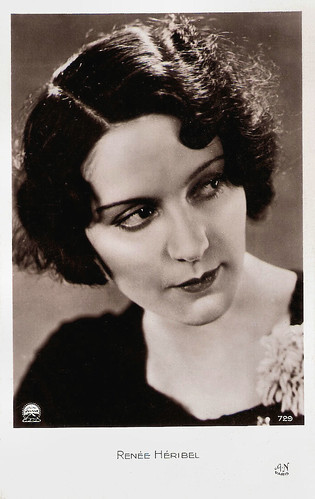
French postcard by A.N., Paris, no. 729. Photo: Films Paramount.
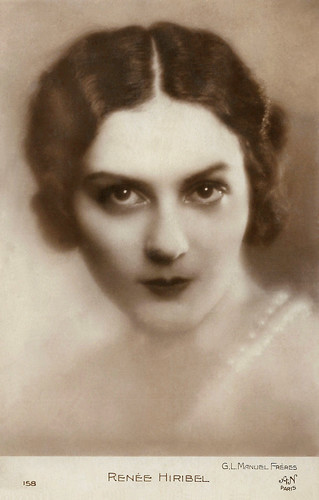
French postcard in the Les Vedettes de Cinéma, series by A.N., Paris, no. 158. Photo: G.L. Manuel Frères. Héribel's name is misspelled on this postcard as Hiribel.
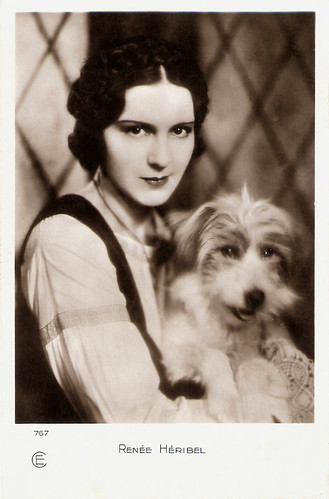
French postcard by Cinémagazine-Selection, no. 767.
Sources: Isabelle Michel (CineArtistes - French), Thomas Staedeli (Cyranos), Wikipedia (French and English), and .

French postcard by J.R.P.R., Paris, no. 351. Photo: Studio Lorelle, Paris. Renée Héribel in Minuit... Place Pigalle (René Hervil, 1928).

French postcard by Cinémagazine-Edition, no. 593. Renée Heribel as Lorenza in the Franco-German co-production Cagliostro (Richard Oswald, 1929).

German postcard by Ross Verlag, no. 4583/1, 1929-1930. Renée Héribel in Narkose (Alfred Abel, 1929).
A leap abroad to Germany
Renée Eugénie Aimée Héribel was born in Caen, France, in 1903.
At 21, she made her film debut in the serial Le vert gallant/The gallant green (René Leprince, 1924), about the amorous adventures of King Henri IV.
Héribel's first big box office hit followed with Madame Sans-Gêne (Léonce Perret, 1925) with Gloria Swanson in the lead role.
This was followed by other French productions e.g. the serial Fanfan-la-Tulipe (René Leprince, 1925) with Aimé Simon-Girard , the village drama L'île enchantée/Corsican Love (Henry Roussel, 1925) with Jean Garat, and Minuit, Place Pigalle/Midnight ... Place Pigalle (René Leprince, 1927).
Finally, Héribel made the leap abroad and acted in Germany in Die weisse Sklavin/The White Slave (Augusto Genina, 1927) with Liane Haid and Vladimir Gajdarov .

Belgian [?] collector card. Photo: Hobé-Film. Renée Héribel and [her] dog.

French postcard. Publicity card for the French late silent film Minuit... Place Pigalle/Midnight ... Place Pigalle René Hervil, 1928), starring Nicolas Rimsky and Héribel, and produced by Films Français Aubert.

Austrian postcard by Iris-Verlag, no. 5798. Photo: Allianz-Film / Abel Produktion der GP. Renée Heribel in Narkose/Narcose (Alfred Abel, 1929).
The first French sound film
In Germany, Renée Héribel also starred in Die Stadt der tausend Freuden/The City of a Thousand Delights (Carmine Gallone, 1927) with Paul Richter and Adele Sandrock , and the Danish-German coproduction Jokeren/ Der Faschingskönig/The Joker (Georg Jacoby, 1928) starring Henry Edwards in the title role.
1929 was an important year in her career. She played Lorenza, wife of the eighteenth century Italian occultist Alessandro Cagliostro ( Hans Stüwe ) in Cagliostro (Richard Oswald, 1929). Isabelle Michel at CineArtistes : "A key role in the career of the actress who reveals the extent of her talent through her acting, full of sensitivity and emotion as a woman who is loving and worried about her husband."
In Germany, she also starred opposite Alfred Abel in Narkose/Anesthesia (Alfred Abel, Ernst Garden, 1929), an adaptation of Stefan Zweig’s novel 'Letter from an Unknown Woman'.
Héribel appeared in the first French sound film Les Trois masques/The Three Masks (André Hugon, 1930), in which two Corsican brothers decide to take revenge against the young man who has got their sister pregnant, unaware that he is trying to marry her in the face of his father's opposition. As no French studio had yet been converted for sound, it was shot at Twickenham Studios in London.
In the following years, she acted in a few more sound films, including Chacun sa chance/Everyone their chance (Hans Steinhoff, René Pujol, 1931) opposite Jean Gabin , Les Nuits de Port Saïd/The Nights of Port Said (Léo Mittler, 1932), and her final film, Le Crime du chemin rouge/The crime of the red road (Jacques Séverac, 1933).
The reason for her retirement at age 30 is unknown. In 1952 Renée Héribel died in Neuilly-sur-Seine at the age of only 49 years. She is buried at the Auteuil cemetery in Paris.

French postcard by A.N., Paris, no. 729. Photo: Films Paramount.

French postcard in the Les Vedettes de Cinéma, series by A.N., Paris, no. 158. Photo: G.L. Manuel Frères. Héribel's name is misspelled on this postcard as Hiribel.

French postcard by Cinémagazine-Selection, no. 767.
Sources: Isabelle Michel (CineArtistes - French), Thomas Staedeli (Cyranos), Wikipedia (French and English), and .
Published on September 22, 2021 22:00
September 21, 2021
Ernst Deutsch
Ernst Deutsch (1890-1969) a.k.a. Ernest Dorian was an Austrian actor who acted in 42 silent films. On stage, he became famous as an expressionist actor in 'Der Sohn'(The Son) in 1916. He starred in such classic German Expressionist films as Der Golem, wie er in der Welt kam (1920) as the antihero Famulus, and Von morgens bis mitternachts (1920) in the lead role as the cashier. In 1938 the Jewish actor moved to the USA and worked in Hollywood. After the war, he returned to Austria and played Baron Kurtz in the Film Noir The Third Man (1949)

German postcard by Verlag Herm. Leiser, Berlin-Wilm., no. 769. Photo: Atelier Eberth, Berlin.
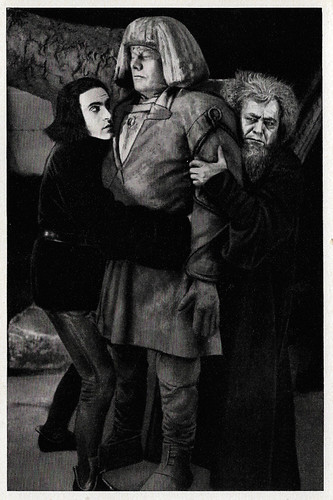
German collectors card by Ross Verlag in the series Vom Werden deutscher Filmkunst - Der stumme Film, no. 87, Group 43. Photo: Ufa. Publicity still for Der Golem, wie er in die Welt kam/The Golem: How He Came Into the World (Carl Boese, Paul Wegener, 1920). Caption: Paul Wegener as Golem, Albert Steinrück as Rabbi Loew, Ernst Deutsch as Famulus, Rabbi Loew's assistant.
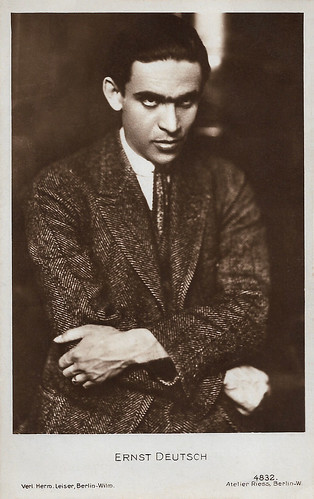
German postcard by Verlag Herm. Leiser, Berlin-Wilm., no. 4832. Photo: Atelier Riess, Berlin-W.
Famous as an expressionist actor
Ernst Deutsch was born in 1890 in Prague, Bohemia, Austria-Hungary He was the son of the Prague-based Jewish merchant Ludwig Deutsch and Louise Kraus. Deutsch grew up in Prague's Old Town and attended grammar school there.
He was a childhood friend of author Franz Werfel in Prague and remained so throughout his life. With their wives, they lived close together in California and visited each other frequently. Deutsch was a skilled tennis player and advanced to 7th place in the Austro-Hungarian rankings. After graduating from high school, he served in the Imperial and Royal Army as a one-year volunteer.
In 1914 Deutsch made his stage debut under Berthold Viertel at the Vienna Volksbühne (People's Theatre). After a short season in Prague, Edgar Licho hired him for the Albert Theater in Dresden, where he moved to in 1916. There he played the role of Franz Moor in Friedrich Schiller's 'Die Räuber' (The Robbers) and the role of Moritz Stiefel in Frank Wedekind's 'Frühlings Erwachen'(Spring Awakening).
He took on the title role in the world première of Walter Hasenclever's Expressionist drama 'Der Sohn' (The Son) and thus became famous as an expressionist actor. The work, which premiered on 8 October 1916, took place within a matinée in front of invited guests, such as the Royal Saxon Intendant Count Seebach, and was successfully reprised in 1918 and 1923.
In 1917 Ernst Deutsch moved to the Deutsches Theater in Berlin, which was under the direction of Max Reinhardt. There Deutsch played at various stages in the city until 1933, and also gave guest performances in Hamburg, Munich, and Vienna. He was even a participant in a South American tour in 1930.
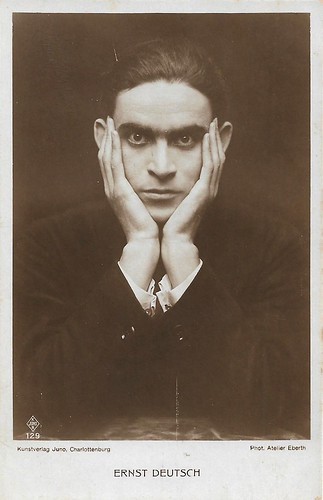
German postcard by Kunstverlag Juno, Charlottenburg, no. 129. Photo: Atelier Eberth.
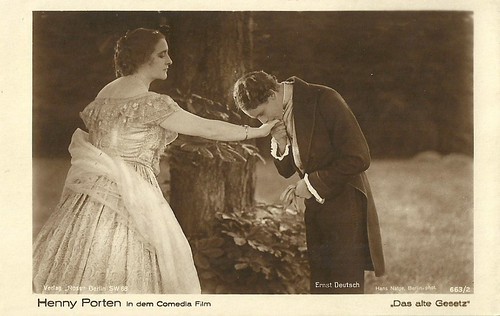
German postcard by Ross Verlag, no. 663/2, 1919-1924. Photo: Hans Natge, Berlin / Comedia Film. Henny Porten and Ernst Deutsch in Das alte Gesetz/This Ancient Law (Ewald André Dupont, 1923).
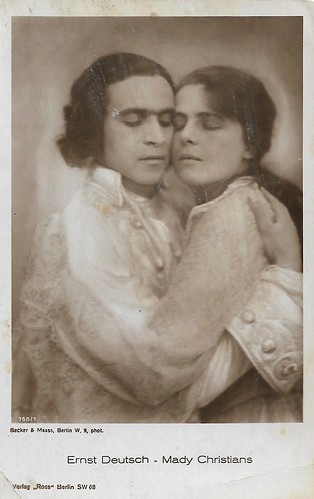
German postcard by Ross Verlag, no. 768/1, 1925-1926. Photo: Becker & Maass, Berlin. Possibly Ernst Deutsch and Mady Christians in Soll und Haben (Carl Wilhelm, 1924).
Opposite several major female stars of the era
From 1916, Ernst Deutsch appeared in 42 silent films, debuting in Richard Oswald's Die Rache der Toten/Revenge of the Dead (1916). opposite Werner Krauss and Rita Clermont.
In the late 1910s, he played opposite several major female stars of the era. Opposite Henny Porten , he acted in Irrungen/Errors (Rudolf Biebrach, 1919), Monika Vogelsang (Rudolf Biebrach, 1920) and Das alte Gesetz/This Ancient Law (Ewald André Dupont, 1923). In the latter, Deutsch played a son of an orthodox rabbi from a poor shtetl in Galizia, who decides to break with the family tradition and leave the shtetl to become an actor.
Deutsch also co-starred with Ellen Richter in Das Kloster von Sendomir/The Monastery of Sendomir (Rudolf Meinert, 1919), with Hedda Vernon in Blondes Gift/Blonde Poison (Hubert Moest, 1919), and with Gertrude Welcker in Die Geisha und der Samurai/The Geisha and the Samurai (Carl Boese, 1919).
In the same era he frequently acted in films starring Paul Wegener such as the two-parter Der Galeerensträfling/The Galley Slave (Rochus Gliese, 1919), Herzog Ferrantes Ende/The End of Duke Ferrante (Paul Wegener, 1922), and the silent horror film Der Golem, wie er in der Welt kam/The Golem: How He Came into the World (Paul Wegener, Carl Boese, 1920), which became a leading example of early German Expressionism.
Deutsch starred himself in another Expressionist film, Von morgens bis mitternachts/From Morn to Midnight (Karlheinz Martin, 1920). The stage-like painted sets, the costumes and the performance of the actors form an artistic unity, and Von morgens bis mitternachts is considered by film critics as one of the most radical films of the German Expressionist movement. The stylised distorted sets were designed by Robert Neppach and are even more avant-garde than those of Das Cabinet des Dr. Caligari/The Cabinet of Dr. Caligari (Robert Wiene, 1920).
In December 1922, Deutsch founded Comedia Film GmbH (1922-1926) together with Hans Janowitz and Eberhard Frowein. Deutsch's last silent film was Artisten/Artists (Géza von Bolváry, 1928), in which he played an illusionist. After that, he quit film acting for years and focused on theatre.
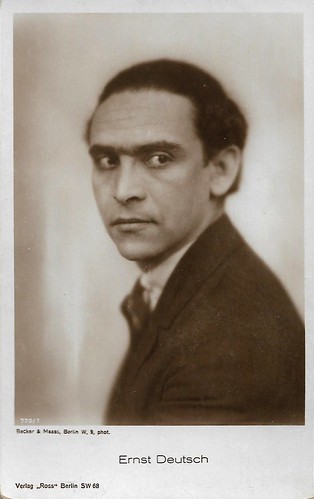
German postcard by Ross Verlag, Berlin, no. 770/1, 1925-1926. Photo: Becker & Maass, Berlin.
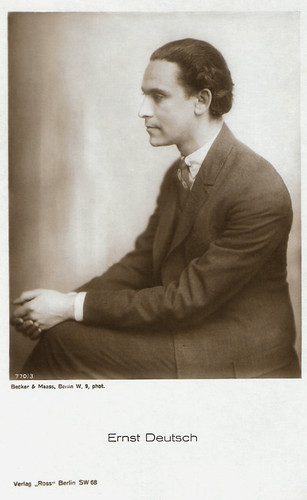
German postcard by Ross Verlag, Berlin, no. 770/3, 1925-1926. Photo: Becker & Maass, Berlin.
Playing Nazis and officers in Hollywood films
After the transfer of power to the National Socialists, Ernst Deutsch had to emigrate from Germany in April 1933 because of anti-Semitism and initially played again in Vienna and Prague. He gave guest performances in Zurich, Brussels, and in 1936 also in London, where he acted in a rip-off of 'The Scarlet Pimpernel', 'The Marriage of Corbal' (1936), starring Nils Asther and in Charles Bennett's play 'Page From a Diary' in the West End.
In 1938 he emigrated to New York, played briefly on Broadway, and moved to Hollywood in 1939, where he received US citizenship. He started a new career in film acting, first in Nurse Edith Cavell (1939) in which he played the public prosecutor. From 1942 he acted under the pseudonym Ernest Dorian, playing mainly Nazis and officers in Hollywood films such as Reunion in France (Jules Dassin, 1942) with Joan Crawford and John Wayne .
After a guest performance in Buenos Aires in 1946, Ernst Deutsch returned to Vienna in 1947 via Paris and Switzerland, where he became an ensemble member of the Burgtheater. At the Volkstheater he played Henri Dunant, the founder of the Red Cross, in 'Der Helfer Gottes' in 1948. From 1951 he lived again in Berlin, where he played at the Schiller and Schlossparktheater. He also made frequent guest appearances at home and abroad.
Deutsch was awarded the Volpi Cup as Best Actor at the 1948 Venice Film Festival for his performance in the film Der Prozess/The Trial (G.W. Pabst, 1948), starring Ewald Balser, about antisemitism in Hungary. Next, he played Baron Kurtz in the classic Film Noir The Third Man (Carol Reed, 1949), starring Joseph Cotten and Orson Welles .
His greatest theatre successes were as Nathan the Wise in Gotthold Ephraim Lessing's classic drama 'Nathan der Weise' and as Shylock in William Shakespeare's 'The Merchant of Venice'. He embodied Nathan for more than 10 years and in over 1000 performances, traveling throughout Europe with the production, and also performing it on TV in both 1956 and 1964.
Ernst Deutsch died in 1969 in Berlin at the age of 78. In 1922, he had married his childhood friend Anuschka Fuchs from Prague. She was the daughter of the Prague industrialist Arthur Fuchs and Margarethe Ehrenzweig from Vienna. Her cousin Herbert Fuchs von Robettin was married to Franz Werfel's sister.
Deutsch is buried in the Jewish Cemetery Heerstraße in Berlin-Westend. For the fourth anniversary of his death in 1973, Friedrich Schütter's former Junges Theater in the Uhlenhorst quarter of Hamburg was renamed 'Ernst Deutsch Theater'. Deutsch had staged a performance of 'Nathan The Wise' there shortly before his death.
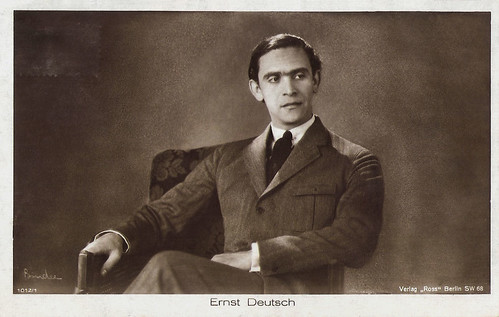
German postcard by Ross Verlag, Berlin, no. 1012/1, 1927-1928. Photo: Alex Binder.
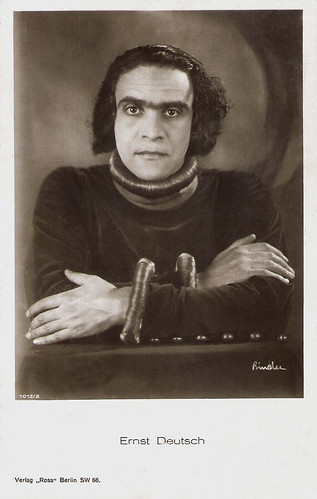
German postcard by Ross Verlag, Berlin, no. 1012/2, 1927-1928. Photo: Alex Binder.
Source: Wikipedia (German and English) and .

German postcard by Verlag Herm. Leiser, Berlin-Wilm., no. 769. Photo: Atelier Eberth, Berlin.

German collectors card by Ross Verlag in the series Vom Werden deutscher Filmkunst - Der stumme Film, no. 87, Group 43. Photo: Ufa. Publicity still for Der Golem, wie er in die Welt kam/The Golem: How He Came Into the World (Carl Boese, Paul Wegener, 1920). Caption: Paul Wegener as Golem, Albert Steinrück as Rabbi Loew, Ernst Deutsch as Famulus, Rabbi Loew's assistant.

German postcard by Verlag Herm. Leiser, Berlin-Wilm., no. 4832. Photo: Atelier Riess, Berlin-W.
Famous as an expressionist actor
Ernst Deutsch was born in 1890 in Prague, Bohemia, Austria-Hungary He was the son of the Prague-based Jewish merchant Ludwig Deutsch and Louise Kraus. Deutsch grew up in Prague's Old Town and attended grammar school there.
He was a childhood friend of author Franz Werfel in Prague and remained so throughout his life. With their wives, they lived close together in California and visited each other frequently. Deutsch was a skilled tennis player and advanced to 7th place in the Austro-Hungarian rankings. After graduating from high school, he served in the Imperial and Royal Army as a one-year volunteer.
In 1914 Deutsch made his stage debut under Berthold Viertel at the Vienna Volksbühne (People's Theatre). After a short season in Prague, Edgar Licho hired him for the Albert Theater in Dresden, where he moved to in 1916. There he played the role of Franz Moor in Friedrich Schiller's 'Die Räuber' (The Robbers) and the role of Moritz Stiefel in Frank Wedekind's 'Frühlings Erwachen'(Spring Awakening).
He took on the title role in the world première of Walter Hasenclever's Expressionist drama 'Der Sohn' (The Son) and thus became famous as an expressionist actor. The work, which premiered on 8 October 1916, took place within a matinée in front of invited guests, such as the Royal Saxon Intendant Count Seebach, and was successfully reprised in 1918 and 1923.
In 1917 Ernst Deutsch moved to the Deutsches Theater in Berlin, which was under the direction of Max Reinhardt. There Deutsch played at various stages in the city until 1933, and also gave guest performances in Hamburg, Munich, and Vienna. He was even a participant in a South American tour in 1930.

German postcard by Kunstverlag Juno, Charlottenburg, no. 129. Photo: Atelier Eberth.

German postcard by Ross Verlag, no. 663/2, 1919-1924. Photo: Hans Natge, Berlin / Comedia Film. Henny Porten and Ernst Deutsch in Das alte Gesetz/This Ancient Law (Ewald André Dupont, 1923).

German postcard by Ross Verlag, no. 768/1, 1925-1926. Photo: Becker & Maass, Berlin. Possibly Ernst Deutsch and Mady Christians in Soll und Haben (Carl Wilhelm, 1924).
Opposite several major female stars of the era
From 1916, Ernst Deutsch appeared in 42 silent films, debuting in Richard Oswald's Die Rache der Toten/Revenge of the Dead (1916). opposite Werner Krauss and Rita Clermont.
In the late 1910s, he played opposite several major female stars of the era. Opposite Henny Porten , he acted in Irrungen/Errors (Rudolf Biebrach, 1919), Monika Vogelsang (Rudolf Biebrach, 1920) and Das alte Gesetz/This Ancient Law (Ewald André Dupont, 1923). In the latter, Deutsch played a son of an orthodox rabbi from a poor shtetl in Galizia, who decides to break with the family tradition and leave the shtetl to become an actor.
Deutsch also co-starred with Ellen Richter in Das Kloster von Sendomir/The Monastery of Sendomir (Rudolf Meinert, 1919), with Hedda Vernon in Blondes Gift/Blonde Poison (Hubert Moest, 1919), and with Gertrude Welcker in Die Geisha und der Samurai/The Geisha and the Samurai (Carl Boese, 1919).
In the same era he frequently acted in films starring Paul Wegener such as the two-parter Der Galeerensträfling/The Galley Slave (Rochus Gliese, 1919), Herzog Ferrantes Ende/The End of Duke Ferrante (Paul Wegener, 1922), and the silent horror film Der Golem, wie er in der Welt kam/The Golem: How He Came into the World (Paul Wegener, Carl Boese, 1920), which became a leading example of early German Expressionism.
Deutsch starred himself in another Expressionist film, Von morgens bis mitternachts/From Morn to Midnight (Karlheinz Martin, 1920). The stage-like painted sets, the costumes and the performance of the actors form an artistic unity, and Von morgens bis mitternachts is considered by film critics as one of the most radical films of the German Expressionist movement. The stylised distorted sets were designed by Robert Neppach and are even more avant-garde than those of Das Cabinet des Dr. Caligari/The Cabinet of Dr. Caligari (Robert Wiene, 1920).
In December 1922, Deutsch founded Comedia Film GmbH (1922-1926) together with Hans Janowitz and Eberhard Frowein. Deutsch's last silent film was Artisten/Artists (Géza von Bolváry, 1928), in which he played an illusionist. After that, he quit film acting for years and focused on theatre.

German postcard by Ross Verlag, Berlin, no. 770/1, 1925-1926. Photo: Becker & Maass, Berlin.

German postcard by Ross Verlag, Berlin, no. 770/3, 1925-1926. Photo: Becker & Maass, Berlin.
Playing Nazis and officers in Hollywood films
After the transfer of power to the National Socialists, Ernst Deutsch had to emigrate from Germany in April 1933 because of anti-Semitism and initially played again in Vienna and Prague. He gave guest performances in Zurich, Brussels, and in 1936 also in London, where he acted in a rip-off of 'The Scarlet Pimpernel', 'The Marriage of Corbal' (1936), starring Nils Asther and in Charles Bennett's play 'Page From a Diary' in the West End.
In 1938 he emigrated to New York, played briefly on Broadway, and moved to Hollywood in 1939, where he received US citizenship. He started a new career in film acting, first in Nurse Edith Cavell (1939) in which he played the public prosecutor. From 1942 he acted under the pseudonym Ernest Dorian, playing mainly Nazis and officers in Hollywood films such as Reunion in France (Jules Dassin, 1942) with Joan Crawford and John Wayne .
After a guest performance in Buenos Aires in 1946, Ernst Deutsch returned to Vienna in 1947 via Paris and Switzerland, where he became an ensemble member of the Burgtheater. At the Volkstheater he played Henri Dunant, the founder of the Red Cross, in 'Der Helfer Gottes' in 1948. From 1951 he lived again in Berlin, where he played at the Schiller and Schlossparktheater. He also made frequent guest appearances at home and abroad.
Deutsch was awarded the Volpi Cup as Best Actor at the 1948 Venice Film Festival for his performance in the film Der Prozess/The Trial (G.W. Pabst, 1948), starring Ewald Balser, about antisemitism in Hungary. Next, he played Baron Kurtz in the classic Film Noir The Third Man (Carol Reed, 1949), starring Joseph Cotten and Orson Welles .
His greatest theatre successes were as Nathan the Wise in Gotthold Ephraim Lessing's classic drama 'Nathan der Weise' and as Shylock in William Shakespeare's 'The Merchant of Venice'. He embodied Nathan for more than 10 years and in over 1000 performances, traveling throughout Europe with the production, and also performing it on TV in both 1956 and 1964.
Ernst Deutsch died in 1969 in Berlin at the age of 78. In 1922, he had married his childhood friend Anuschka Fuchs from Prague. She was the daughter of the Prague industrialist Arthur Fuchs and Margarethe Ehrenzweig from Vienna. Her cousin Herbert Fuchs von Robettin was married to Franz Werfel's sister.
Deutsch is buried in the Jewish Cemetery Heerstraße in Berlin-Westend. For the fourth anniversary of his death in 1973, Friedrich Schütter's former Junges Theater in the Uhlenhorst quarter of Hamburg was renamed 'Ernst Deutsch Theater'. Deutsch had staged a performance of 'Nathan The Wise' there shortly before his death.

German postcard by Ross Verlag, Berlin, no. 1012/1, 1927-1928. Photo: Alex Binder.

German postcard by Ross Verlag, Berlin, no. 1012/2, 1927-1928. Photo: Alex Binder.
Source: Wikipedia (German and English) and .
Published on September 21, 2021 22:00
September 20, 2021
The Ten Commandments (1923)
The Ten Commandments (1923) is an American silent religious epic produced and directed by Cecil B. DeMille. Written by Jeanie MacPherson, the film is divided into two parts: a prologue recreating the biblical story of the Exodus and a modern story concerning two brothers and their respective views of the Ten Commandments. Lauded for its immense and stupendous scenes, use of Technicolor process, and the parting of the Red Sea sequence, the expensive film proved to be a box-office hit upon release. It is the first in DeMille's biblical trilogy, followed by The King of Kings (1927) and The Sign of the Cross (1932).
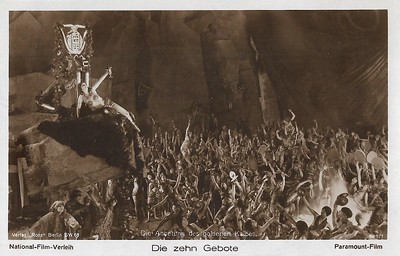
German postcard by Ross Verlag, no. 681/1. Photo: Paramount-Film / National-Verleih. Estelle Taylor is the woman who embraces the Golden Calf, in The Ten Commandments (Cecil B. DeMille, 1923). Caption: The Adoration of the Golden Calf.
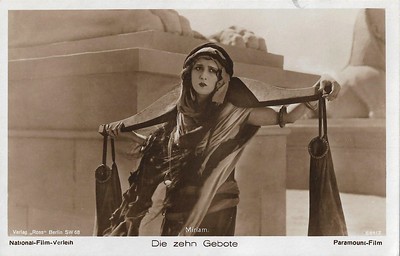
German postcard by Ross Verlag, no. 681/2. Photo: Paramount-Film / National-Verleih. Estelle Taylor is now Miriam, sister of Moses in The Ten Commandments (Cecil B. DeMille, 1923). Caption: Miriam.
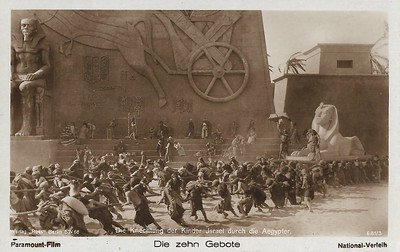
German postcard by Ross Verlag, no. 681/3. Photo: Paramount-Film / National-Verleih. Scene from The Ten Commandments (Cecil B. DeMille, 1923). Caption: The Slavery of the Children of Israel by the Egyptians.
Living by the lessons of the commandments
Cecil B. DeMille 's first screen version of The Ten Commandments is only peripherally a Biblical story. The Ten Commandments (Cecil B. DeMille, 1923) is divided into two parts: the first part tells the story of Moses ( Theodore Roberts ) leading the Jews from Egypt to the Promised Land, his receipt of the tablets, and the worship of the golden calf. But the second part shows the efficacy of the commandments in modern life through a story set in San Francisco. Two brothers ( Richard Dix and Rod LaRocque ), rivals for the love of Mary, also come into conflict when John discovers Dan used shoddy materials to construct a cathedral.
In the prologue, the opening statement explains that modern society mocked and laughed at Judeo-Christian morality until it witnessed the horrors of the World War; it then beseeches the viewer to turn back to the Ten Commandments, describing them as "the fundamental principles without which mankind cannot live together. They are not laws—they are the LAW." From there, the Book of Exodus is recounted.
At the point of the Ten Commandments, Moses is seen on Mount Sinai, having witnessed the commandments given as writing in the sky, which he then manually carves into stone tablets. When he returns, he finds that the Israelites have fallen into debauchery and built a golden calf to worship. An Israelite man and woman seducing each other find, to the horror of both, that the woman has hideous sores covering her hands and is now unclean, prompting her to beg Moses to be cleansed. A furious Moses commands the power of God to destroy the calf with lightning and smashes the commandments, deeming the Israelites unworthy.
In the modern story, two brothers, John and Dan McTavish ( Richard Dix and Rod LaRocque ) live with their mother Martha (Edythe Chapman), a strict believer in the Biblical law. The two sons make opposite decisions; John follows his mother's teaching of the Ten Commandments and becomes a carpenter living on meager earnings, and Dan, now an avowed atheist who is convinced that the Commandments never offer him anything, vows to break every one of them and rise to the top.
As Martha evicts Dan from her house, he and John stop for a bite to eat at a lunch wagon. There, Mary ( Leatrice Joy ), an impoverished but beautiful young woman, steals a bite of Dan's sandwich and triggers a madcap chase after her. She takes refuge in the McTavish house, where John convinces his mother to take Mary in for the night. John also convinces Dan to set aside his grievance and stay; he also introduces Dan to Mary. Dan quickly wins Mary over with his freewheeling ways. Martha's strict observance of the Sabbath causes friction when Dan and Mary begin dancing on a Sunday, and though John tries to convince his mother to show grace, Dan and Mary decide it is time to run off together.
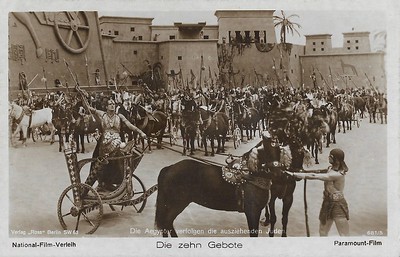
German postcard by Ross Verlag, no. 681/5. Photo: Paramount-Film / National-Verleih. Charles de Rochefort as Pharao Ramses in The Ten Commandments (Cecil B. DeMille, 1923). Caption: The Egyptians pursue the exiting Jews.
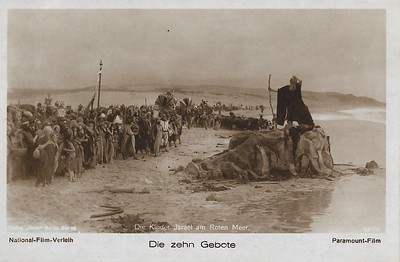
German postcard by Ross Verlag, no. 681/6. Photo: Paramount-Film / National-Verleih. Theodore Roberts as Moses (right on the rock) in The Ten Commandments (Cecil B. DeMille, 1923). Caption: The Children of Israel at the Red Sea.
The second-highest-grossing film of 1923
Three years later, Dan ( Rod LaRocque ) has become a corrupt contractor. He earns a contract to build a massive cathedral and decides to cut the amount of cement in the concrete to dangerously low levels, pocketing the money saved and becoming very rich. He puts John, still a bachelor, in charge of construction, hoping to use him as a conduit to provide the gifts to their mother that she refuses to accept from Dan. Dan cheats on Mary with Sally (Nita Naldi), a Eurasian adulteress. One day, Martha comes to visit him at his work site; a wall collapses on her. Fatally injured, with her last words, she tells Danny that it is her fault for being too strict teaching him to fear God when she should have taught him, love.
Now out of money, Dan learns that a muckraker tabloid has threatened to expose his operation. His business partner recommends a $25,000 bribe to stop publication, but lacking the funds, Dan instead attempts suicide — his partner stops the attempt, solely because he refuses to take the fall alone, and demands the money. He goes to Sally's brothel to take back a set of expensive pearls he gave her, but Sally refuses and reveals herself to have smuggled herself into the country from Molokai through a contraband jute shipment and is thus infected with leprosy, thus likely infecting Dan as well.
In a rage, he kills Sally and attempts to flee to Mexico on a motorboat (the S.S. Defiance), but rough weather sends him off course and he crashes into a rocky island. His dead body is seen among the wreckage. Mary, fearing herself to also be infected, stops by John's office to say goodbye, but John insists on taking her in. As he reads Mary the New Testament story of Jesus healing the lepers (re-enacted on screen, with Jesus shown only from behind), a light shows Mary's hands not to be scarred at all, and that her perceived scars had disappeared in the light—a metaphor for the healing salvation of Christ. Throughout the film, the visual motif of the tablets of the commandments appears in the sets, with a particular commandment appearing on them when it is relevant to the story.
The enormous sets of ancient Egypt in the first part have become Hollywood legend in themselves. The City of the Pharaohs was constructed of wood and plaster in the Guadalupe Dunes, an 18-mile stretch of coastal sand 170 miles north of L.A. The sets featured four 35-foot-tall statues of the Pharaoh Ramses, 21 five-ton sphinxes, and city walls over 120 feet high. An army of 2,500 actors, extras, carpenters, plasterers, painters, cooks, staff and film crew members inhabited the set for three months, housed in a virtual army camp that featured nearly 1,000 tents.
The Ten Commandments was partially filmed in Technicolor at a then-astronomical cost of $1.2 million, a sum that caused a decade-long rift between Cecil B. DeMille and Paramount Pictures. DeMille's film grossed several times that amount and became the second highest-grossing film of 1923. The box-office returns held the Paramount revenue record for 25 years until it was broken by other DeMille films. The Ten Commandments competed at the box office with Fox's The Shepherd King (J. Gordon Edwards, 1923), and won out overall. DeMille's remake and also his final film, The Ten Commandments (Cecil B. DeMille, 1956) dispenses with the modern-day story to concentrate on the life of Moses ( Charlton Heston ).
In 1923, after the shooting had wrapped, Cecil B. DeMille simply had the massive Egyptian city sets bulldozed, and buried in a huge pit beneath the sand, where they remain to this day. For years, the legendary "Lost City of DeMille" was spoken of by locals in Guadalupe who had worked on the film set. Artifacts from the Egyptian sets were found in the dunes, and can sometimes be found in local houses in the area.
In 1983, documentary filmmaker Peter Brosnan located the remains of the DeMille sets, still buried beneath the dunes. The site is now recognized as an official archaeological site by the state of California, and it is against the law to remove artifacts from the site. Brosnan has been trying for many years to raise money from the Hollywood studios to excavate the site, but so far has been unable to do so.
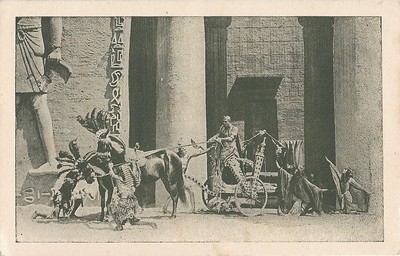
Italian postcard by Ed. Fratelli Palombi, Roma. Photo: Paramount-Film. Charles de Rochefort as Pharao Ramses in The Ten Commandments (Cecil B. DeMille, 1923).
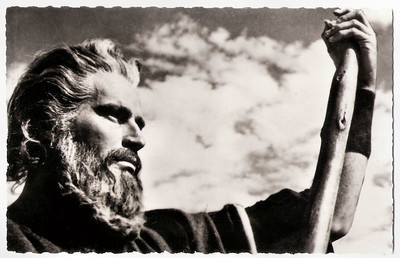
French postcard by Editions P.I., Paris, no. 830. Offered by Les Carbones Korès "Carboplane". Photo: Paramount. Charlton Heston in The Ten Commandments (Cecil B. DeMille, 1956).
Sources: Hal Erickson (AllMovie), Wikipedia, and IMDb

German postcard by Ross Verlag, no. 681/1. Photo: Paramount-Film / National-Verleih. Estelle Taylor is the woman who embraces the Golden Calf, in The Ten Commandments (Cecil B. DeMille, 1923). Caption: The Adoration of the Golden Calf.

German postcard by Ross Verlag, no. 681/2. Photo: Paramount-Film / National-Verleih. Estelle Taylor is now Miriam, sister of Moses in The Ten Commandments (Cecil B. DeMille, 1923). Caption: Miriam.

German postcard by Ross Verlag, no. 681/3. Photo: Paramount-Film / National-Verleih. Scene from The Ten Commandments (Cecil B. DeMille, 1923). Caption: The Slavery of the Children of Israel by the Egyptians.
Living by the lessons of the commandments
Cecil B. DeMille 's first screen version of The Ten Commandments is only peripherally a Biblical story. The Ten Commandments (Cecil B. DeMille, 1923) is divided into two parts: the first part tells the story of Moses ( Theodore Roberts ) leading the Jews from Egypt to the Promised Land, his receipt of the tablets, and the worship of the golden calf. But the second part shows the efficacy of the commandments in modern life through a story set in San Francisco. Two brothers ( Richard Dix and Rod LaRocque ), rivals for the love of Mary, also come into conflict when John discovers Dan used shoddy materials to construct a cathedral.
In the prologue, the opening statement explains that modern society mocked and laughed at Judeo-Christian morality until it witnessed the horrors of the World War; it then beseeches the viewer to turn back to the Ten Commandments, describing them as "the fundamental principles without which mankind cannot live together. They are not laws—they are the LAW." From there, the Book of Exodus is recounted.
At the point of the Ten Commandments, Moses is seen on Mount Sinai, having witnessed the commandments given as writing in the sky, which he then manually carves into stone tablets. When he returns, he finds that the Israelites have fallen into debauchery and built a golden calf to worship. An Israelite man and woman seducing each other find, to the horror of both, that the woman has hideous sores covering her hands and is now unclean, prompting her to beg Moses to be cleansed. A furious Moses commands the power of God to destroy the calf with lightning and smashes the commandments, deeming the Israelites unworthy.
In the modern story, two brothers, John and Dan McTavish ( Richard Dix and Rod LaRocque ) live with their mother Martha (Edythe Chapman), a strict believer in the Biblical law. The two sons make opposite decisions; John follows his mother's teaching of the Ten Commandments and becomes a carpenter living on meager earnings, and Dan, now an avowed atheist who is convinced that the Commandments never offer him anything, vows to break every one of them and rise to the top.
As Martha evicts Dan from her house, he and John stop for a bite to eat at a lunch wagon. There, Mary ( Leatrice Joy ), an impoverished but beautiful young woman, steals a bite of Dan's sandwich and triggers a madcap chase after her. She takes refuge in the McTavish house, where John convinces his mother to take Mary in for the night. John also convinces Dan to set aside his grievance and stay; he also introduces Dan to Mary. Dan quickly wins Mary over with his freewheeling ways. Martha's strict observance of the Sabbath causes friction when Dan and Mary begin dancing on a Sunday, and though John tries to convince his mother to show grace, Dan and Mary decide it is time to run off together.

German postcard by Ross Verlag, no. 681/5. Photo: Paramount-Film / National-Verleih. Charles de Rochefort as Pharao Ramses in The Ten Commandments (Cecil B. DeMille, 1923). Caption: The Egyptians pursue the exiting Jews.

German postcard by Ross Verlag, no. 681/6. Photo: Paramount-Film / National-Verleih. Theodore Roberts as Moses (right on the rock) in The Ten Commandments (Cecil B. DeMille, 1923). Caption: The Children of Israel at the Red Sea.
The second-highest-grossing film of 1923
Three years later, Dan ( Rod LaRocque ) has become a corrupt contractor. He earns a contract to build a massive cathedral and decides to cut the amount of cement in the concrete to dangerously low levels, pocketing the money saved and becoming very rich. He puts John, still a bachelor, in charge of construction, hoping to use him as a conduit to provide the gifts to their mother that she refuses to accept from Dan. Dan cheats on Mary with Sally (Nita Naldi), a Eurasian adulteress. One day, Martha comes to visit him at his work site; a wall collapses on her. Fatally injured, with her last words, she tells Danny that it is her fault for being too strict teaching him to fear God when she should have taught him, love.
Now out of money, Dan learns that a muckraker tabloid has threatened to expose his operation. His business partner recommends a $25,000 bribe to stop publication, but lacking the funds, Dan instead attempts suicide — his partner stops the attempt, solely because he refuses to take the fall alone, and demands the money. He goes to Sally's brothel to take back a set of expensive pearls he gave her, but Sally refuses and reveals herself to have smuggled herself into the country from Molokai through a contraband jute shipment and is thus infected with leprosy, thus likely infecting Dan as well.
In a rage, he kills Sally and attempts to flee to Mexico on a motorboat (the S.S. Defiance), but rough weather sends him off course and he crashes into a rocky island. His dead body is seen among the wreckage. Mary, fearing herself to also be infected, stops by John's office to say goodbye, but John insists on taking her in. As he reads Mary the New Testament story of Jesus healing the lepers (re-enacted on screen, with Jesus shown only from behind), a light shows Mary's hands not to be scarred at all, and that her perceived scars had disappeared in the light—a metaphor for the healing salvation of Christ. Throughout the film, the visual motif of the tablets of the commandments appears in the sets, with a particular commandment appearing on them when it is relevant to the story.
The enormous sets of ancient Egypt in the first part have become Hollywood legend in themselves. The City of the Pharaohs was constructed of wood and plaster in the Guadalupe Dunes, an 18-mile stretch of coastal sand 170 miles north of L.A. The sets featured four 35-foot-tall statues of the Pharaoh Ramses, 21 five-ton sphinxes, and city walls over 120 feet high. An army of 2,500 actors, extras, carpenters, plasterers, painters, cooks, staff and film crew members inhabited the set for three months, housed in a virtual army camp that featured nearly 1,000 tents.
The Ten Commandments was partially filmed in Technicolor at a then-astronomical cost of $1.2 million, a sum that caused a decade-long rift between Cecil B. DeMille and Paramount Pictures. DeMille's film grossed several times that amount and became the second highest-grossing film of 1923. The box-office returns held the Paramount revenue record for 25 years until it was broken by other DeMille films. The Ten Commandments competed at the box office with Fox's The Shepherd King (J. Gordon Edwards, 1923), and won out overall. DeMille's remake and also his final film, The Ten Commandments (Cecil B. DeMille, 1956) dispenses with the modern-day story to concentrate on the life of Moses ( Charlton Heston ).
In 1923, after the shooting had wrapped, Cecil B. DeMille simply had the massive Egyptian city sets bulldozed, and buried in a huge pit beneath the sand, where they remain to this day. For years, the legendary "Lost City of DeMille" was spoken of by locals in Guadalupe who had worked on the film set. Artifacts from the Egyptian sets were found in the dunes, and can sometimes be found in local houses in the area.
In 1983, documentary filmmaker Peter Brosnan located the remains of the DeMille sets, still buried beneath the dunes. The site is now recognized as an official archaeological site by the state of California, and it is against the law to remove artifacts from the site. Brosnan has been trying for many years to raise money from the Hollywood studios to excavate the site, but so far has been unable to do so.

Italian postcard by Ed. Fratelli Palombi, Roma. Photo: Paramount-Film. Charles de Rochefort as Pharao Ramses in The Ten Commandments (Cecil B. DeMille, 1923).

French postcard by Editions P.I., Paris, no. 830. Offered by Les Carbones Korès "Carboplane". Photo: Paramount. Charlton Heston in The Ten Commandments (Cecil B. DeMille, 1956).
Sources: Hal Erickson (AllMovie), Wikipedia, and IMDb
Published on September 20, 2021 22:00
September 19, 2021
La Collectionneuse: The Il(l)a Meery Case
Ila Meery (1908-1974 (?)) was a Hungarian-born actress who appeared in German and French late silent and early sound films. Her history was a mystery. French Wikipedia wrote she was one of the notorious 'Countesses of the Gestapo' in France and according to IMDb, she was a Soviet spy during the Second World War. But recent research by Marlène Pilaete proved that she was neither. Marlene wrote a fascinating article about her research on Ila Meery for the former French website L’Encinémathèque on 1 August 2019. We now present an English translation at EFSP.
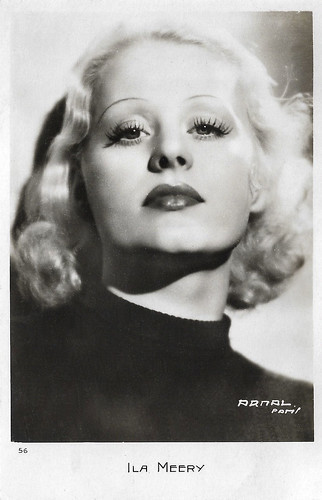
French postcard by Editions Chantal, no. 56. Photo: Arnal, Paris.
Two different persons
I would like to tell you today about a long investigation I have been conducting concerning the actress Il(l)a Meery. I will use the spelling "Ila Meery" in my text, although the variants "Illa" and "Mery" have sometimes been used. As you can see, this work has brought me a lot of surprises and its conclusions go against what is mentioned in many sources. It all started a few years ago when a documentary was shown on television, the name of which I cannot remember. During its broadcast, I saw the face of Ila Meery appear on the screen, who was presented as one of Henri Garat 's wives and as a collaborationist during the Occupation. I knew Ila Meery and had seen her in a few films but I didn't know these details. So I decided to research her further.
I first discovered that this information was developed in a book called 'Les comtesses de la gestapo' (The Gestapo Countesses) by Cyril Eder. I bought this book and read with interest the chapter on the Russian-born countess Mara (also Marie or Maria) Tchernycheff Bezobrazoff who, according to the author, had made films under the name Illa Meery, had played Anika in the film Lac au dames/Ladies Lake (Mrc Allégret, 1934), was married to Henri Garat from 1939 to 1942, had collaborated with the Germans during the Occupation, had been condemned after the war for her actions and had finally been exiled to the United States. Numerous Internet sites have repeated these statements.
I would add that, as is often the case with Russian surnames, 'Chernycheff' and 'Bezobrazoff' are transcribed with different spellings depending on the source. This aristocrat was born on 16 May 1915 in Moscow, the date mentioned on her Parisian marriage certificate. In the U.S.A., where she died on 18 December 2010, she appears to have turned one year younger according to the American Social Security death records. Her eventful life was very well told in the book, but one sentence raised my surprise: after indicating that Mara Tchernycheff Bezobrazoff followed normal schooling in Paris during the 1920s, the author wrote: "We lose track of her until 1932". I knew that Ila Meery had been a German film star in the late 1920s, a fact known and documented in many sources. This was the starting point of my investigation.
I then looked up her most famous silent film, Cagliostro - Liebe und Leben eines großen Abenteurers/Cagliostro (Richard Oswald, 1929), in which she played the Countess de la Motte and cheerfully revealed her breasts, and found the date of the first screening in Berlin, 8 April 1929. On that date, Mara Tchernycheff Bezobrazoff was only 13 years old (!!!). I found it rather strange that such a young girl was given such a role. I should add that Cagliostro was not her first screen appearance, since it was preceded by two German productions from 1928: Prinzessin Olala/Art of Love (Robert Land, 1928) and Der raub der Sabinerinnen/The Rape of the Sabine Women (Robert Land, 1928). Why did the Berlin company Super-Film GmbH hire an unknown and inexperienced Parisian schoolgirl to shoot these two first films in Germany?
As Mara Tchernycheff Bezobrazoff had been Henri Garat 's wife, I had a good look at the page Christian Grenier had dedicated at L’Encinémathèque to the actor, and, frankly, I didn't really recognise the blonde bombshell of Lac aux dames under the features of the brunette hanging on Garat's arm. I had the same impression when I saw a photo taken during her collaboration trial. Wanting to know for sure, I asked the late Yvan Foucart, who knew Jean-Pierre Aumont , the male star of Lac au dames, for his opinion on the matter. Yvan gave me a sentence from 'Souvenirs provisoires' (Temporary memories), Jean-Pierre Aumont 's autobiographical book published in 1957, in which he recalls the shooting of Lac aux dames: "We rolled in the straw, climbed trees, split the immaculate lake, surrounded by girls as beautiful as Maruska Bésobrasoff and Illa Méry". Everything became clearer, Jean-Pierre Aumont had among his female partners in Lac aux dames an actress named Ila Meery and another named Bésobrasoff. They were indeed two different people.
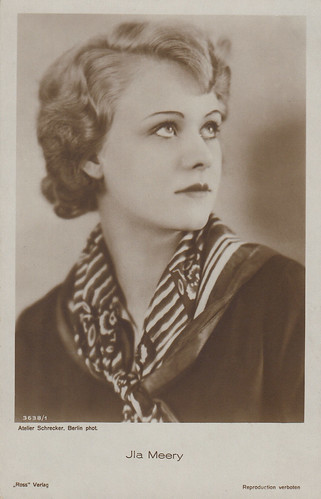
German postcard by Ross Verlag, no. 3638/1, 1928-1929. Photo: Atelier Schrecker, Berlin. Collection: Marlène Pilaete.
The prettiest girl in Budapest
I then intensified my research which led me to Hungary. Indeed, a document in two languages, Hungarian and English, dedicated to Hungarian animated films put me on a track. It says that in the second half of the 1930s, Janos Halasz (John Halas) signed a contract in England with a certain James Willing. Here is the sentence: "... a financier named James Willing, through the good offices of his Hungarian wife, Ila Mecséry (Ila Meery), signed a contract with him to make four advertisements and two feature films annually". I thus discovered the existence of the actress Ila Mecséry. I then had to turn to Hungarian sources, which proved to be decisive. I was able to see her birth certificate. She was born as Ilona Mecséry in Körmend, Vas County, on 31 August 1908. Concerning her date of death, I have found some Hungarian sources which mention 1974 but, as I was not able to view an official record, unlike her birth certificate, I give this date with reservations.
Then I was able to reconstruct the professional career of this actress. I learned that during her career she used the name "Ila Mecsery" (especially in her native country) and its shortened version, 'Ila Meery', 'Meery' being simply the contraction of her surname 'Mecsery', without the 'c' and 's'. There was even the variant 'Ilena Meery' for Cagliostro. I also consulted many Hungarian magazines and newspapers of the time. Here are some examples: in the Magazine Szinhazi Elet, number 49 of the year 1925, on page 32, there is a photo of a group of girls performing in the operetta 'Alexandra' by Albert Szirmai at the Royal Theatre in Budapest. The caption mentions the names of the girls, including Ilona Mecséry and another future star, Rozsi Barsony (Rose Barsony). In Szinhazi Elet, number 13 of 1928, an article is dedicated to her. It reports that 19-year-old Ila Mecséry was voted the prettiest girl in Budapest in a contest and won the first prize, a gold bracelet. The young woman says that her next goal is to become a film actress.
In an article about the actress on page 7 of the magazine a Hét of 3 August 1928, there is mention of her contract with the German company Super Film GmbH and in particular, the film Prinzessin Olala with "Ila Meery, alias Ila Mecsery, who played last year at the Royal Theatre". I also found an interview with Ila Mecsery in a 1929 issue of the magazine Szinhazi Elet. On two pages there are pictures of the actress in her early days as a theatre girl and a picture of her in the film Cagliostro. She talks about her years on stage and about the shooting of Cagliostro.
The newspaper Nyirvidék of 3 September 1931 informs the public about the presentation of the German film Das Weisse Paradies in the Varosi cinema, with "the Hungarian star Ila Mecséry". In December 1934, the newspaper Függetlenség mentions the "platinum blonde Ila Mecséry, a former chorus girl at the Royal Theatre, who has been successful in the cinema abroad". Concerning Lac au dames/Ladies Lake (Marc Allégret, 1934), on page 4 of the newspaper Papai Hirlap of 26 January 1935, it is announced that the film Hell Meg a Nok (the title of the film when it was released in Hungary) will be shown at the Jokai cinema on 29 and 30 January. Four names of actors in the cast are mentioned: Simone Simon , Jean-Pierre Aumont , Ila Mecsery, and Wladimir Sokoloff.
In the Hungarian magazine A film of November 1935, I found a review of the film Zouzou which, after mentioning Josephine Baker , also mentions in the cast "Ila Meery (a magyar Mecséry Ila) és Jean Gabin ". In the same vein, a 1935 article in the newspaper Pragai Magyar Hirlap also refers to the film Zouzou and mentions "Hungarian Ila Meery" in the cast. In another article in Szinhazi Elet, number 19 of 1938, we see her in her London residence, together with her husband, the British James Willing, and she talks about her time at the Royal Theatre in Budapest with Roszi Barsony and her past experience in the film studios. She also talks about the company British Colour Cartoon Film Ltd, which is none other than the company that produces the cartoons of the aforementioned Janos Halasz.
Concerning James Willing, I was able to see, in a marriage register of 1937, the registration of the union, in the London district of Pancras, of James O.H. Willing with "Mecséry". I add that this man, who had joined the British Air Force, died in combat in 1941. My research has also taught me that Ila Meery appeared in a Hungarian film during her career. It was Tisztelet a kivételnek/There Are Exceptions (Ákos Ráthonyi, 1936), with Imre Ráday and Klári Tolnay , which she made under the name Ila Mecséry. I was able to watch this film and the blonde Hungarian actress who plays the role of Baba in Tisztelet a kivételnek is the same one who plays the role of Anika in Lac aux dames, of Miss Barbara in Zouzou (Marc Allégret, 1934), of Vilma in Pension Mimosas (Jacques Feyder, 1935) and of Jacqueline in Marius et Olive à Paris/Marius and Olive in Paris (Jean Epstein, 1935).
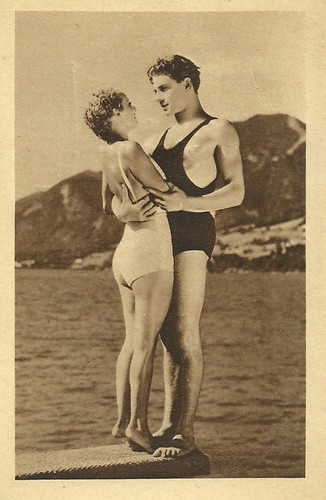
French postcard by Imprimerie A. Breger Frères, Paris. Issued for the cinema Max-Linder Pathé, 24, Boulevard Poissonière, Paris, where the film was presented 14-20 September 1934. Lac au dames/Ladies Lake (1934) was directed by Marc Allégret and starred Jean-Pierre Aumont , Rosine Dérean , Simone Simon and Michel Simon . Lac aux dames is situated at Lake Konstanz. In Germany, the film was presented as Hell in Frauensee ('Frauensee' was the title of the novel by Vicki Baum the film was based on). The actress whom Aumont is holding in his arms, is Rosine Dérean .
Never say never
As far as French sources are concerned, I would like to quote an article from Ciné Miroir of October 1933 which confirms that Ila Meery is indeed Hungarian. Under the title 'Illa Meery, blonde vedette', it is an interview with the actress who declares, among other things, that she has just finished shooting Lac aux dames. About the actress, the journalist writes: "She has kept from her Hungarian origins a special way of pronouncing the 'r' or of wetting the 'l'...".
For the sake of anecdote, I will quote another interview in a July 1934 Cinémonde magazine in which Ila Meery is asked if she will shoot naked again after stripping off in Lac aux dames, to which she replies that she will never do it again. The article then ends with a pertinent and malicious remark by the journalist who reminds us that she had already shown her breasts in Cagliostro. It is worth noting that this ironic comment by the author of the article was premonitory, as Ila Meery did it again in Zouzou. So here again we see that we are dealing with the same woman who appears in the Hungarian magazines.
Now you know that Ila Meery has nothing to do with the disreputable character that was Mara Tchernycheff Bezobrazoff. Of course, I know I'm going against what mammoths like IMDb , Wikipedia and other sites have told this without any verification. But nothing ventured, nothing gained. In any case, I would have done my best to rehabilitate Ila Meery, a pretty Hungarian actress who is wrongly confused with a "Gestapo countess". She certainly didn't deserve that.
For those of you who are interested in the sinister Mara Chernycheff Bezobrazoff, two grey areas remain:
1) When was she first mistaken for Ila Meery? At the time of her marriage to Henri Garat ? At the time of her legal troubles in the 1940s? When Cyril Eder's book was written? At another time? I don't know...
2) We know, from Jean-Pierre Aumont , that Tchernycheff Bezobrazoff was in Lac aux dames. However, her name does not appear in the credits. We can put forward two hypotheses:
a) That she had such a small role that she was not even mentioned in the credits.
b) Why not take an interest in the actress who plays the innkeeper Vefi, a certain Marulka, a pseudonym with a very Slavic sounding name? Nothing is known about her: no real name, no date of birth or death. In any case, it seems that Lac aux dames is the only title in her filmography.
This seems to me to be an interesting lead for two reasons:
- Jean-Pierre Aumont speaks in his memoirs of "Maruska Bésobrasoff". Maruska, Maroulka, ... one will agree that the sounds are very close.
- We know from Cyril Eder that, in 1943, Tchernycheff was briefly arrested for having facilitated the escape to Spain of Hélène Ostrowska, wife of the jeweller of Jewish origin Louis Arpels.
However, I have the book 'A Countess in Limbo', which contains extracts from the diary kept during the Second World War by Countess Olga Hendrikoff, a refugee in France after the 1917 Revolution. For the year 1943, the countess mentions, in particular, a "Maroulka Tchernychew" who was arrested, but quickly released, for having taken a "Madame Ostrowska" across the Spanish border. It is clear that Maroulka Tchernychew and Mara Tchernycheff are the same person. It seems, therefore, that for some members of the Russian diaspora, Mara Chernycheff was known by the name/nickname of "Maroulka". Disturbing ... I have the impression that there is a strong possibility that the Marulka of Lac aux dames and Mara Chernycheff Bezobrazoff are one and the same.
Lac au dames/Ladies Lake (1934). No subtitles! Source: FWIW (YouTube).
Text: Marlene Pilaete. Thank you Mrs. Sherlock for this guest post! And below follows the original French text.
Le cas Il(l)a Meery
Je voudrais vous parler aujourd’hui d’une longue enquête que j’ai menée concernant l’actrice Il(l)a Meery. J’utiliserai dans mon texte l’orthographe «Ila Meery», bien que les variantes «Illa» et «Mery» aient parfois aussi été utilisées. Comme vous vous en rendrez compte, ce travail m’a apporté son lot de surprises et ses conclusions vont à l’encontre de ce qui est mentionné dans de nombreuses sources.
Tout a commencé il y a quelques années, lorsqu’a été présenté à la télévision un documentaire dont je ne me rappelle plus le nom. Durant sa diffusion, J’ai vu apparaître sur l’écran le visage d’Ila Meery, que l’on présentait comme une des épouses d’Henri Garat et comme une collaborationniste durant l’Occupation.
Je connaissais Ila Meery et l’avais vue dans quelques films mais j’ignorais ces détails. J’ai donc décidé de faire des recherches plus approfondies à son sujet. J’ai d’abord découvert que cette information était développée dans un livre intitulé «Les comtesses de la gestapo» de Cyril Eder. Je me suis procurée cet ouvrage et ai lu avec intérêt le chapitre consacré à la comtesse d’origine russe Mara (aussi Marie ou Maria) Tchernycheff Bezobrazoff qui, selon l’auteur, avait fait du cinéma sous le nom d’Illa Meery, avait notamment incarné Anika dans le film «Lac aux dames» (1934), avait été mariée à Henri Garat de 1939 à 1942, avait, durant l’Occupation, collaboré avec les Allemands, avait été, après-guerre, condamnée pour ses agissements et s’était finalement exilée aux Etats-Unis. De nombreux sites Internet reprennent d’ailleurs ces affirmations. J’ajouterai que, comme c’est souvent le cas avec des patronymes russes, «Tchernycheff» et «Bezobrazoff» se retrouvent transcrits avec des orthographes différentes selon les sources.
Cette aristocrate est née le 16 mai 1915 à Moscou, date mentionnée sur son acte de mariage parisien. Aux U.S.A., où elle est décédée le 18 décembre 2010, elle semble s’être rajeunie d’une année d’après le fichier des décès de la Sécurité Sociale américaine. Sa vie mouvementée était très bien racontée dans le livre mais une phrase a suscité mon étonnement : après avoir indiqué que Mara Tchernycheff Bezobrazoff suit une scolarité normale à Paris durant les années 20, l’auteur écrit : «On perd sa trace jusqu’en 1932». Or, je savais qu’Ila Meery avait été une vedette du cinéma germanique à la fin des années 20, un fait connu et documenté dans de nombreuses sources. C‘était là le point de départ de mon investigation.
Je me suis alors renseignée sur son film muet le plus célèbre, «Cagliostro», dans lequel elle incarne la Comtesse de la Motte et dévoile allègrement sa poitrine, et en ai trouvé la date de la première projection à Berlin, le 8 avril 1929. Or, à cette date, Mara Tchernycheff Bezobrazoff n’était âgée que de 13 ans (!!!). J’ai trouvé cela plutôt étrange qu’on confie un tel rôle à une fille aussi jeune. J’ajoute que « Cagliostro » n’était pas sa première apparition à l’écran, puisque l’avaient précédées deux productions allemandes de 1928 : «Prinzessin Olala» et «Der raub der Sabinerinnen». Pourquoi la firme berlinoise «Super-Film GmbH» avait-elle engagé une petite collégienne parisienne inconnue et inexpérimentée pour tourner ces deux premiers films outre-Rhin ?
Comme Mara Tchernycheff Bezobrazoff avait été l’épouse d’Henri Garat, j’ai bien examiné sur la page que Christian Grenier avait consacré à l’acteur la photo du mariage et, franchement, je n’ai pas vraiment reconnu, sous les traits de la brunette accrochée au bras de Garat, la bombe blonde de «Lac aux dames». J’ai eu la même impression en voyant une photo prise lors de son procès en collaboration.
Voulant en avoir le cœur net, je me suis adressée au regretté Yvan Foucart, qui connaissait bien Jean-Pierre Aumont, la vedette masculine de «Lac aux dames», afin de lui demander son avis sur la question. Yvan m’a alors fourni une phrase extraite de «Souvenirs provisoires», l’ouvrage autobiographique de Jean-Pierre Aumont paru en 1957, dans lequel celui-ci évoque ainsi le tournage de «Lac aux dames» : «Nous nous roulions dans la paille, nous grimpions aux arbres, nous fendions le lac immaculé, entourés de filles aussi belles que Maruska Bésobrasoff et Illa Méry». Tout devenait plus clair, Jean-Pierre Aumont avait donc parmi ses partenaires féminines de «Lac aux dames» une comédienne nommée Ila Meery et une autre nommée Bésobrasoff. Il s’agissait bien de deux personnes distinctes.
J’ai dès lors intensifié mes recherches qui m’ont menée en Hongrie. En effet, un document en double langue, hongroise et anglaise, consacré au cinéma d’animation hongrois m’a mise sur la piste. On peut y lire que, dans la seconde moitié des années 30, Janos Halasz (= John Halas) avait signé un contrat en Angleterre avec un certain James Willing. Voici la phrase : «… a financier named James Willing, through the good offices of his Hungarian wife , Ila Mecséry (Ila Meery), signed a contract with him to make four advertisements and two feature films annually». Je traduis : «… un homme d’affaires du nom de James Willing, grâce aux bons offices de son épouse hongroise, Ila Mecséry (Ila Meery), a signé un contrat avec lui pour produire quatre films publicitaires et deux longs-métrages par an».
J’ai ainsi découvert l’existence de l’actrice Ila Mecséry. Il me restait dès lors à me tourner vers les sources hongroises qui se sont révélées déterminantes. J’ai pu visualiser son acte de naissance. Elle est venue au monde, sous le nom d’Ilona Mecséry, à Körmend, dans le département de Vas, le 31 août 1908. Concernant sa date de décès, j’ai trouvé quelques sources hongroises qui mentionnent 1974 mais, n’ayant pas, au contraire de son certificat de naissance, pu visualiser un acte officiel, je donne cette date sous toute réserve.
J’ai pu reconstituer le parcours professionnel de cette actrice. J’ai appris que, durant sa carrière, elle avait utilisé les noms «Ila Mecsery» (surtout dans son pays natal) et sa version abrégée, «Ila Meery», «Meery» étant tout simplement la contraction de son nom de famille «Mecsery», sans le «c» et le «s». Il y a même eu la variante «Ilena Meery» pour «Cagliostro». J’ai consulté de nombreuses revues et journaux hongrois de l’époque. En voici plusieurs exemples : Dans le Magazine «Szinhazi Elet», numéro 49 de l’année 1925 , en page 32, figure une photo d’un groupe de girls jouant à l’époque dans l’opérette «Alexandra» d’Albert Szirmai. au Théâtre Royal de Budapest . La légende cite Les noms des jeunes filles, notamment ceux d’Ilona Mecséry et d’une autre future vedette, Rozsi Barsony. Dans le magazine «Szinhazi Elet», numéro 13 de l’année 1928, un article lui est consacré. Celui-ci relate que, à la suite d’un concours, Ila Mecséry, âgée de 19 ans, a été élue la plus jolie girl de Budapest et a remporté le premier prix, un bracelet en or. La jeune femme déclare que son prochain objectif est de faire du cinéma.
Dans un article consacré à l’actrice paru en page 7 du magazine «a Hét» du 3 août 1928, on évoque son contrat avec la compagnie allemande «Super Film GmbH» et notamment le film «Prinzessin Olala» avec, je cite, «Ila Meery, alias Ila Mecsery, qui jouait l’année dernière au Théâtre Royal». J’ai aussi découvert une interview d’Ila Mecsery dans le numéro 7 de l’année 1929 du magazine «Szinhazi Elet». Sur deux pages, on y voit des images de l’actrice à ses débuts comme girl de théâtre ainsi qu’une photo d’elle dans le film «Cagliostro». Elle y parle de ses années de scène et évoque le tournage de «Cagliostro».
Le journal «Nyirvidék» du 3 septembre 1931 informe le public de la présentation, au cinéma Varosi, du film allemand «Das Weisse Paradies» , avec «la star hongroise Ila Mecséry». En décembre 1934, le journal «Függetlenség» évoque la «blonde platine Ila Mecséry, ancienne chorus-girl au Théâtre Royal, qui a réussi au cinéma à l’étranger». Concernant «Lac aux dames», en page 4 du journal «Papai Hirlap» du 26 janvier 1935, on annonce la présentation au cinéma «Jokai» du film «Hell Meg a Nok (le titre du film lorsqu’il est sorti en Hongrie) les 29 et 30 janvier. Quatre noms d’acteurs faisant partie de la distribution sont cités : Simone Simon Jean-Pierre Aumont, Ila Mecsery et Wladimir Sokoloff.
Dans un magazine hongrois «A film» de novembre 1935, j’ai déniché une critique du film «Zouzou» qui, après avoir cité Josephine Baker, mentionne dans la distribution «Ila Meery (a magyar Mecséry Ila) és Jean Gabin», ce qui signifie «Ila Meery (la Hongroise Ila Mecséry) et Jean Gabin». Dans la même veine, un article paru en 1935 dans le journal «Pragai Magyar Hirlap» parle aussi du film «Zouzou» et mentionne dans la distribution «la Hongroise Ila Meery».
Dans un autre article du magazine «Szinhazi Elet» consacré à la comédienne, cette fois dans le numéro 19 de l’année 1938, on la voit dans sa résidence londonienne, aux côtés de son mari, le britannique James Willing, et on y évoque son passage au théâtre Royal de Budapest en compagnie de Roszi Barsony et son parcours passé dans les studios de cinéma. On y parle aussi de la compagnie «British Colour Cartoon Film Ltd», qui n’est autre que la firme devant produire les dessins animés du précité Janos Halasz.
Concernant James Willing, j’ai pu voir, dans un registre de mariages de 1937, l’enregistrement de l’union, dans le district londonien de Pancras, de James O.H. WIlling avec la nommée «Mecséry». J’ajoute que cet homme, qui s’était engagé dans l’aviation anglaise, est mort au combat en 1941.
Mes recherches m’ont en outre appris qu’Ila Meery était apparue un film hongrois durant sa carrière. Il s’agit de «Tisztelet a kivételnek» (1936), qu’elle a tourné sous le nom d’Ila Mecséry. J’ai pu visionner ce film et la blonde actrice hongroise qui joue le rôle de Baba dans «Tisztelet a kivételnek» est bien la même qui joue le rôle d’ Anika dans «Lac aux dames», de Miss Barbara dans «Zouzou», de Vilma dans «Pension Mimosas» et de Jacqueline dans «Marius et Olive à Paris». Du côté des sources françaises, je voudrais vous citer un article extrait d’un magazine Ciné Miroir d’octobre 1933 qui confirme qu’Ila Meery est bien hongroise. Il s’agit, sous le titre «Illa Meery, blonde vedette», d’une interview de la comédienne qui déclare, notamment, qu’elle vient de terminer le tournage de «Lac aux dames». Au sujet de l’actrice, le journaliste écrit ceci : «Elle a conservé de ses origines hongroises une façon spéciale de prononcer en les roulant les «r» ou bien de mouiller les «l»...»
Pour l’anecdote, je citerai une autre interview parue dans un magazine Cinémonde de juillet 1934 au cours de laquelle on demande à Ila Meery si elle tournera à nouveau nue après s’être dévêtue dans «Lac aux dames», ce à quoi elle répond qu’elle ne le fera plus jamais. L’article se termine alors sur une remarque pertinente et malicieuse du journaliste qui rappelle qu’elle avait déjà montré sa poitrine dans «Cagliostro». On notera d’ailleurs que le petit commentaire ironique de l’auteur de l’article se révèlera prémonitoire car Ila Meery récidivera dans «Zouzou». On voit donc encore ici qu’on a bien affaire à la même femme qui figure dans les magazines hongrois.
Voilà, vous aurez maintenant compris qu’Ila Meery n’a rien à voir avec le personnage peu recommandable qu’était Mara Tchernycheff Bezobrazoff. Vous pourrez donc, illustrée de deux cartes postales anciennes de ma collection, découvrir une mini-bio d’Ila Meery. Evidemment, je sais que je vais à l’encontre de ce que racontent des mammouths comme I.M.D.B., Wikipedia et autres sites qui se sont tous inspirés les uns des autres sans faire aucune vérification. Mais qui ne tente rien n’a rien. J’aurai en tout cas fait tout mon possible pour réhabiliter Ila Meery, une jolie comédienne hongroise qui, à tort, est confondue avec une «comtesse de la Gestapo». Elle ne méritait en tout cas pas ça.
Pour ceux d’entre vous qui s’intéresseraient à la sinistre Mara Tchernycheff Bezobrazoff, deux zones d’ombre subsistent à son sujet : 1) A partir de quelle date a-t-on commencé à la confondre avec Ila Meery ? Au moment de son mariage avec Henri Garat ? Au moment de ses ennuis judiciaires des années 40 ? Au moment de l’écriture du livre de Cyril Eder ? A un autre moment ? Je l’ignore … 2) On sait, par Jean-Pierre Aumont, que Tchernycheff Bezobrazoff a tourné dans «Lac aux dames». Or, son nom ne figure pas au générique. On peut émettre deux hypothèses : a) Qu’elle tienne un si petit rôle qu’on n’ait même pas jugé bon de la mentionner au générique. b) Pourquoi ne pas s’intéresser à l’actrice qui joue le rôle de l’aubergiste Véfi, une certaine Maroulka, pseudonyme aux consonances bien slaves ? On ne sait rien à son propos : ni véritable nom, ni date de naissance ou de décès. Il semble en tout cas que «Lac aux dames» soit le seul titre de sa filmographie.
Cette piste me semble intéressante pour deux raisons : - Jean-Pierre Aumont parle dans ses mémoires de «Maruska Bésobrasoff». Maruska, Maroulka, … on conviendra que les sonorités sont très proches. - On sait, par Cyril Eder, que, en 1943, Tchernycheff a été brièvement arrêtée pour avoir favorisé la fuite en Espagne d’Hélène Ostrowska, épouse du joailler d’origine juive Louis Arpels. Or, je possède le livre «A Countess in Limbo», qui rassemble les extraits du journal tenu durant la seconde guerre mondiale par la comtesse Olga Hendrikoff, réfugiée en France après la Révolution de 1917. Pour l’année 1943, la comtesse évoque notamment une «Maroulka Tchernychew» arrêtée, mais libérée assez vite, pour avoir fait passer la frontière espagnole à une «Madame Ostrowska». On aura compris que Maroulka Tchernychew et Mara Tchernycheff sont la même personne. Il semble donc, que, pour certains membres de la diaspora russe, Mara Tchernycheff ait été connue sous le nom / surnom de «Maroulka». Troublant … j’ai l’impression qu’il y a de fortes chances pour que la Maroulka de «Lac aux dames» et Mara Tchernycheff Bezobrazoff ne fassent qu’une.

French postcard by Editions Chantal, no. 56. Photo: Arnal, Paris.
Two different persons
I would like to tell you today about a long investigation I have been conducting concerning the actress Il(l)a Meery. I will use the spelling "Ila Meery" in my text, although the variants "Illa" and "Mery" have sometimes been used. As you can see, this work has brought me a lot of surprises and its conclusions go against what is mentioned in many sources. It all started a few years ago when a documentary was shown on television, the name of which I cannot remember. During its broadcast, I saw the face of Ila Meery appear on the screen, who was presented as one of Henri Garat 's wives and as a collaborationist during the Occupation. I knew Ila Meery and had seen her in a few films but I didn't know these details. So I decided to research her further.
I first discovered that this information was developed in a book called 'Les comtesses de la gestapo' (The Gestapo Countesses) by Cyril Eder. I bought this book and read with interest the chapter on the Russian-born countess Mara (also Marie or Maria) Tchernycheff Bezobrazoff who, according to the author, had made films under the name Illa Meery, had played Anika in the film Lac au dames/Ladies Lake (Mrc Allégret, 1934), was married to Henri Garat from 1939 to 1942, had collaborated with the Germans during the Occupation, had been condemned after the war for her actions and had finally been exiled to the United States. Numerous Internet sites have repeated these statements.
I would add that, as is often the case with Russian surnames, 'Chernycheff' and 'Bezobrazoff' are transcribed with different spellings depending on the source. This aristocrat was born on 16 May 1915 in Moscow, the date mentioned on her Parisian marriage certificate. In the U.S.A., where she died on 18 December 2010, she appears to have turned one year younger according to the American Social Security death records. Her eventful life was very well told in the book, but one sentence raised my surprise: after indicating that Mara Tchernycheff Bezobrazoff followed normal schooling in Paris during the 1920s, the author wrote: "We lose track of her until 1932". I knew that Ila Meery had been a German film star in the late 1920s, a fact known and documented in many sources. This was the starting point of my investigation.
I then looked up her most famous silent film, Cagliostro - Liebe und Leben eines großen Abenteurers/Cagliostro (Richard Oswald, 1929), in which she played the Countess de la Motte and cheerfully revealed her breasts, and found the date of the first screening in Berlin, 8 April 1929. On that date, Mara Tchernycheff Bezobrazoff was only 13 years old (!!!). I found it rather strange that such a young girl was given such a role. I should add that Cagliostro was not her first screen appearance, since it was preceded by two German productions from 1928: Prinzessin Olala/Art of Love (Robert Land, 1928) and Der raub der Sabinerinnen/The Rape of the Sabine Women (Robert Land, 1928). Why did the Berlin company Super-Film GmbH hire an unknown and inexperienced Parisian schoolgirl to shoot these two first films in Germany?
As Mara Tchernycheff Bezobrazoff had been Henri Garat 's wife, I had a good look at the page Christian Grenier had dedicated at L’Encinémathèque to the actor, and, frankly, I didn't really recognise the blonde bombshell of Lac aux dames under the features of the brunette hanging on Garat's arm. I had the same impression when I saw a photo taken during her collaboration trial. Wanting to know for sure, I asked the late Yvan Foucart, who knew Jean-Pierre Aumont , the male star of Lac au dames, for his opinion on the matter. Yvan gave me a sentence from 'Souvenirs provisoires' (Temporary memories), Jean-Pierre Aumont 's autobiographical book published in 1957, in which he recalls the shooting of Lac aux dames: "We rolled in the straw, climbed trees, split the immaculate lake, surrounded by girls as beautiful as Maruska Bésobrasoff and Illa Méry". Everything became clearer, Jean-Pierre Aumont had among his female partners in Lac aux dames an actress named Ila Meery and another named Bésobrasoff. They were indeed two different people.

German postcard by Ross Verlag, no. 3638/1, 1928-1929. Photo: Atelier Schrecker, Berlin. Collection: Marlène Pilaete.
The prettiest girl in Budapest
I then intensified my research which led me to Hungary. Indeed, a document in two languages, Hungarian and English, dedicated to Hungarian animated films put me on a track. It says that in the second half of the 1930s, Janos Halasz (John Halas) signed a contract in England with a certain James Willing. Here is the sentence: "... a financier named James Willing, through the good offices of his Hungarian wife, Ila Mecséry (Ila Meery), signed a contract with him to make four advertisements and two feature films annually". I thus discovered the existence of the actress Ila Mecséry. I then had to turn to Hungarian sources, which proved to be decisive. I was able to see her birth certificate. She was born as Ilona Mecséry in Körmend, Vas County, on 31 August 1908. Concerning her date of death, I have found some Hungarian sources which mention 1974 but, as I was not able to view an official record, unlike her birth certificate, I give this date with reservations.
Then I was able to reconstruct the professional career of this actress. I learned that during her career she used the name "Ila Mecsery" (especially in her native country) and its shortened version, 'Ila Meery', 'Meery' being simply the contraction of her surname 'Mecsery', without the 'c' and 's'. There was even the variant 'Ilena Meery' for Cagliostro. I also consulted many Hungarian magazines and newspapers of the time. Here are some examples: in the Magazine Szinhazi Elet, number 49 of the year 1925, on page 32, there is a photo of a group of girls performing in the operetta 'Alexandra' by Albert Szirmai at the Royal Theatre in Budapest. The caption mentions the names of the girls, including Ilona Mecséry and another future star, Rozsi Barsony (Rose Barsony). In Szinhazi Elet, number 13 of 1928, an article is dedicated to her. It reports that 19-year-old Ila Mecséry was voted the prettiest girl in Budapest in a contest and won the first prize, a gold bracelet. The young woman says that her next goal is to become a film actress.
In an article about the actress on page 7 of the magazine a Hét of 3 August 1928, there is mention of her contract with the German company Super Film GmbH and in particular, the film Prinzessin Olala with "Ila Meery, alias Ila Mecsery, who played last year at the Royal Theatre". I also found an interview with Ila Mecsery in a 1929 issue of the magazine Szinhazi Elet. On two pages there are pictures of the actress in her early days as a theatre girl and a picture of her in the film Cagliostro. She talks about her years on stage and about the shooting of Cagliostro.
The newspaper Nyirvidék of 3 September 1931 informs the public about the presentation of the German film Das Weisse Paradies in the Varosi cinema, with "the Hungarian star Ila Mecséry". In December 1934, the newspaper Függetlenség mentions the "platinum blonde Ila Mecséry, a former chorus girl at the Royal Theatre, who has been successful in the cinema abroad". Concerning Lac au dames/Ladies Lake (Marc Allégret, 1934), on page 4 of the newspaper Papai Hirlap of 26 January 1935, it is announced that the film Hell Meg a Nok (the title of the film when it was released in Hungary) will be shown at the Jokai cinema on 29 and 30 January. Four names of actors in the cast are mentioned: Simone Simon , Jean-Pierre Aumont , Ila Mecsery, and Wladimir Sokoloff.
In the Hungarian magazine A film of November 1935, I found a review of the film Zouzou which, after mentioning Josephine Baker , also mentions in the cast "Ila Meery (a magyar Mecséry Ila) és Jean Gabin ". In the same vein, a 1935 article in the newspaper Pragai Magyar Hirlap also refers to the film Zouzou and mentions "Hungarian Ila Meery" in the cast. In another article in Szinhazi Elet, number 19 of 1938, we see her in her London residence, together with her husband, the British James Willing, and she talks about her time at the Royal Theatre in Budapest with Roszi Barsony and her past experience in the film studios. She also talks about the company British Colour Cartoon Film Ltd, which is none other than the company that produces the cartoons of the aforementioned Janos Halasz.
Concerning James Willing, I was able to see, in a marriage register of 1937, the registration of the union, in the London district of Pancras, of James O.H. Willing with "Mecséry". I add that this man, who had joined the British Air Force, died in combat in 1941. My research has also taught me that Ila Meery appeared in a Hungarian film during her career. It was Tisztelet a kivételnek/There Are Exceptions (Ákos Ráthonyi, 1936), with Imre Ráday and Klári Tolnay , which she made under the name Ila Mecséry. I was able to watch this film and the blonde Hungarian actress who plays the role of Baba in Tisztelet a kivételnek is the same one who plays the role of Anika in Lac aux dames, of Miss Barbara in Zouzou (Marc Allégret, 1934), of Vilma in Pension Mimosas (Jacques Feyder, 1935) and of Jacqueline in Marius et Olive à Paris/Marius and Olive in Paris (Jean Epstein, 1935).

French postcard by Imprimerie A. Breger Frères, Paris. Issued for the cinema Max-Linder Pathé, 24, Boulevard Poissonière, Paris, where the film was presented 14-20 September 1934. Lac au dames/Ladies Lake (1934) was directed by Marc Allégret and starred Jean-Pierre Aumont , Rosine Dérean , Simone Simon and Michel Simon . Lac aux dames is situated at Lake Konstanz. In Germany, the film was presented as Hell in Frauensee ('Frauensee' was the title of the novel by Vicki Baum the film was based on). The actress whom Aumont is holding in his arms, is Rosine Dérean .
Never say never
As far as French sources are concerned, I would like to quote an article from Ciné Miroir of October 1933 which confirms that Ila Meery is indeed Hungarian. Under the title 'Illa Meery, blonde vedette', it is an interview with the actress who declares, among other things, that she has just finished shooting Lac aux dames. About the actress, the journalist writes: "She has kept from her Hungarian origins a special way of pronouncing the 'r' or of wetting the 'l'...".
For the sake of anecdote, I will quote another interview in a July 1934 Cinémonde magazine in which Ila Meery is asked if she will shoot naked again after stripping off in Lac aux dames, to which she replies that she will never do it again. The article then ends with a pertinent and malicious remark by the journalist who reminds us that she had already shown her breasts in Cagliostro. It is worth noting that this ironic comment by the author of the article was premonitory, as Ila Meery did it again in Zouzou. So here again we see that we are dealing with the same woman who appears in the Hungarian magazines.
Now you know that Ila Meery has nothing to do with the disreputable character that was Mara Tchernycheff Bezobrazoff. Of course, I know I'm going against what mammoths like IMDb , Wikipedia and other sites have told this without any verification. But nothing ventured, nothing gained. In any case, I would have done my best to rehabilitate Ila Meery, a pretty Hungarian actress who is wrongly confused with a "Gestapo countess". She certainly didn't deserve that.
For those of you who are interested in the sinister Mara Chernycheff Bezobrazoff, two grey areas remain:
1) When was she first mistaken for Ila Meery? At the time of her marriage to Henri Garat ? At the time of her legal troubles in the 1940s? When Cyril Eder's book was written? At another time? I don't know...
2) We know, from Jean-Pierre Aumont , that Tchernycheff Bezobrazoff was in Lac aux dames. However, her name does not appear in the credits. We can put forward two hypotheses:
a) That she had such a small role that she was not even mentioned in the credits.
b) Why not take an interest in the actress who plays the innkeeper Vefi, a certain Marulka, a pseudonym with a very Slavic sounding name? Nothing is known about her: no real name, no date of birth or death. In any case, it seems that Lac aux dames is the only title in her filmography.
This seems to me to be an interesting lead for two reasons:
- Jean-Pierre Aumont speaks in his memoirs of "Maruska Bésobrasoff". Maruska, Maroulka, ... one will agree that the sounds are very close.
- We know from Cyril Eder that, in 1943, Tchernycheff was briefly arrested for having facilitated the escape to Spain of Hélène Ostrowska, wife of the jeweller of Jewish origin Louis Arpels.
However, I have the book 'A Countess in Limbo', which contains extracts from the diary kept during the Second World War by Countess Olga Hendrikoff, a refugee in France after the 1917 Revolution. For the year 1943, the countess mentions, in particular, a "Maroulka Tchernychew" who was arrested, but quickly released, for having taken a "Madame Ostrowska" across the Spanish border. It is clear that Maroulka Tchernychew and Mara Tchernycheff are the same person. It seems, therefore, that for some members of the Russian diaspora, Mara Chernycheff was known by the name/nickname of "Maroulka". Disturbing ... I have the impression that there is a strong possibility that the Marulka of Lac aux dames and Mara Chernycheff Bezobrazoff are one and the same.
Lac au dames/Ladies Lake (1934). No subtitles! Source: FWIW (YouTube).
Text: Marlene Pilaete. Thank you Mrs. Sherlock for this guest post! And below follows the original French text.
Le cas Il(l)a Meery
Je voudrais vous parler aujourd’hui d’une longue enquête que j’ai menée concernant l’actrice Il(l)a Meery. J’utiliserai dans mon texte l’orthographe «Ila Meery», bien que les variantes «Illa» et «Mery» aient parfois aussi été utilisées. Comme vous vous en rendrez compte, ce travail m’a apporté son lot de surprises et ses conclusions vont à l’encontre de ce qui est mentionné dans de nombreuses sources.
Tout a commencé il y a quelques années, lorsqu’a été présenté à la télévision un documentaire dont je ne me rappelle plus le nom. Durant sa diffusion, J’ai vu apparaître sur l’écran le visage d’Ila Meery, que l’on présentait comme une des épouses d’Henri Garat et comme une collaborationniste durant l’Occupation.
Je connaissais Ila Meery et l’avais vue dans quelques films mais j’ignorais ces détails. J’ai donc décidé de faire des recherches plus approfondies à son sujet. J’ai d’abord découvert que cette information était développée dans un livre intitulé «Les comtesses de la gestapo» de Cyril Eder. Je me suis procurée cet ouvrage et ai lu avec intérêt le chapitre consacré à la comtesse d’origine russe Mara (aussi Marie ou Maria) Tchernycheff Bezobrazoff qui, selon l’auteur, avait fait du cinéma sous le nom d’Illa Meery, avait notamment incarné Anika dans le film «Lac aux dames» (1934), avait été mariée à Henri Garat de 1939 à 1942, avait, durant l’Occupation, collaboré avec les Allemands, avait été, après-guerre, condamnée pour ses agissements et s’était finalement exilée aux Etats-Unis. De nombreux sites Internet reprennent d’ailleurs ces affirmations. J’ajouterai que, comme c’est souvent le cas avec des patronymes russes, «Tchernycheff» et «Bezobrazoff» se retrouvent transcrits avec des orthographes différentes selon les sources.
Cette aristocrate est née le 16 mai 1915 à Moscou, date mentionnée sur son acte de mariage parisien. Aux U.S.A., où elle est décédée le 18 décembre 2010, elle semble s’être rajeunie d’une année d’après le fichier des décès de la Sécurité Sociale américaine. Sa vie mouvementée était très bien racontée dans le livre mais une phrase a suscité mon étonnement : après avoir indiqué que Mara Tchernycheff Bezobrazoff suit une scolarité normale à Paris durant les années 20, l’auteur écrit : «On perd sa trace jusqu’en 1932». Or, je savais qu’Ila Meery avait été une vedette du cinéma germanique à la fin des années 20, un fait connu et documenté dans de nombreuses sources. C‘était là le point de départ de mon investigation.
Je me suis alors renseignée sur son film muet le plus célèbre, «Cagliostro», dans lequel elle incarne la Comtesse de la Motte et dévoile allègrement sa poitrine, et en ai trouvé la date de la première projection à Berlin, le 8 avril 1929. Or, à cette date, Mara Tchernycheff Bezobrazoff n’était âgée que de 13 ans (!!!). J’ai trouvé cela plutôt étrange qu’on confie un tel rôle à une fille aussi jeune. J’ajoute que « Cagliostro » n’était pas sa première apparition à l’écran, puisque l’avaient précédées deux productions allemandes de 1928 : «Prinzessin Olala» et «Der raub der Sabinerinnen». Pourquoi la firme berlinoise «Super-Film GmbH» avait-elle engagé une petite collégienne parisienne inconnue et inexpérimentée pour tourner ces deux premiers films outre-Rhin ?
Comme Mara Tchernycheff Bezobrazoff avait été l’épouse d’Henri Garat, j’ai bien examiné sur la page que Christian Grenier avait consacré à l’acteur la photo du mariage et, franchement, je n’ai pas vraiment reconnu, sous les traits de la brunette accrochée au bras de Garat, la bombe blonde de «Lac aux dames». J’ai eu la même impression en voyant une photo prise lors de son procès en collaboration.
Voulant en avoir le cœur net, je me suis adressée au regretté Yvan Foucart, qui connaissait bien Jean-Pierre Aumont, la vedette masculine de «Lac aux dames», afin de lui demander son avis sur la question. Yvan m’a alors fourni une phrase extraite de «Souvenirs provisoires», l’ouvrage autobiographique de Jean-Pierre Aumont paru en 1957, dans lequel celui-ci évoque ainsi le tournage de «Lac aux dames» : «Nous nous roulions dans la paille, nous grimpions aux arbres, nous fendions le lac immaculé, entourés de filles aussi belles que Maruska Bésobrasoff et Illa Méry». Tout devenait plus clair, Jean-Pierre Aumont avait donc parmi ses partenaires féminines de «Lac aux dames» une comédienne nommée Ila Meery et une autre nommée Bésobrasoff. Il s’agissait bien de deux personnes distinctes.
J’ai dès lors intensifié mes recherches qui m’ont menée en Hongrie. En effet, un document en double langue, hongroise et anglaise, consacré au cinéma d’animation hongrois m’a mise sur la piste. On peut y lire que, dans la seconde moitié des années 30, Janos Halasz (= John Halas) avait signé un contrat en Angleterre avec un certain James Willing. Voici la phrase : «… a financier named James Willing, through the good offices of his Hungarian wife , Ila Mecséry (Ila Meery), signed a contract with him to make four advertisements and two feature films annually». Je traduis : «… un homme d’affaires du nom de James Willing, grâce aux bons offices de son épouse hongroise, Ila Mecséry (Ila Meery), a signé un contrat avec lui pour produire quatre films publicitaires et deux longs-métrages par an».
J’ai ainsi découvert l’existence de l’actrice Ila Mecséry. Il me restait dès lors à me tourner vers les sources hongroises qui se sont révélées déterminantes. J’ai pu visualiser son acte de naissance. Elle est venue au monde, sous le nom d’Ilona Mecséry, à Körmend, dans le département de Vas, le 31 août 1908. Concernant sa date de décès, j’ai trouvé quelques sources hongroises qui mentionnent 1974 mais, n’ayant pas, au contraire de son certificat de naissance, pu visualiser un acte officiel, je donne cette date sous toute réserve.
J’ai pu reconstituer le parcours professionnel de cette actrice. J’ai appris que, durant sa carrière, elle avait utilisé les noms «Ila Mecsery» (surtout dans son pays natal) et sa version abrégée, «Ila Meery», «Meery» étant tout simplement la contraction de son nom de famille «Mecsery», sans le «c» et le «s». Il y a même eu la variante «Ilena Meery» pour «Cagliostro». J’ai consulté de nombreuses revues et journaux hongrois de l’époque. En voici plusieurs exemples : Dans le Magazine «Szinhazi Elet», numéro 49 de l’année 1925 , en page 32, figure une photo d’un groupe de girls jouant à l’époque dans l’opérette «Alexandra» d’Albert Szirmai. au Théâtre Royal de Budapest . La légende cite Les noms des jeunes filles, notamment ceux d’Ilona Mecséry et d’une autre future vedette, Rozsi Barsony. Dans le magazine «Szinhazi Elet», numéro 13 de l’année 1928, un article lui est consacré. Celui-ci relate que, à la suite d’un concours, Ila Mecséry, âgée de 19 ans, a été élue la plus jolie girl de Budapest et a remporté le premier prix, un bracelet en or. La jeune femme déclare que son prochain objectif est de faire du cinéma.
Dans un article consacré à l’actrice paru en page 7 du magazine «a Hét» du 3 août 1928, on évoque son contrat avec la compagnie allemande «Super Film GmbH» et notamment le film «Prinzessin Olala» avec, je cite, «Ila Meery, alias Ila Mecsery, qui jouait l’année dernière au Théâtre Royal». J’ai aussi découvert une interview d’Ila Mecsery dans le numéro 7 de l’année 1929 du magazine «Szinhazi Elet». Sur deux pages, on y voit des images de l’actrice à ses débuts comme girl de théâtre ainsi qu’une photo d’elle dans le film «Cagliostro». Elle y parle de ses années de scène et évoque le tournage de «Cagliostro».
Le journal «Nyirvidék» du 3 septembre 1931 informe le public de la présentation, au cinéma Varosi, du film allemand «Das Weisse Paradies» , avec «la star hongroise Ila Mecséry». En décembre 1934, le journal «Függetlenség» évoque la «blonde platine Ila Mecséry, ancienne chorus-girl au Théâtre Royal, qui a réussi au cinéma à l’étranger». Concernant «Lac aux dames», en page 4 du journal «Papai Hirlap» du 26 janvier 1935, on annonce la présentation au cinéma «Jokai» du film «Hell Meg a Nok (le titre du film lorsqu’il est sorti en Hongrie) les 29 et 30 janvier. Quatre noms d’acteurs faisant partie de la distribution sont cités : Simone Simon Jean-Pierre Aumont, Ila Mecsery et Wladimir Sokoloff.
Dans un magazine hongrois «A film» de novembre 1935, j’ai déniché une critique du film «Zouzou» qui, après avoir cité Josephine Baker, mentionne dans la distribution «Ila Meery (a magyar Mecséry Ila) és Jean Gabin», ce qui signifie «Ila Meery (la Hongroise Ila Mecséry) et Jean Gabin». Dans la même veine, un article paru en 1935 dans le journal «Pragai Magyar Hirlap» parle aussi du film «Zouzou» et mentionne dans la distribution «la Hongroise Ila Meery».
Dans un autre article du magazine «Szinhazi Elet» consacré à la comédienne, cette fois dans le numéro 19 de l’année 1938, on la voit dans sa résidence londonienne, aux côtés de son mari, le britannique James Willing, et on y évoque son passage au théâtre Royal de Budapest en compagnie de Roszi Barsony et son parcours passé dans les studios de cinéma. On y parle aussi de la compagnie «British Colour Cartoon Film Ltd», qui n’est autre que la firme devant produire les dessins animés du précité Janos Halasz.
Concernant James Willing, j’ai pu voir, dans un registre de mariages de 1937, l’enregistrement de l’union, dans le district londonien de Pancras, de James O.H. WIlling avec la nommée «Mecséry». J’ajoute que cet homme, qui s’était engagé dans l’aviation anglaise, est mort au combat en 1941.
Mes recherches m’ont en outre appris qu’Ila Meery était apparue un film hongrois durant sa carrière. Il s’agit de «Tisztelet a kivételnek» (1936), qu’elle a tourné sous le nom d’Ila Mecséry. J’ai pu visionner ce film et la blonde actrice hongroise qui joue le rôle de Baba dans «Tisztelet a kivételnek» est bien la même qui joue le rôle d’ Anika dans «Lac aux dames», de Miss Barbara dans «Zouzou», de Vilma dans «Pension Mimosas» et de Jacqueline dans «Marius et Olive à Paris». Du côté des sources françaises, je voudrais vous citer un article extrait d’un magazine Ciné Miroir d’octobre 1933 qui confirme qu’Ila Meery est bien hongroise. Il s’agit, sous le titre «Illa Meery, blonde vedette», d’une interview de la comédienne qui déclare, notamment, qu’elle vient de terminer le tournage de «Lac aux dames». Au sujet de l’actrice, le journaliste écrit ceci : «Elle a conservé de ses origines hongroises une façon spéciale de prononcer en les roulant les «r» ou bien de mouiller les «l»...»
Pour l’anecdote, je citerai une autre interview parue dans un magazine Cinémonde de juillet 1934 au cours de laquelle on demande à Ila Meery si elle tournera à nouveau nue après s’être dévêtue dans «Lac aux dames», ce à quoi elle répond qu’elle ne le fera plus jamais. L’article se termine alors sur une remarque pertinente et malicieuse du journaliste qui rappelle qu’elle avait déjà montré sa poitrine dans «Cagliostro». On notera d’ailleurs que le petit commentaire ironique de l’auteur de l’article se révèlera prémonitoire car Ila Meery récidivera dans «Zouzou». On voit donc encore ici qu’on a bien affaire à la même femme qui figure dans les magazines hongrois.
Voilà, vous aurez maintenant compris qu’Ila Meery n’a rien à voir avec le personnage peu recommandable qu’était Mara Tchernycheff Bezobrazoff. Vous pourrez donc, illustrée de deux cartes postales anciennes de ma collection, découvrir une mini-bio d’Ila Meery. Evidemment, je sais que je vais à l’encontre de ce que racontent des mammouths comme I.M.D.B., Wikipedia et autres sites qui se sont tous inspirés les uns des autres sans faire aucune vérification. Mais qui ne tente rien n’a rien. J’aurai en tout cas fait tout mon possible pour réhabiliter Ila Meery, une jolie comédienne hongroise qui, à tort, est confondue avec une «comtesse de la Gestapo». Elle ne méritait en tout cas pas ça.
Pour ceux d’entre vous qui s’intéresseraient à la sinistre Mara Tchernycheff Bezobrazoff, deux zones d’ombre subsistent à son sujet : 1) A partir de quelle date a-t-on commencé à la confondre avec Ila Meery ? Au moment de son mariage avec Henri Garat ? Au moment de ses ennuis judiciaires des années 40 ? Au moment de l’écriture du livre de Cyril Eder ? A un autre moment ? Je l’ignore … 2) On sait, par Jean-Pierre Aumont, que Tchernycheff Bezobrazoff a tourné dans «Lac aux dames». Or, son nom ne figure pas au générique. On peut émettre deux hypothèses : a) Qu’elle tienne un si petit rôle qu’on n’ait même pas jugé bon de la mentionner au générique. b) Pourquoi ne pas s’intéresser à l’actrice qui joue le rôle de l’aubergiste Véfi, une certaine Maroulka, pseudonyme aux consonances bien slaves ? On ne sait rien à son propos : ni véritable nom, ni date de naissance ou de décès. Il semble en tout cas que «Lac aux dames» soit le seul titre de sa filmographie.
Cette piste me semble intéressante pour deux raisons : - Jean-Pierre Aumont parle dans ses mémoires de «Maruska Bésobrasoff». Maruska, Maroulka, … on conviendra que les sonorités sont très proches. - On sait, par Cyril Eder, que, en 1943, Tchernycheff a été brièvement arrêtée pour avoir favorisé la fuite en Espagne d’Hélène Ostrowska, épouse du joailler d’origine juive Louis Arpels. Or, je possède le livre «A Countess in Limbo», qui rassemble les extraits du journal tenu durant la seconde guerre mondiale par la comtesse Olga Hendrikoff, réfugiée en France après la Révolution de 1917. Pour l’année 1943, la comtesse évoque notamment une «Maroulka Tchernychew» arrêtée, mais libérée assez vite, pour avoir fait passer la frontière espagnole à une «Madame Ostrowska». On aura compris que Maroulka Tchernychew et Mara Tchernycheff sont la même personne. Il semble donc, que, pour certains membres de la diaspora russe, Mara Tchernycheff ait été connue sous le nom / surnom de «Maroulka». Troublant … j’ai l’impression qu’il y a de fortes chances pour que la Maroulka de «Lac aux dames» et Mara Tchernycheff Bezobrazoff ne fassent qu’une.
Published on September 19, 2021 22:00
September 18, 2021
Directed by Andrei Tarkovsky
EFSP continues its series on directors with a post on the influential Soviet filmmaker Andrei Tarkovsky (Андрей Тарковский, 1932-1986). Director Ingmar Bergman once called Tarkovsky the greatest of them all. His films explored spiritual and metaphysical themes, and are noted for their slow pacing and long takes, dreamlike visual imagery, and preoccupation with nature and memory. Tarkovsky directed his first five features in the Soviet Union: Ivanovo detstvo/Ivan's Childhood (1962), Andrei Rublev/Andrei Roublev (1966), Solyaris/Solaris (1972), Zerkalo/The Mirror (1975), and Stalker (1979). After years of creative conflict with state film authorities, Tarkovsky left the country in 1979 and made his final films abroad. The documentary Tempo di Viaggio/Voyage in Time (1983), and the features Nostalghia/Nostalgia (1983), and Offret/The Sacrifice (1986) were produced in Italy and Sweden. In 1986, Tarkovsky also published a book about cinema and art, 'Sculpting in Time'. He died of cancer later that year, only 54 years old. It's hard to find vintage postcards of Tarkovsky's films, so for this post, we focussed on postcards of his actors.
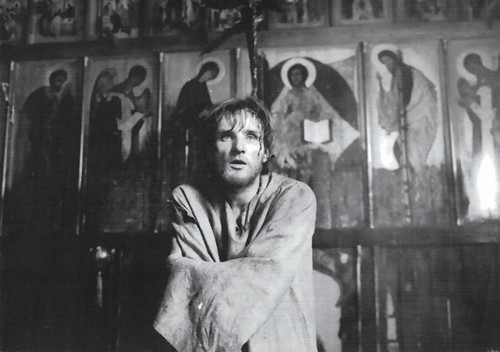
Italian card in the Sotto le stelle del Cinema series by Cineteca Bologna, 23 July 2020. Photo: Mosfilm. Anatoliy Solonitsyn in Andrei Rublev/Andrei Roublev (Andrei Tarkovsky, 1966).
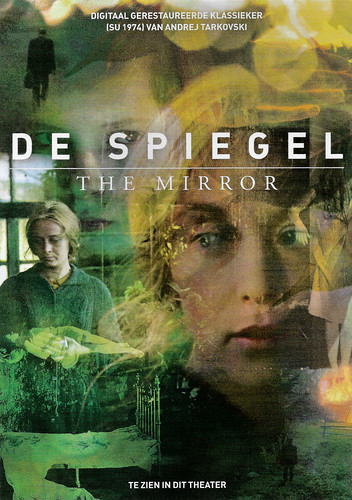
Dutch postcard by Eye. Dutch poster for Zerkalo/The Mirror (Andrei Tarkovsky, 1975). The title in Dutch is 'De spiegel'. Caption: Digitally restored classic (Sovet Union, 1974) of Andrei Tarkovsky.
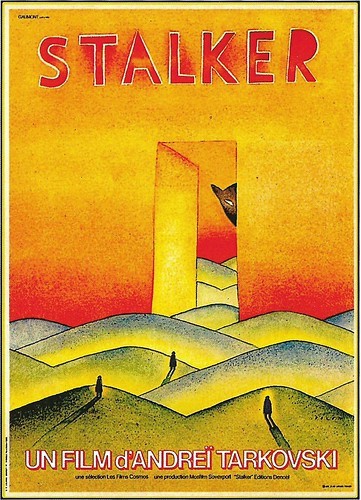
French postcard by Carterie artistique et cinématographique, Pont du Casse / ADAGP, Paris. French poster for Stalker (Andrei Tarkovsky, 1979). Design: Jean-Michel Folon. The film premiered in France on 18 November 1981.
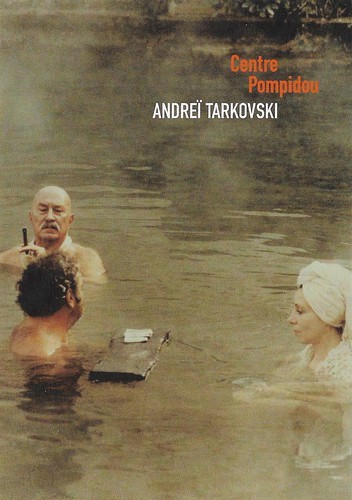
French postcard for the Andrei Tarkovsky retrospective at the Centre Pompidou, Paris, 9-27 October 2002. The card shows a still from Nostalghia (Andre Tarkovsky, 1982-1983), depicting the healing bath at Bagno Vignoni in Tuscany.
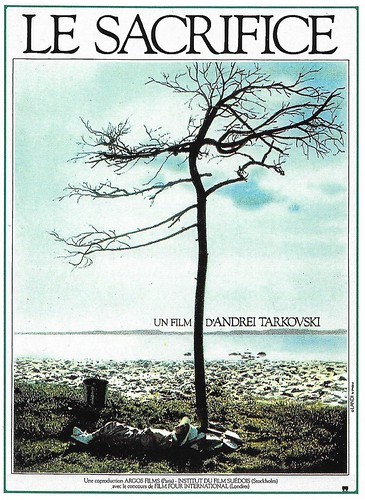
French postcard by Carterie artistique et cinématographique, Pont du Casse / ADAGP, Paris. French poster for Offret/The Sacrifice (Andrei Tarkovsky, 1986). Design: Michel Landi. The film was released in France on 14 May 1986.
Nikolai Grinko
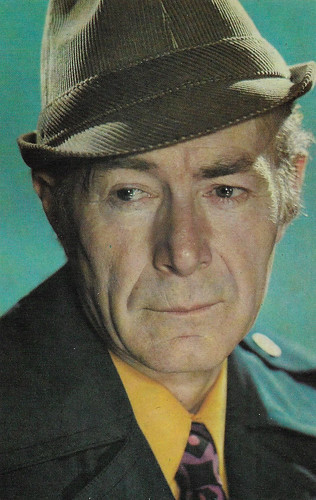
Soviet-Russian postcard by Leningradskoe otdenenie byuro propaganda sovetskogo kinoiskusstva. Photo:G. Ter-Ovanekova.
Nikolai Grigoryevich Grinko or Mykola Hryhorovych Hrynko (Микола Григорович Гринько or Никола́й Григо́рьевич Гринько́; 1920-1989) was a Soviet and Ukrainian actor, well known for his roles in the Soviet films of Andrei Tarkovsky, Ivanovo detstvo/Ivan's Childhood (1962), Andrei Rublev (1966), Solyaris/Solaris (1972), Zerkalo/The Mirror (1975), and Stalker (1979). Andrei Tarkovsky shot to international attention with his first feature, Ivanovo detstvo (1962), which won the top prize at the Venice Film Festival. This resulted in high expectations for his second feature, Andrei Rublev (1966), which was banned by the Soviet authorities for two years. It was shown at the 1969 Cannes Film Festival at four o'clock in the morning on the last day, in order to prevent it from winning a prize. It won an award nonetheless and was eventually distributed abroad partly to enable the authorities to save face.
Regimantas Adomaitis
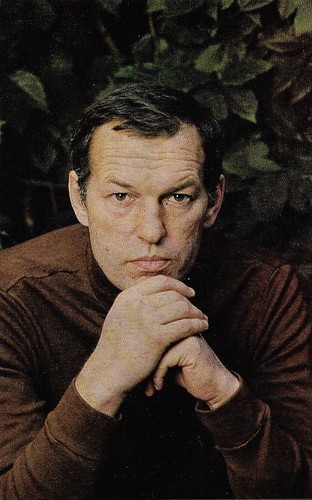
Soviet-Russian postcard. Photo: B. Plotnikova.
Lithuanian film and stage actor Regimantas Adomaitis (1937) played the title role of the Communist leader Lazo in the historical drama Sergey Lazo (Aleksandr Gordon, 1968), which was co-written by Andrei Tarkovsky, although he did not receive official credit for it.
Anatoli Solonitsyn
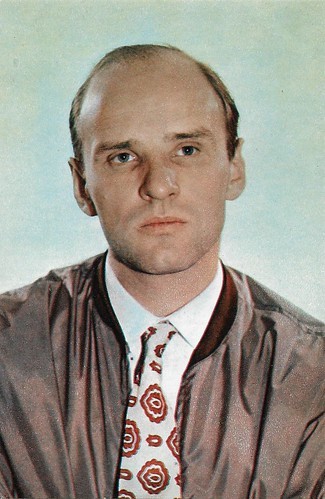
Soviet-Russian postcard.
Soviet and Russian actor Anatoly Solonitsyn (Анатолий Солоницын; 1934-1982) was 'discovered' by Tarkovsky in the casting process for Andrei Rublev (1966), in which he played the title role. Solonitsyn was an unknown provincial theater actor from Sverdlovsk at the time, but he took the opportunity to go to Moscow and try himself in the casting for the Andrei Rublev role. The historical consultant of the film saw the photos of actors from the casting, pointed to a photo of Solonitsyn, and said to Tarkovsky: "This one is Rublev". Solonitsyn later also played Dr. Sartorius in Solaris (1972), the physician in Zerkalo/The Mirror (1975), and the Writer in Stalker (1979).
In his book 'Sculpting in Time', Tarkovsky calls him his favourite actor and writes that Solonitsyn was also intended to play the lead roles in Nostalghia (1983) and The Sacrifice (1986), but the actor died before their production. Tarkovsky admired Solonitsyn's ability to fully embody the ideas of the director. When Tarkovsky was considering making a film adaptation of Dostoyevsky's famous novel 'The Idiot', Solonitsyn was even ready to do the plastic surgery to look more like the iconic Russian writer. Allegedly, according to Victor Sharun, the sound editor on Stalker, Solonitsyn, Tarkovsky, and Larisa Tarkovskaya became ill due to exposure to toxic chemicals during filming on the location of the film. Solonitsyn died from cancer in 1982, at the age of 47.
Ivan Lapikov
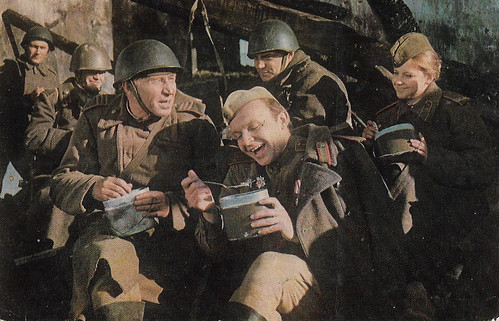
Soviet-Russian postcard by Byuro Propogandy Sovietskogo Kinoiskusstva, Leningrad, no. 107/73. The retail price was 8 kop. Ivan Lapikov and Andrey Myagkov in Nezhdannyy gost/The Unexpected Visitor (Vladimir Monakhov, 1972).
Ivan Lapikov (Иван Лапиков; 1922-1993) played the monk and icon painter Kirill in Andrei Rublev (Andrei Tarkovsky, 1966).
Donatas Banionis
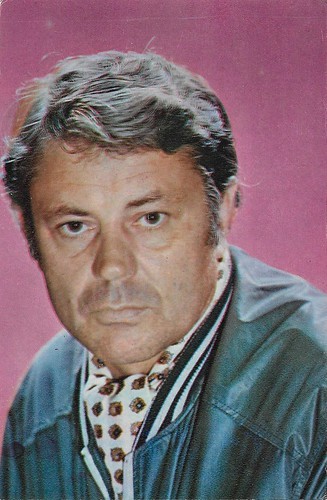
Soviet-Russian postcard, 1972.
Lithuanian and Soviet actor Donatas Banionis (1924-2014) played the lead role of Kris Kelvin in Solaris (1972), based on Stanislaw Lem’s novel. Kelvin, a psychologist, is sent to a space station placed in orbit around the planet Solaris, where the two surviving scientists of five (three committed suicide) tell him the ocean of the planet is capable to fulfill their wishes. Kelvin meets his dead wife Hari (Natalya Bondarchuk), tries to kill this phantom but fails to do so, and she becomes more and more real, even if lacking a memory. The phantoms prove to be the products of the planet, communicating with humans. In the end, Kelvin returns to Earth. Or is this Earth also a simulation?
Tarkovski thus stressed the limits of knowledge, the reality behind reality, and the subjectivity of perception. The film premiered at the 1972 Cannes film festival, won the Grand Prix Spécial du Jury, and was nominated for the Palme d'Or. It premiered in the Soviet Union in 1973. In 2002 a remake of the film was made by Steven Soderbergh, starring George Clooney. Dreading the making of this remake, in 2002 Salman Rushdie praised Tarkovski’s original as an “exploration of the unreliability of reality and the power of the human unconscious, the great examination of the limits of rationalism and the perverse power of even the most ill-fated love”.
Natalia Bondarchuk
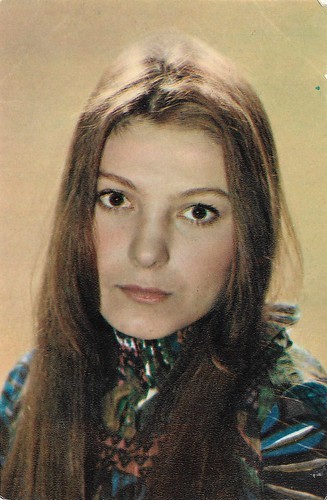
Soviet-Russian postcard. Bjuro propagandy sovetskogo kinoiskusstva. 1972.
Natalya Bondarchuk (Наталья Бондарчук, 1950) is a Soviet and Russian actress and film director. She is the daughter of the Ukrainian director and actor Sergei Bondarchuk. In Andrei Tarkovsky's remarkable Science-Fiction film Solaris (1972) she played Hari Kelvin. She was Tarkovsky's favourite of the film, as he wrote in his diary that "Natalya B. has outshone everybody". On the set of the film Kak zakalyalas stal/How the Steel Was Tempered (Nikolai Mashchenko, 1973) she met her future husband, actor Nikolai Burlyayev, who had worked with Tarkovsky too. He had been the principal actor in Tarkovsky's Ivanovo detstvo/Ivan's Childhood (1962) and also had a major part in Tarkovsky's Andrei Rublev (1966).
Margarita Terekhova
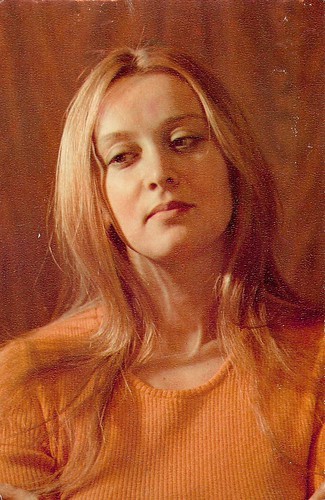
Soviet-Russian postcard. Photo: Bondareva, Caption on the back: "The Wonderful Artist of the RSFSR", 1978.
Margarita Terekhova (Маргари́та Те́рехова; 1942) played a dual role in Andrei Tarkovsky's film Zerkalo/The Mirror (1975) as the young Maria/Masha/Maroussia (Alexei's mother) and Natalia (Alexei's wife). Zerkalo is loosely autobiographical, unconventionally structured, and incorporates poems composed and read by the director's father, noted poet Arseny Tarkovsky. Mirror depicts the thoughts, emotions, and memories of Alexei, or Alyosha (Ignat Daniltsev), and the world around him as a child, adolescent, and forty-year-old. Mirror draws heavily on Tarkovsky's own childhood. Memories such as the evacuation from Moscow to the countryside during the war, a withdrawn father, and his own mother, who actually worked as a proofreader at a printing press, featured prominently. Its cinematography slips between color, black-and-white, and sepia. The film's loose flow of visually oneiric images has been compared with the stream of consciousness technique in modernist literature. Tarkovsky also directed Terekhova on stage as Gertrud in 'Hamlet' (1977).
Oleg Yankovsky
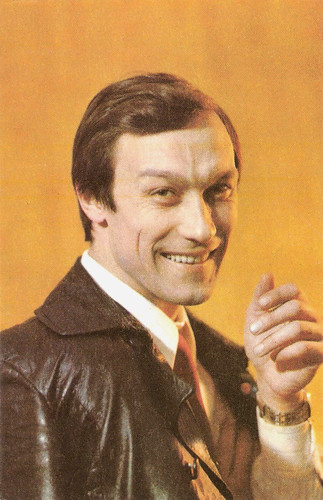
Russian postcard by Izdanije Byuro Propogandy Sovietskogo Kinoiskusstva, no. 2114221, 1977. This postcard was printed in an edition of 186.000 cards. The price was 6 kop.
Acclaimed Russian actor Oleg Yankovsky (1944-2009) excelled in psychologically sophisticated roles of modern intellectuals such as in two of Andrei Tarkovsky's most haunting and poetic films, Zerkalo/The Mirror (1975) as Alexei's father, and Nostalghia (1983) in the main role. In Nostalghia, Yankovsky plays a Russian writer who visits Italy to carry out research about an 18th-century Russian composer but is stricken by homesickness. The film uses autobiographical elements drawn from Tarkovsky's own experiences visiting Italy and explores themes surrounding the untranslatability of art and culture. Several scenes of the film were set in the countryside of Tuscany and northern Lazio; such as the Abbey of San Galgano, the spas of Bagno Vignoni, the Orcia Valley, in the Province of Siena, and the mysterious crypt of the Chiesa di San Pietro (Tuscania).
Erland Josephson
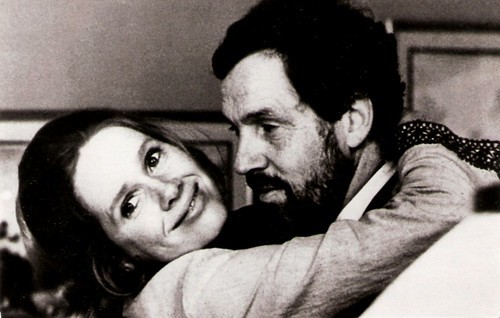
Vintage postcard. Liv Ullmann and Erland Josephson in Scener ur ett äktenskap/Scenes from a Marriage (Ingmar Bergman, 1973).
Swedish actor and author Erland Josephson (1923-2012) was best known for his work in films directed by Ingmar Bergman and Andrei Tarkovsky. He starred in Tarkovsky's last two films, Nostalghia (1983) and Offret/The Sacrifice (1986). The latter film was shot in Sweden with many of Ingmar Bergman's regular collaborators and won an almost unprecedented four prizes at the Cannes Film Festival. In Offret, Josephson played a middle-aged intellectual who attempts to bargain with God to stop an impending nuclear holocaust. It was Tarkovsky's final film, as he died shortly after its completion.
Sources: (IMDb), Wikipedia, and .

Italian card in the Sotto le stelle del Cinema series by Cineteca Bologna, 23 July 2020. Photo: Mosfilm. Anatoliy Solonitsyn in Andrei Rublev/Andrei Roublev (Andrei Tarkovsky, 1966).

Dutch postcard by Eye. Dutch poster for Zerkalo/The Mirror (Andrei Tarkovsky, 1975). The title in Dutch is 'De spiegel'. Caption: Digitally restored classic (Sovet Union, 1974) of Andrei Tarkovsky.

French postcard by Carterie artistique et cinématographique, Pont du Casse / ADAGP, Paris. French poster for Stalker (Andrei Tarkovsky, 1979). Design: Jean-Michel Folon. The film premiered in France on 18 November 1981.

French postcard for the Andrei Tarkovsky retrospective at the Centre Pompidou, Paris, 9-27 October 2002. The card shows a still from Nostalghia (Andre Tarkovsky, 1982-1983), depicting the healing bath at Bagno Vignoni in Tuscany.

French postcard by Carterie artistique et cinématographique, Pont du Casse / ADAGP, Paris. French poster for Offret/The Sacrifice (Andrei Tarkovsky, 1986). Design: Michel Landi. The film was released in France on 14 May 1986.
Nikolai Grinko

Soviet-Russian postcard by Leningradskoe otdenenie byuro propaganda sovetskogo kinoiskusstva. Photo:G. Ter-Ovanekova.
Nikolai Grigoryevich Grinko or Mykola Hryhorovych Hrynko (Микола Григорович Гринько or Никола́й Григо́рьевич Гринько́; 1920-1989) was a Soviet and Ukrainian actor, well known for his roles in the Soviet films of Andrei Tarkovsky, Ivanovo detstvo/Ivan's Childhood (1962), Andrei Rublev (1966), Solyaris/Solaris (1972), Zerkalo/The Mirror (1975), and Stalker (1979). Andrei Tarkovsky shot to international attention with his first feature, Ivanovo detstvo (1962), which won the top prize at the Venice Film Festival. This resulted in high expectations for his second feature, Andrei Rublev (1966), which was banned by the Soviet authorities for two years. It was shown at the 1969 Cannes Film Festival at four o'clock in the morning on the last day, in order to prevent it from winning a prize. It won an award nonetheless and was eventually distributed abroad partly to enable the authorities to save face.
Regimantas Adomaitis

Soviet-Russian postcard. Photo: B. Plotnikova.
Lithuanian film and stage actor Regimantas Adomaitis (1937) played the title role of the Communist leader Lazo in the historical drama Sergey Lazo (Aleksandr Gordon, 1968), which was co-written by Andrei Tarkovsky, although he did not receive official credit for it.
Anatoli Solonitsyn

Soviet-Russian postcard.
Soviet and Russian actor Anatoly Solonitsyn (Анатолий Солоницын; 1934-1982) was 'discovered' by Tarkovsky in the casting process for Andrei Rublev (1966), in which he played the title role. Solonitsyn was an unknown provincial theater actor from Sverdlovsk at the time, but he took the opportunity to go to Moscow and try himself in the casting for the Andrei Rublev role. The historical consultant of the film saw the photos of actors from the casting, pointed to a photo of Solonitsyn, and said to Tarkovsky: "This one is Rublev". Solonitsyn later also played Dr. Sartorius in Solaris (1972), the physician in Zerkalo/The Mirror (1975), and the Writer in Stalker (1979).
In his book 'Sculpting in Time', Tarkovsky calls him his favourite actor and writes that Solonitsyn was also intended to play the lead roles in Nostalghia (1983) and The Sacrifice (1986), but the actor died before their production. Tarkovsky admired Solonitsyn's ability to fully embody the ideas of the director. When Tarkovsky was considering making a film adaptation of Dostoyevsky's famous novel 'The Idiot', Solonitsyn was even ready to do the plastic surgery to look more like the iconic Russian writer. Allegedly, according to Victor Sharun, the sound editor on Stalker, Solonitsyn, Tarkovsky, and Larisa Tarkovskaya became ill due to exposure to toxic chemicals during filming on the location of the film. Solonitsyn died from cancer in 1982, at the age of 47.
Ivan Lapikov

Soviet-Russian postcard by Byuro Propogandy Sovietskogo Kinoiskusstva, Leningrad, no. 107/73. The retail price was 8 kop. Ivan Lapikov and Andrey Myagkov in Nezhdannyy gost/The Unexpected Visitor (Vladimir Monakhov, 1972).
Ivan Lapikov (Иван Лапиков; 1922-1993) played the monk and icon painter Kirill in Andrei Rublev (Andrei Tarkovsky, 1966).
Donatas Banionis

Soviet-Russian postcard, 1972.
Lithuanian and Soviet actor Donatas Banionis (1924-2014) played the lead role of Kris Kelvin in Solaris (1972), based on Stanislaw Lem’s novel. Kelvin, a psychologist, is sent to a space station placed in orbit around the planet Solaris, where the two surviving scientists of five (three committed suicide) tell him the ocean of the planet is capable to fulfill their wishes. Kelvin meets his dead wife Hari (Natalya Bondarchuk), tries to kill this phantom but fails to do so, and she becomes more and more real, even if lacking a memory. The phantoms prove to be the products of the planet, communicating with humans. In the end, Kelvin returns to Earth. Or is this Earth also a simulation?
Tarkovski thus stressed the limits of knowledge, the reality behind reality, and the subjectivity of perception. The film premiered at the 1972 Cannes film festival, won the Grand Prix Spécial du Jury, and was nominated for the Palme d'Or. It premiered in the Soviet Union in 1973. In 2002 a remake of the film was made by Steven Soderbergh, starring George Clooney. Dreading the making of this remake, in 2002 Salman Rushdie praised Tarkovski’s original as an “exploration of the unreliability of reality and the power of the human unconscious, the great examination of the limits of rationalism and the perverse power of even the most ill-fated love”.
Natalia Bondarchuk

Soviet-Russian postcard. Bjuro propagandy sovetskogo kinoiskusstva. 1972.
Natalya Bondarchuk (Наталья Бондарчук, 1950) is a Soviet and Russian actress and film director. She is the daughter of the Ukrainian director and actor Sergei Bondarchuk. In Andrei Tarkovsky's remarkable Science-Fiction film Solaris (1972) she played Hari Kelvin. She was Tarkovsky's favourite of the film, as he wrote in his diary that "Natalya B. has outshone everybody". On the set of the film Kak zakalyalas stal/How the Steel Was Tempered (Nikolai Mashchenko, 1973) she met her future husband, actor Nikolai Burlyayev, who had worked with Tarkovsky too. He had been the principal actor in Tarkovsky's Ivanovo detstvo/Ivan's Childhood (1962) and also had a major part in Tarkovsky's Andrei Rublev (1966).
Margarita Terekhova

Soviet-Russian postcard. Photo: Bondareva, Caption on the back: "The Wonderful Artist of the RSFSR", 1978.
Margarita Terekhova (Маргари́та Те́рехова; 1942) played a dual role in Andrei Tarkovsky's film Zerkalo/The Mirror (1975) as the young Maria/Masha/Maroussia (Alexei's mother) and Natalia (Alexei's wife). Zerkalo is loosely autobiographical, unconventionally structured, and incorporates poems composed and read by the director's father, noted poet Arseny Tarkovsky. Mirror depicts the thoughts, emotions, and memories of Alexei, or Alyosha (Ignat Daniltsev), and the world around him as a child, adolescent, and forty-year-old. Mirror draws heavily on Tarkovsky's own childhood. Memories such as the evacuation from Moscow to the countryside during the war, a withdrawn father, and his own mother, who actually worked as a proofreader at a printing press, featured prominently. Its cinematography slips between color, black-and-white, and sepia. The film's loose flow of visually oneiric images has been compared with the stream of consciousness technique in modernist literature. Tarkovsky also directed Terekhova on stage as Gertrud in 'Hamlet' (1977).
Oleg Yankovsky

Russian postcard by Izdanije Byuro Propogandy Sovietskogo Kinoiskusstva, no. 2114221, 1977. This postcard was printed in an edition of 186.000 cards. The price was 6 kop.
Acclaimed Russian actor Oleg Yankovsky (1944-2009) excelled in psychologically sophisticated roles of modern intellectuals such as in two of Andrei Tarkovsky's most haunting and poetic films, Zerkalo/The Mirror (1975) as Alexei's father, and Nostalghia (1983) in the main role. In Nostalghia, Yankovsky plays a Russian writer who visits Italy to carry out research about an 18th-century Russian composer but is stricken by homesickness. The film uses autobiographical elements drawn from Tarkovsky's own experiences visiting Italy and explores themes surrounding the untranslatability of art and culture. Several scenes of the film were set in the countryside of Tuscany and northern Lazio; such as the Abbey of San Galgano, the spas of Bagno Vignoni, the Orcia Valley, in the Province of Siena, and the mysterious crypt of the Chiesa di San Pietro (Tuscania).
Erland Josephson

Vintage postcard. Liv Ullmann and Erland Josephson in Scener ur ett äktenskap/Scenes from a Marriage (Ingmar Bergman, 1973).
Swedish actor and author Erland Josephson (1923-2012) was best known for his work in films directed by Ingmar Bergman and Andrei Tarkovsky. He starred in Tarkovsky's last two films, Nostalghia (1983) and Offret/The Sacrifice (1986). The latter film was shot in Sweden with many of Ingmar Bergman's regular collaborators and won an almost unprecedented four prizes at the Cannes Film Festival. In Offret, Josephson played a middle-aged intellectual who attempts to bargain with God to stop an impending nuclear holocaust. It was Tarkovsky's final film, as he died shortly after its completion.
Sources: (IMDb), Wikipedia, and .
Published on September 18, 2021 22:00
September 17, 2021
W.J. Morlins
W.J. Morlins was a German publisher located in Berlin which operated in the early 1920s. Mörlins published autobiographies of the actors Bruno Kastner ('Von mir über mir', 1921) and Hella Moja ('Nie wieder in meinem Leben!', 1921), as well as deluxe albums of the four-part film Fridericus Rex (1921-1922). In this post, we present film star postcards of four Morlins series which were distributed by Ross Verlag. The earliest series in our collection (no. 420-430) are sepia-tinted star portraits. A highlight is a series, no. 647, with postcards of the popular Fridericus Rex series (1921-1922) with the main actors in costume. Fridericus Rex is also the subject of the postcards of no. 651, but now with film stills in sepia. Then followed a green-tinted series (no. 8001 - 9011) with film star portraits. Remarkable is that every picture in this post was taken by master photographer Karl Schenker.

German postcard by Verlag Ross / W.J. Mörlins, Berlin, no. 420/1, 1919-1924. Photo: Karl Schenker.
Max Pallenberg (1877-1934) was an Austrian singer, actor, and comedian. He was one of the most important comedians of his time and often played under the direction of Max Reinhardt. Although Pallenberg was successful as a stage comedian, he only incidentally accepted roles in films.
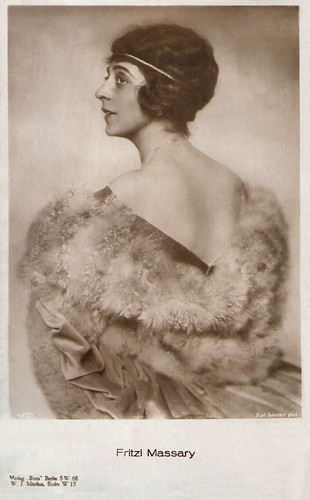
German postcard by Ross Verlag / W.J. Morlins, Berlin, no. 427/1, 1919-1924. Photo: Karl Schenker.
Austrian-American soprano singer and actress Fritzi Massary (1882-1969) was one of the greatest 20th-century operetta divas. She was a superstar in Berlin and Vienna in the Weimar era, but after the rise of the Nazis, Massary was forced to flee Germany. In London, she appeared in an operetta Noel Coward wrote for her. The popular singer also starred in several early German ‘sound pictures’ and other silent films.
Fridericus Rex
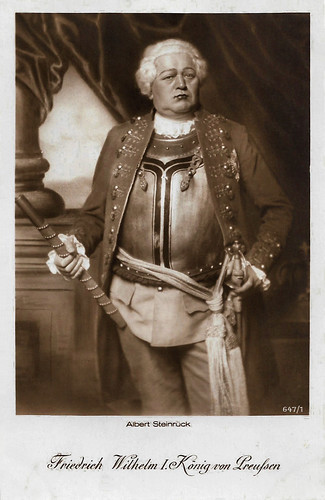
German postcard by W.J. Morlins, Berlin / Ross Verlag, Berlin, no. 647/ 1. Photo: Karl Schenker / Cserépy-Film Co. Albert Steinrück as Friedrich Wilhelm I, King of Prussia, the father of Frederick the Great, in Fridericus Rex (Arzén von Cserépy, 1921-1922).
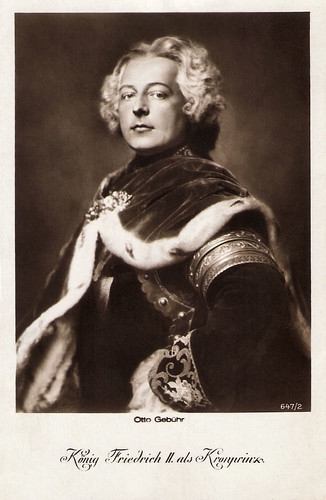
German postcard by W.J. Morlins, Berlin / Ross Verlag, Berlin, no. 647/2. Photo: Karl Schenker / Cserépy Film Co. Otto Gebühr as Crown Prince King Frederick II in Fridericus Rex (Arzén von Cserépy, 1921). Fridericus Rex was a four-part series with Otto Gebühr as King Frederick II as Crown Prince in part I and II.
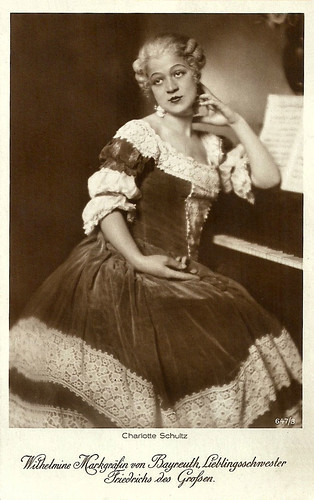
German postcard by W.J. Morlins, Berlin / Ross Verlag, Berlin, no. 647/3. Photo: Karl Schenker / Cserépy Film Co. Charlotte Schulz as Wilhelmine, Marchioness of Bayreuth, favourite sister of Frederick the Great, in Fridericus Rex (Arzén von Cserépy, 1921-1922).
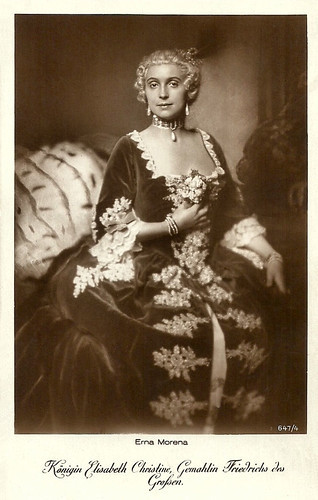
German postcard by W.J. Morlins, Berlin / Ross Verlag, Berlin, no. 647/4. Photo: Karl Schenker / Cserépy Film Co. Erna Morena as Queen Elisabeth Christine, spouse of Frederick the Great, in Fridericus Rex (Arzén von Cserépy, 1921-1922).
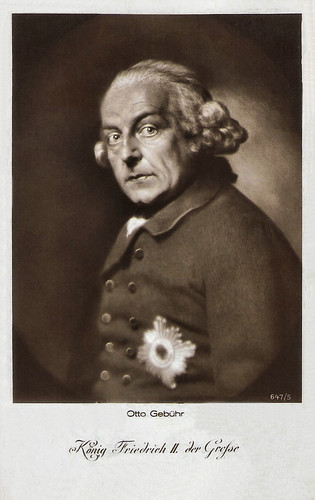
German postcard by W.J. Morlins, Berlin / Ross Verlag, Berlin, no. 647/5. Photo: Karl Schenker / Cserépy-Film Co. Otto Gebühr as King Frederick the Great in Fridericus Rex (Arzen von Cserépy, 1921-1922).
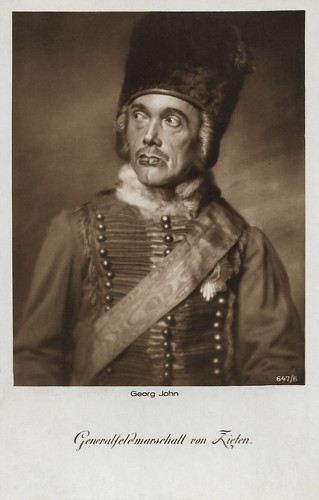
German postcard by W.J. Morlins, Berlin / Ross Verlag, Berlin, no. 647/6. Photo: Karl Schenker / Cserépy-Film Co. Georg John as Generalfeldmarschall von Zieten (Field Marshal von Zieten) in Fridericus Rex (Arzén von Cserépy, 1921-1922).
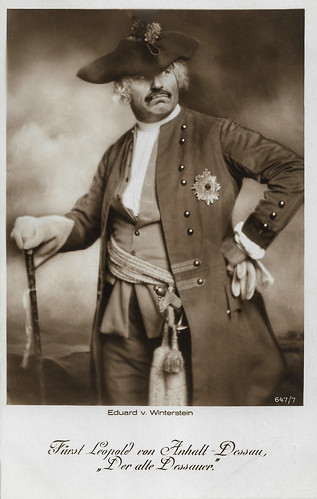
German postcard by W.J. Morlins, Berlin / Ross Verlag, Berlin, no. 647/7. Photo: Karl Schenker / Cserépy-Film Co. Eduard von Winterstein as Leopold I, Prince of Anhalt-Dessau in Fridericus Rex (Arzén von Cserépy, 1921-1922). Caption: Fürst Leopold von Anhalt-Dessau, "Der alte Dessauer" (Leopold I, Prince of Anhalt-Dessau, "the old Dessauer").
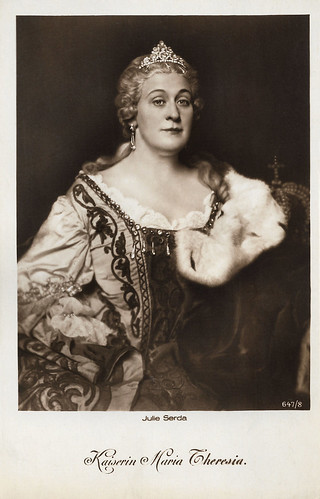
German postcard by W.J. Morlins, Berlin / Ross Verlag, Berlin, no. 647/8. Photo: Karl Schenker / Cserépy-Film Co. Julia (here: Julie) Serda as the Empress Maria Theresia of Austria in Fridericus Rex (Arzén von Cserépy, 1922), starring Otto Gebühr.
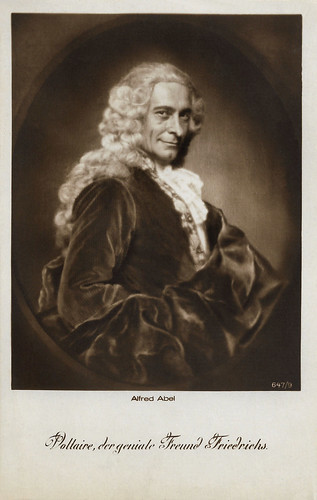
German postcard by W.J. Morlins, Berlin / Ross Verlag, Berlin, no. 647/9. Photo: Karl Schenker / Cserépy Film Co. Alfred Abel as 'Voltaire, the genial friend of Frederick [the Great]' in the Fridericus Rex trilogy (Arzén von Cserépy, 1921-1922). NB Alfred Abel is not listed as playing Voltaire in any of the Frederick the Great films, but the back of this postcard states this is the case.
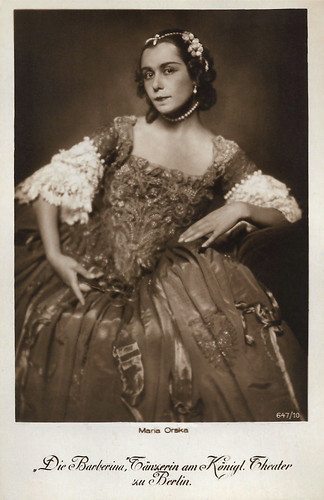
German postcard by W.J. Morlins, Berlin / Ross Verlag, Berlin, no. 647/10. Photo: Karl Schenker / Cserépy-Film Co. Maria Orska as the dancer Barberina of the Royal Theater in Berlin in Fridericus Rex (Arzén von Cserépy, 1922).
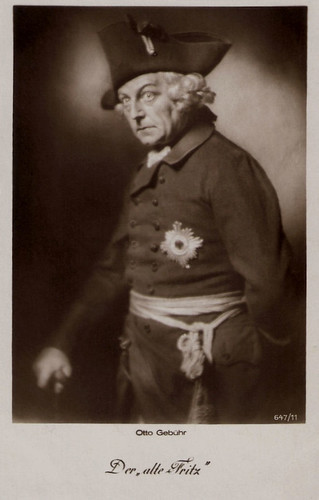
German postcard by W.J. Morlins, Berlin / Ross Verlag, Berlin, no. 647/11. Photo: Karl Schenker / Cserépy-Film Co. Otto Gebühr as Friedrich II in Der Alte Fritz/The Old Fritz (Gerhard Lamprecht, 1928).
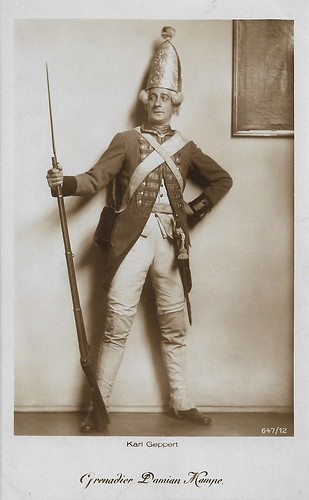
German postcard by W.J. Morlins, Berlin / Ross Verlag, Berlin, no. 647/12. Photo: Karl Schenker / Cserépy-Film Co. Karl Geppert as the grenadier Damian Mampe in Fridericus Rex (Arzén von Cserépy, 1922).
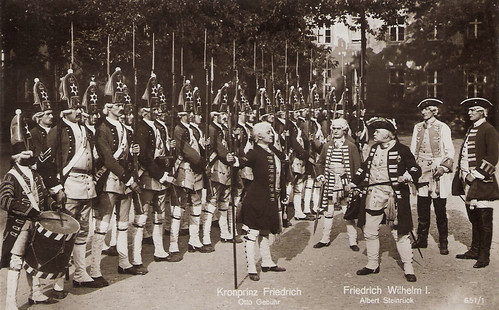
German postcard by W.J. Morlins, Berlin / Ross Verlag, Berlin, no. 651/1. Photo: Karl Schenker / Cserépy-Film Co. Otto Gebühr as crownprince Friedrich (Frederick, the future Frederick the Great), and Albert Steinrück as his father Friedrich Wilhelm I in the Fridericus Rex series (Arzén von Cserépy, 1921-1922).
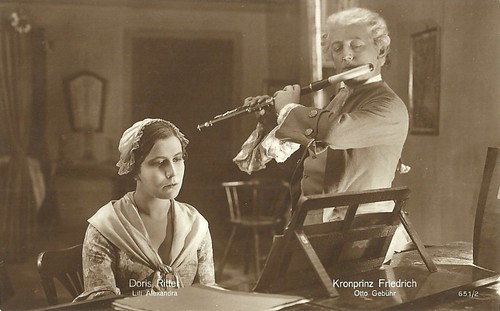
German postcard by W.J. Morlins, Berlin / Ross Verlag, no. 651/2. Otto Gebühr as crown prince Frederick (future Frederick II) and Lili Alexander as Doris Ritter in Fridericus Rex (Arzén von Cserépy, 1921-1922).
The green series
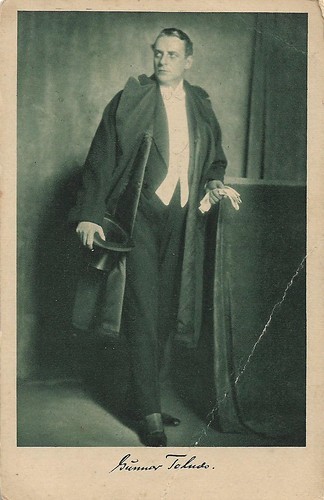
German postcard by Verlag W.J. Mörlins, Berlin / Vertrieb Ross-Verlag, Berlin, no. 9001/1. Photo: Karl Schenker.
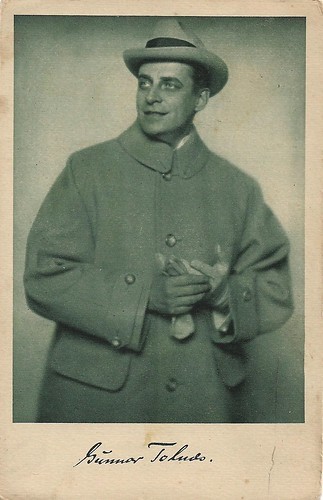
German postcard by Verlag W.J. Mörlins, Berlin / Vertrieb Ross-Verlag, Berlin, no. 9001/2. Photo: Karl Schenker.
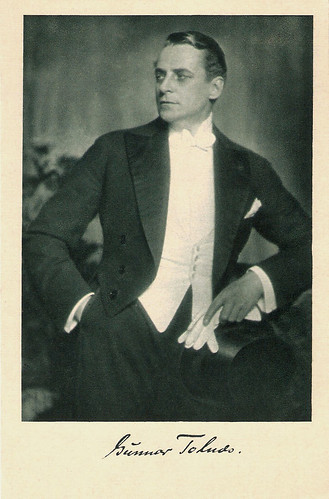
German postcard by Verlag W.J. Mörlins, Berlin / Vertrieb Ross-Verlag, Berlin, no. 9001/3. Photo: Karl Schenker.
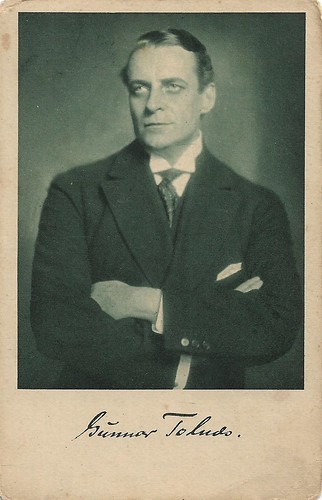
German postcard by Verlag W.J. Mörlins, Berlin / Vertrieb Ross-Verlag, Berlin, no. 9001/4. Photo: Karl Schenker.
Gunnar Tolnaes (1879-1940) had his most famous performance as an Indian prince in the Danish orientalist melodrama Maharadjahens Yndlingshustru/The Maharaja's Favourite Wife (1917), with Lilly Jacobson. It was so popular that it had a Danish sequel in 1919 and a German sequel in 1921. After a substantial film career in Denmark, he alternated acting in German films as well as in Danish films, until the end of the silent era.
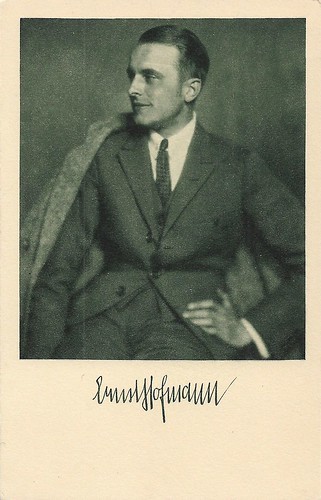
German postcard by Verlag W.J. Mörlins / Ross Verlag, Berlin, no. 9007/3. Photo: Karl Schenker.
German actor Ernst Hofmann (1890-1944) was one of the most attractive actors of German silent cinema. in the 1910s He was the producer and star of Der Knabe in Blau (1918), the first film by legendary director Friedrich Wilhelm Murnau.
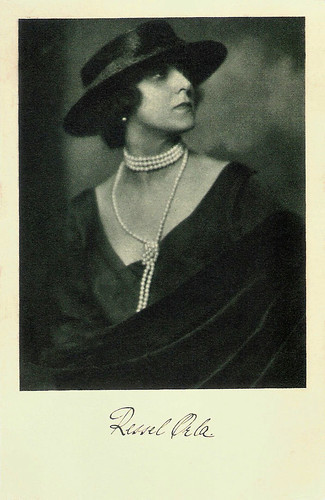
German postcard by Verlag W.J. Mörlins / Ross Verlag, Berlin, no. 9010/2. Photo: Karl Schenker.
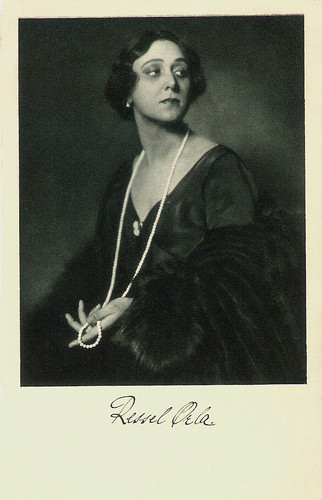
German postcard by Verlag W.J. Mörlins / Ross Verlag, Berlin, no. 9010/3. Photo: Karl Schenker.
Ressel Orla (1889-1931) was an actress of the German silent film who peaked in the late 1910s and early 1920s.
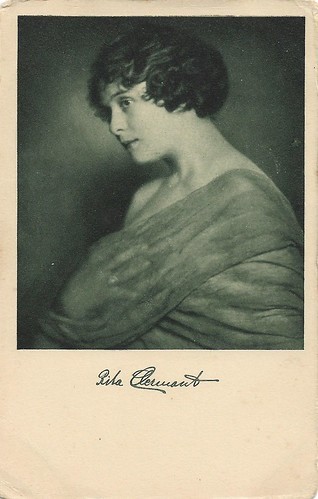
German postcard by Verlag W.J. Mörlins / Ross Verlag, Berlin, no. 9011/1. (With the logo of Rotophot). Photo: Karl Schenker.
Rita Clermont (1894-1969) was a German film actress of the silent era.
Source: Ross Verlag Postcards. And please check out our post on Karl Schenker and his Atelier Schenker.

German postcard by Verlag Ross / W.J. Mörlins, Berlin, no. 420/1, 1919-1924. Photo: Karl Schenker.
Max Pallenberg (1877-1934) was an Austrian singer, actor, and comedian. He was one of the most important comedians of his time and often played under the direction of Max Reinhardt. Although Pallenberg was successful as a stage comedian, he only incidentally accepted roles in films.

German postcard by Ross Verlag / W.J. Morlins, Berlin, no. 427/1, 1919-1924. Photo: Karl Schenker.
Austrian-American soprano singer and actress Fritzi Massary (1882-1969) was one of the greatest 20th-century operetta divas. She was a superstar in Berlin and Vienna in the Weimar era, but after the rise of the Nazis, Massary was forced to flee Germany. In London, she appeared in an operetta Noel Coward wrote for her. The popular singer also starred in several early German ‘sound pictures’ and other silent films.
Fridericus Rex

German postcard by W.J. Morlins, Berlin / Ross Verlag, Berlin, no. 647/ 1. Photo: Karl Schenker / Cserépy-Film Co. Albert Steinrück as Friedrich Wilhelm I, King of Prussia, the father of Frederick the Great, in Fridericus Rex (Arzén von Cserépy, 1921-1922).

German postcard by W.J. Morlins, Berlin / Ross Verlag, Berlin, no. 647/2. Photo: Karl Schenker / Cserépy Film Co. Otto Gebühr as Crown Prince King Frederick II in Fridericus Rex (Arzén von Cserépy, 1921). Fridericus Rex was a four-part series with Otto Gebühr as King Frederick II as Crown Prince in part I and II.

German postcard by W.J. Morlins, Berlin / Ross Verlag, Berlin, no. 647/3. Photo: Karl Schenker / Cserépy Film Co. Charlotte Schulz as Wilhelmine, Marchioness of Bayreuth, favourite sister of Frederick the Great, in Fridericus Rex (Arzén von Cserépy, 1921-1922).

German postcard by W.J. Morlins, Berlin / Ross Verlag, Berlin, no. 647/4. Photo: Karl Schenker / Cserépy Film Co. Erna Morena as Queen Elisabeth Christine, spouse of Frederick the Great, in Fridericus Rex (Arzén von Cserépy, 1921-1922).

German postcard by W.J. Morlins, Berlin / Ross Verlag, Berlin, no. 647/5. Photo: Karl Schenker / Cserépy-Film Co. Otto Gebühr as King Frederick the Great in Fridericus Rex (Arzen von Cserépy, 1921-1922).

German postcard by W.J. Morlins, Berlin / Ross Verlag, Berlin, no. 647/6. Photo: Karl Schenker / Cserépy-Film Co. Georg John as Generalfeldmarschall von Zieten (Field Marshal von Zieten) in Fridericus Rex (Arzén von Cserépy, 1921-1922).

German postcard by W.J. Morlins, Berlin / Ross Verlag, Berlin, no. 647/7. Photo: Karl Schenker / Cserépy-Film Co. Eduard von Winterstein as Leopold I, Prince of Anhalt-Dessau in Fridericus Rex (Arzén von Cserépy, 1921-1922). Caption: Fürst Leopold von Anhalt-Dessau, "Der alte Dessauer" (Leopold I, Prince of Anhalt-Dessau, "the old Dessauer").

German postcard by W.J. Morlins, Berlin / Ross Verlag, Berlin, no. 647/8. Photo: Karl Schenker / Cserépy-Film Co. Julia (here: Julie) Serda as the Empress Maria Theresia of Austria in Fridericus Rex (Arzén von Cserépy, 1922), starring Otto Gebühr.

German postcard by W.J. Morlins, Berlin / Ross Verlag, Berlin, no. 647/9. Photo: Karl Schenker / Cserépy Film Co. Alfred Abel as 'Voltaire, the genial friend of Frederick [the Great]' in the Fridericus Rex trilogy (Arzén von Cserépy, 1921-1922). NB Alfred Abel is not listed as playing Voltaire in any of the Frederick the Great films, but the back of this postcard states this is the case.

German postcard by W.J. Morlins, Berlin / Ross Verlag, Berlin, no. 647/10. Photo: Karl Schenker / Cserépy-Film Co. Maria Orska as the dancer Barberina of the Royal Theater in Berlin in Fridericus Rex (Arzén von Cserépy, 1922).

German postcard by W.J. Morlins, Berlin / Ross Verlag, Berlin, no. 647/11. Photo: Karl Schenker / Cserépy-Film Co. Otto Gebühr as Friedrich II in Der Alte Fritz/The Old Fritz (Gerhard Lamprecht, 1928).

German postcard by W.J. Morlins, Berlin / Ross Verlag, Berlin, no. 647/12. Photo: Karl Schenker / Cserépy-Film Co. Karl Geppert as the grenadier Damian Mampe in Fridericus Rex (Arzén von Cserépy, 1922).

German postcard by W.J. Morlins, Berlin / Ross Verlag, Berlin, no. 651/1. Photo: Karl Schenker / Cserépy-Film Co. Otto Gebühr as crownprince Friedrich (Frederick, the future Frederick the Great), and Albert Steinrück as his father Friedrich Wilhelm I in the Fridericus Rex series (Arzén von Cserépy, 1921-1922).

German postcard by W.J. Morlins, Berlin / Ross Verlag, no. 651/2. Otto Gebühr as crown prince Frederick (future Frederick II) and Lili Alexander as Doris Ritter in Fridericus Rex (Arzén von Cserépy, 1921-1922).
The green series

German postcard by Verlag W.J. Mörlins, Berlin / Vertrieb Ross-Verlag, Berlin, no. 9001/1. Photo: Karl Schenker.

German postcard by Verlag W.J. Mörlins, Berlin / Vertrieb Ross-Verlag, Berlin, no. 9001/2. Photo: Karl Schenker.

German postcard by Verlag W.J. Mörlins, Berlin / Vertrieb Ross-Verlag, Berlin, no. 9001/3. Photo: Karl Schenker.

German postcard by Verlag W.J. Mörlins, Berlin / Vertrieb Ross-Verlag, Berlin, no. 9001/4. Photo: Karl Schenker.
Gunnar Tolnaes (1879-1940) had his most famous performance as an Indian prince in the Danish orientalist melodrama Maharadjahens Yndlingshustru/The Maharaja's Favourite Wife (1917), with Lilly Jacobson. It was so popular that it had a Danish sequel in 1919 and a German sequel in 1921. After a substantial film career in Denmark, he alternated acting in German films as well as in Danish films, until the end of the silent era.

German postcard by Verlag W.J. Mörlins / Ross Verlag, Berlin, no. 9007/3. Photo: Karl Schenker.
German actor Ernst Hofmann (1890-1944) was one of the most attractive actors of German silent cinema. in the 1910s He was the producer and star of Der Knabe in Blau (1918), the first film by legendary director Friedrich Wilhelm Murnau.

German postcard by Verlag W.J. Mörlins / Ross Verlag, Berlin, no. 9010/2. Photo: Karl Schenker.

German postcard by Verlag W.J. Mörlins / Ross Verlag, Berlin, no. 9010/3. Photo: Karl Schenker.
Ressel Orla (1889-1931) was an actress of the German silent film who peaked in the late 1910s and early 1920s.

German postcard by Verlag W.J. Mörlins / Ross Verlag, Berlin, no. 9011/1. (With the logo of Rotophot). Photo: Karl Schenker.
Rita Clermont (1894-1969) was a German film actress of the silent era.
Source: Ross Verlag Postcards. And please check out our post on Karl Schenker and his Atelier Schenker.
Published on September 17, 2021 22:00
Paul van Yperen's Blog
- Paul van Yperen's profile
- 13 followers
Paul van Yperen isn't a Goodreads Author
(yet),
but they
do have a blog,
so here are some recent posts imported from
their feed.



